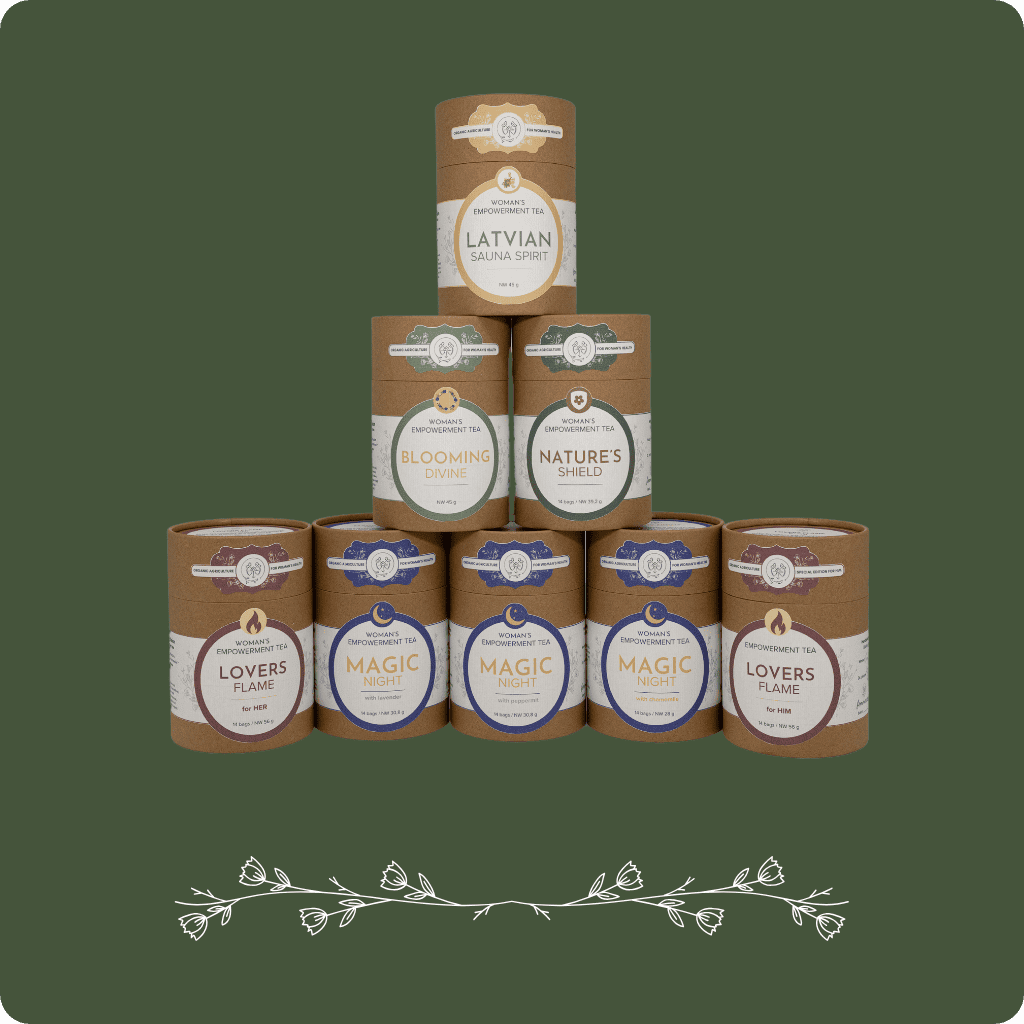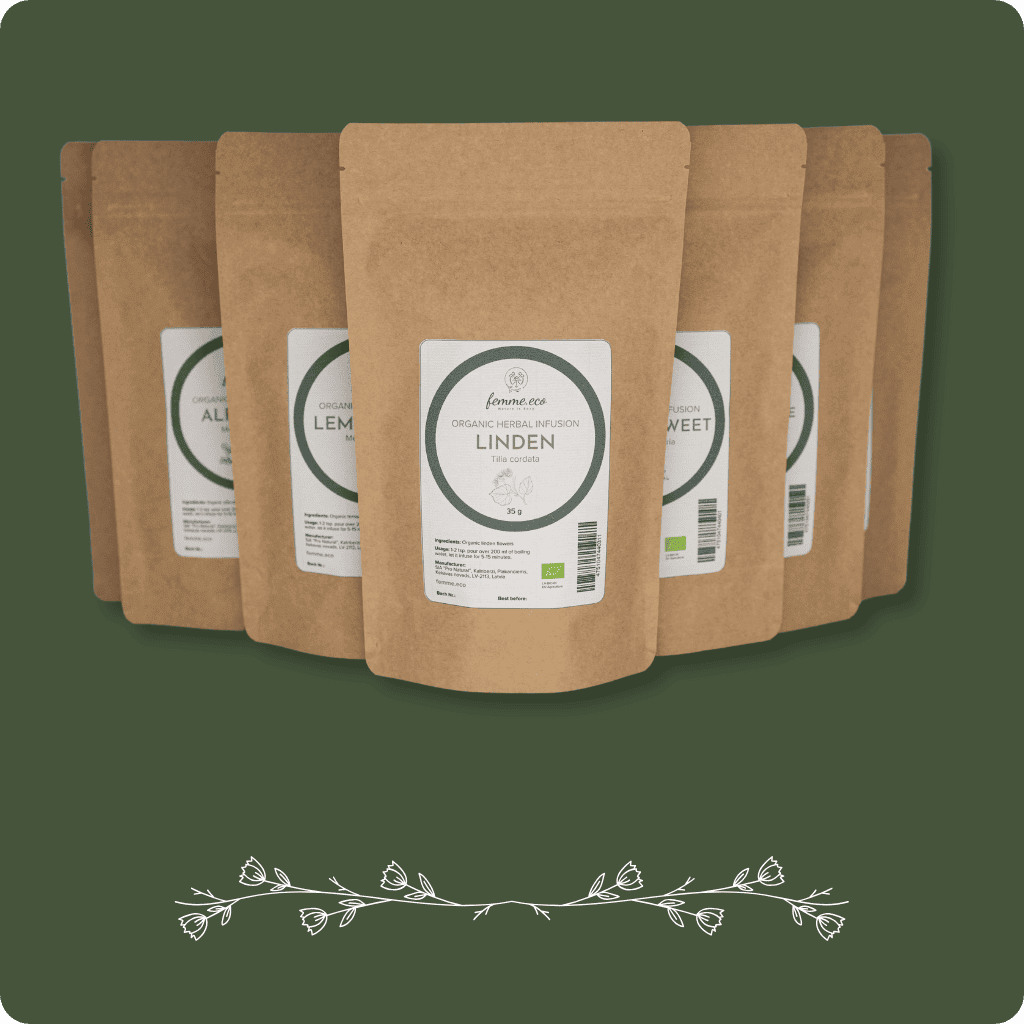Our herbs ethno-pharmacology
Explore the evidence behind the herbs we use to support women's reproductive health and wellness.
ALFA-ALFA ANGELICA APPLE MINT APPLES BEETROOT BIRCH BLACKCURRANT CALENDULA CARAWAY CAYENNE PEPPER CHAMOMILE DAMIANA DANDELION DRAGONHEAD ECHINACEA ELDER FENNEL GINGER HOP KOREAN MINT LADY'S MANTLE LAVENDER LEMON BALM LEMON VERBENA LINDEN MALLOW MEADOWSWEET MOTHERWORT NETTLE OAT OREGANO PARSLEY PEPPERMINT QUINCE RASPBERRY RED CLOVER RHODIOLA RHUBARB ROSES SAGE SCHISANDRA SEA BUCKTHORN SPEARMINT ST. JOHN'S WORT STRAWBERRY VITEX YARROW
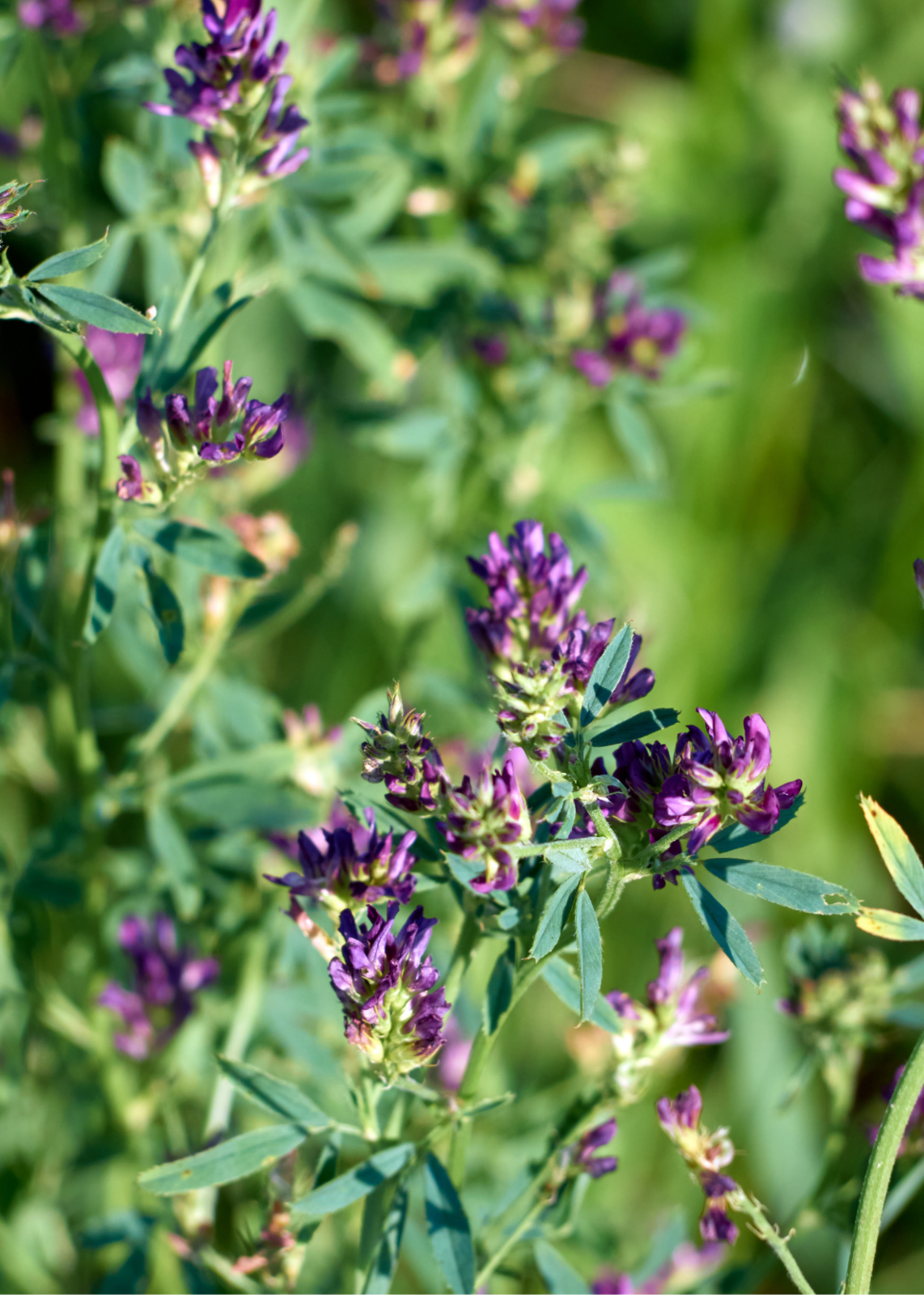
Alfa - Alfa
Medicago sativa (Fabaceae)
Alfa-alfa, or lucerne, is a nutrient-rich plant that provides a wide range of beneficial effects on the human body, thanks to its high content of vitamins, minerals and antioxidants. Alfa-alfa supports overall health, improves digestion, helps reduce cholesterol levels and strengthens immunity. It is especially useful for women's health, as the phytoestrogens - substances that mimic the hormone estrogen in the body - help balance hormones, regulate the menstrual cycle, and reduce menopausal symptoms, such as hot flashes and sweating. In addition, its iron and chlorophyll content promotes the process of blood formation and fights fatigue, especially important for women during menstruation.
Health benefits: woman's cycle, menopause, valuable source of minerals and vitamins, digestion.
Chemical compounds: alfa-alfa herb contain vitamins (C, K, E, B group vit.), minerals (Ca, Mg, K, Fe), saponins, coumarins, phytoestrogens, chlorophyll, fiber.
Herbal action: estrogenic, anti-inflammatory, antioxidant, digestive, diuretic, body-strengthening effect.- Romm, A. (2017). Botanical Medicine for Women's Health (2nd ed.). St. Louis, MO: Elsevier
- Dietz BM, Hajirahimkhan A, Dunlap TL, Bolton JL. Botanicals and Their Bioactive Phytochemicals for Women's Health. Pharmacol Rev. 2016 Oct;68(4):1026-1073. doi: 10.1124/pr.115.010843. PMID: 27677719; PMCID: PMC5050441.
- Kargozar R, Azizi H, Salari R. A review of effective herbal medicines in controlling menopausal symptoms. Electron Physician. 2017 Nov 25;9(11):5826-5833. doi: 10.19082/5826. PMID: 29403626; PMCID: PMC5783135.
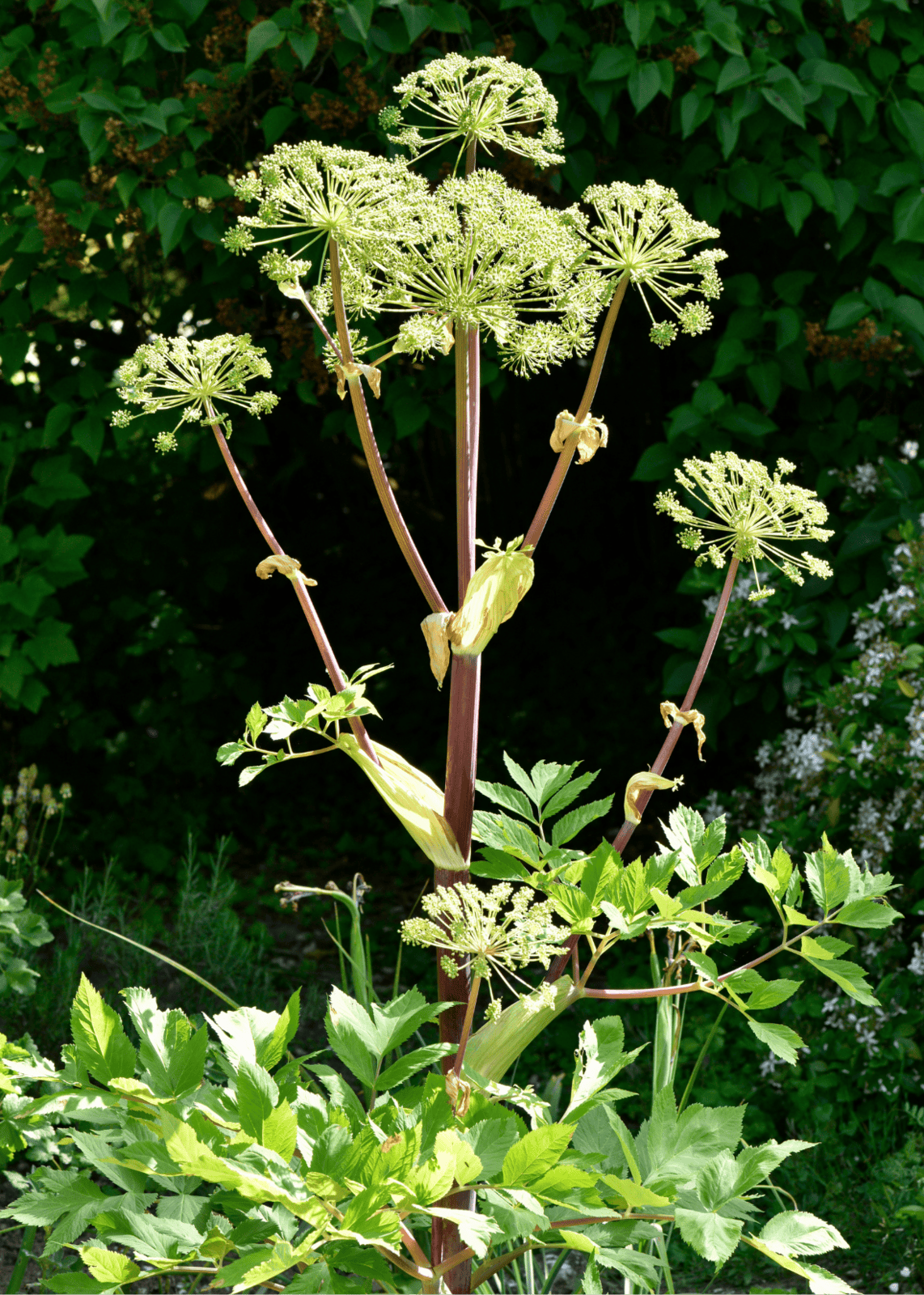
Angelica
Angelica archangelica (Apiaceae)
Angelica is traditionally used to support digestive, respiratory, and circulatory health. It stimulates appetite, improves digestion, and relieves bloating and flatulence. In respiratory health, angelica serves as an expectorant during colds. Additionally, it is known for its circulation-enhancing properties, promoting blood flow and reducing tension, making it effective for poor circulation and mild anxiety. In traditional medicine, angelica is also used to support women’s reproductive health, including relieving menstrual cramps and improving pelvic blood circulation.
Health benefits: women’s cycle, digestion, respiratory health.
Chemical compounds: the roots contain essential oil, coumarins, flavonoids, phenolic acids, and polysaccharides.
Herbal action: digestion-enhancing, circulation-stimulating, spasmolytic, anti-inflammatory, antibacterial, calming, and immune-boosting effects.- ESCOP. (2003). Angelicae Radix – Angelica Root: ESCOP Monographs. The Scientific Foundation for Herbal Medicinal Products (2nd ed.). Exeter, UK: European Scientific Cooperative on Phytotherapy
- Romm, A. (2017). Botanical Medicine for Women's Health (2nd ed.). St. Louis, MO: Elsevier.
- Blumenthal, M., Goldberg, A., & Brinckmann, J. (Eds.). (1998). Angelica Root: Commission E Monographs: Monographs on the Medicinal Uses of Plant Drugs. Austin, TX: American Botanical Council. Retrieved from https://www.herbalgram.org/resources/commission-e-monographs/monograph-approved-herbs/angelica-root/
- Batiha GE, Shaheen HM, Elhawary EA, Mostafa NM, Eldahshan OA, Sabatier JM. Phytochemical Constituents, Folk Medicinal Uses, and Biological Activities of Genus Angelica: A Review. Molecules. 2022 Dec 28;28(1):267. doi: 10.3390/molecules28010267. PMID: 36615460; PMCID: PMC9822461.
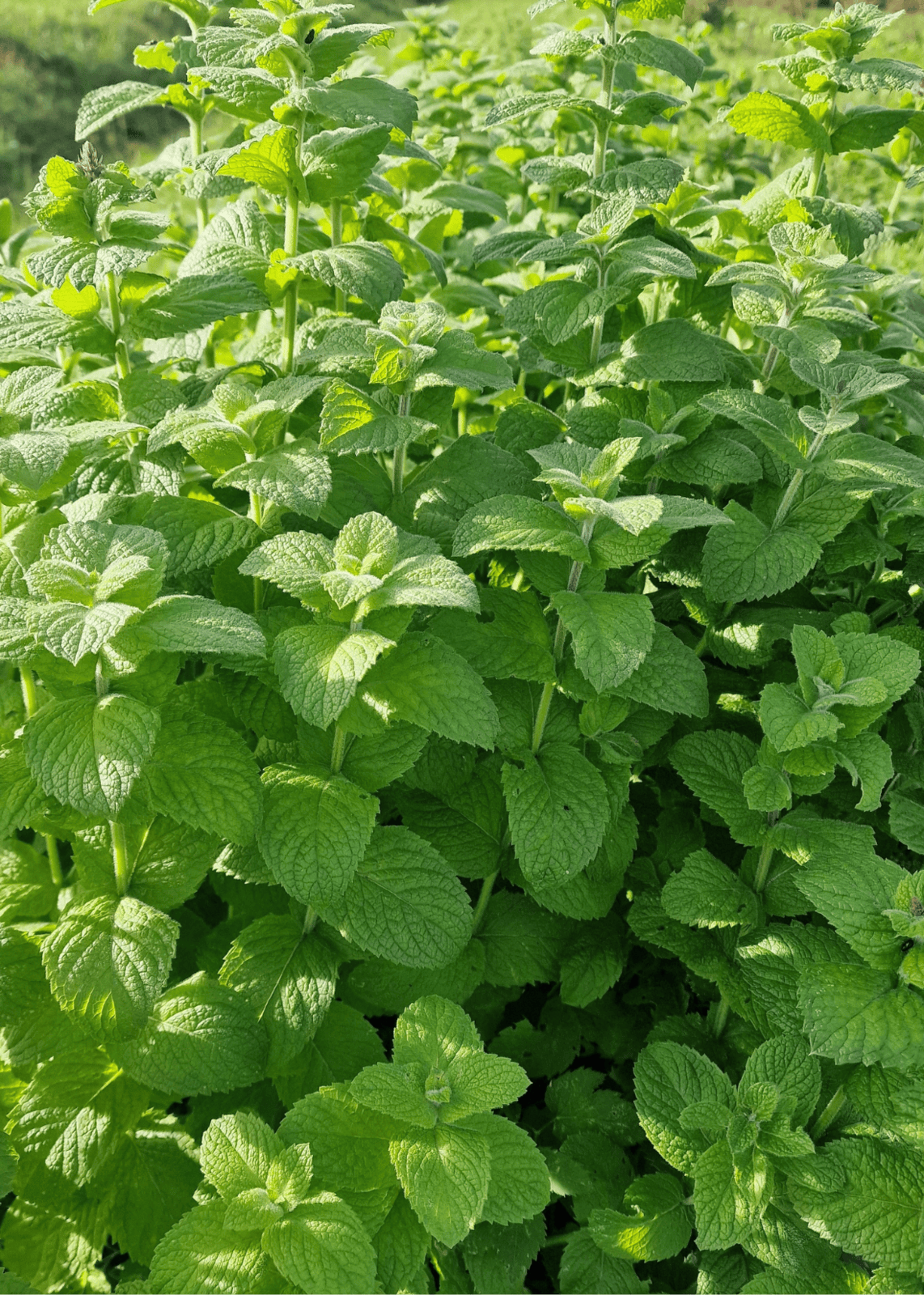
Apple mint
Mentha suaveolens (Lamiaceae)
Apple mint has a mild, fresh and slightly sweet taste with fruity notes. It has a beneficial effect on the body, promoting digestion, reducing bloating, as well as providing a calming effect on the nervous system. Due to its anti-inflammatory and antioxidant properties, apple mint helps reduce inflammation, supports respiratory health and soothes irritation of the mouth and throat. Apple mint has a lower menthol content compared to peppermint, making it suitable for individuals who experience undesirable effects from menthol, especially related to gastric sensitivity.
Health benefits: digestion, nervous system, respiratory health.
Chemical compounds: apple mint leaves contain essential oil, flavonoids, phenolic acids, tannins, terpenes.
Herbal action: anti-inflammatory, digestive, antimicrobial, soothing, expectorant, astringent.- Božović M, Pirolli A, Ragno R. Mentha suaveolens Ehrh. (Lamiaceae) Essential Oil and Its Main Constituent Piperitenone Oxide: Biological Activities and Chemistry. Molecules. 2015 May 13;20(5):8605-33. doi: 10.3390/molecules20058605. PMID: 25985361; PMCID: PMC6272761.
- Salehi B, Stojanović-Radić Z, Matejić J, Sharopov F, Antolak H, Kręgiel D, Sen S, Sharifi-Rad M, Acharya K, Sharifi-Rad R, et al. Plants of Genus Mentha: From Farm to Food Factory. Plants. 2018; 7(3):70. https://doi.org/10.3390/plants7030070
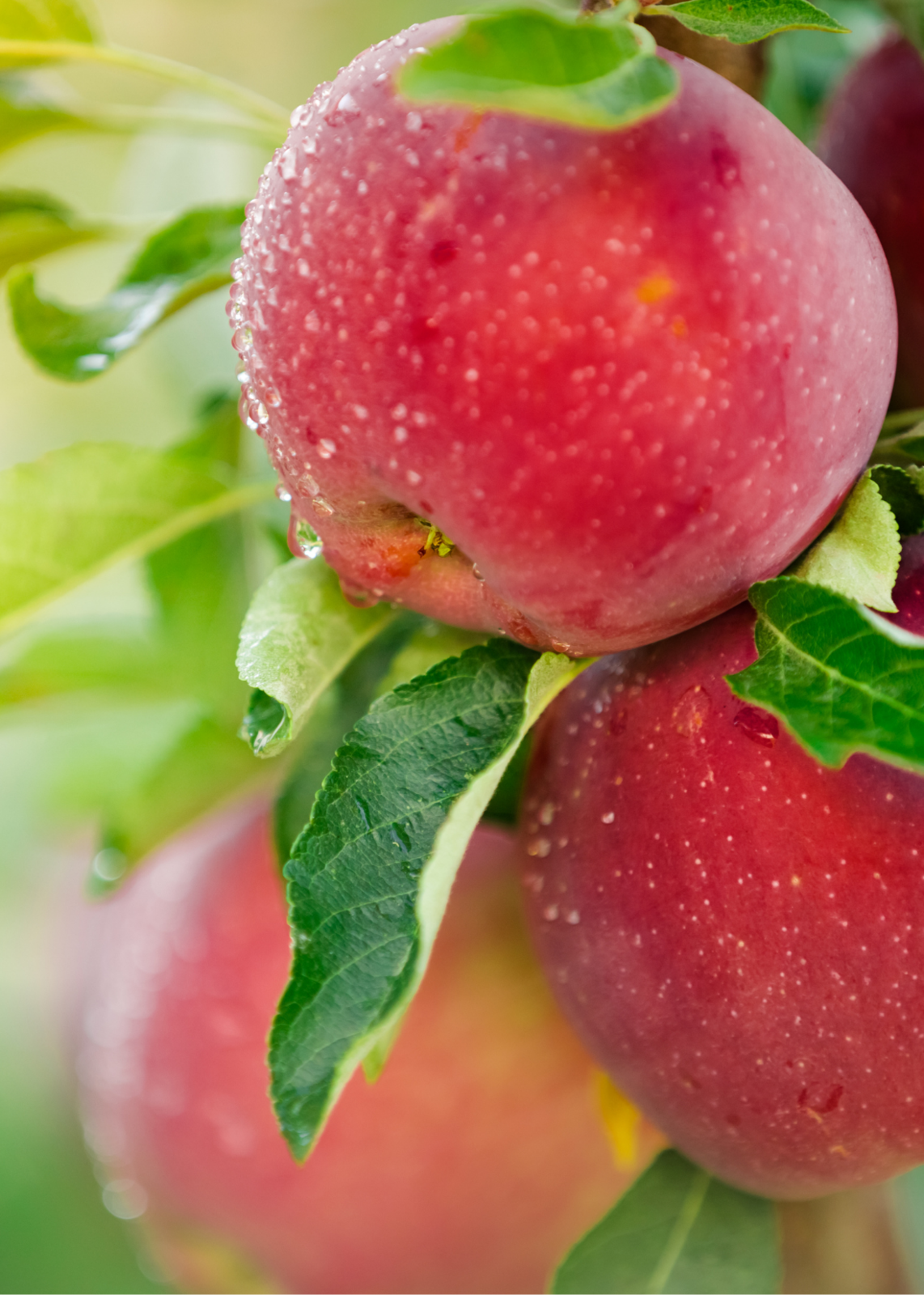
Apples
Malus spp. (Rosaceae)
Apples are highly nutritious fruits valued for their numerous health benefits. They are rich in dietary fiber, particularly pectin, which supports digestive health by promoting regular bowel movements and maintaining gut microbiota balance. Apples are also a significant source of vitamins such as C and B-complex, as well as essential minerals like potassium, supporting heart health and regulating blood pressure. Their high antioxidant content, including flavonoids and polyphenols, helps reduce inflammation, combat oxidative stress, and strengthen the immune system.
Health benefits: digestion, valuable source of vitamins and minerals.
Chemical compounds: apple fruits contain flavonoids, polyphenols, dietary fiber, vitamins (C, B-complex), minerals (potassium, magnesium), phenolic acids, and tannins.
Herbal action: antioxidant, anti-inflammatory, digestion-enhancing, and immune-supporting effects.- Oyenihi AB, Belay ZA, Mditshwa A, Caleb OJ. "An apple a day keeps the doctor away": The potentials of apple bioactive constituents for chronic disease prevention. J Food Sci. 2022 Jun;87(6):2291-2309. doi: 10.1111/1750-3841.16155. Epub 2022 May 3. PMID: 35502671; PMCID: PMC9321083.
- Mierczak K, Garus-Pakowska A. An Overview of Apple Varieties and the Importance of Apple Consumption in the Prevention of Non-Communicable Diseases-A Narrative Review. Nutrients. 2024 Sep 29;16(19):3307. doi: 10.3390/nu16193307. PMID: 39408274; PMCID: PMC11478947.
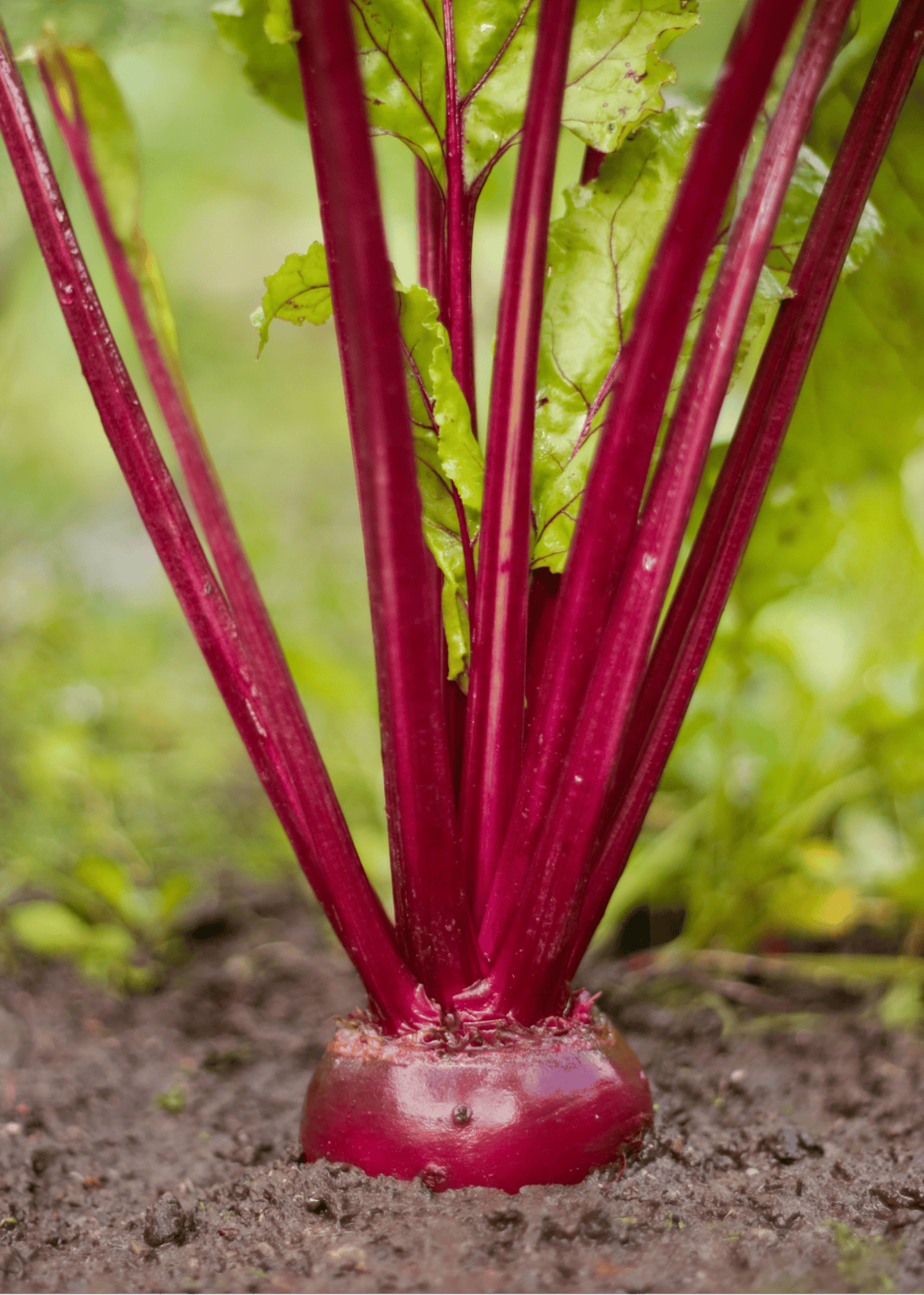
Beetroot
Beetroot
Beta vulgaris (Amaranthaceae)
Beetroot is a nutrient-rich vegetable. It is a source of folic acid, vitamin C, and minerals such as iron, magnesium, and potassium. Beetroot supports cardiovascular health as it contains nitrates, which improve blood circulation and help lower blood pressure. The antioxidants and other phytochemical compounds in beetroot help combat oxidative stress and inflammation in the body. Additionally, beetroot promotes digestion due to its high fiber content, which improves intestinal function and aids in the elimination of toxins from the body.
Health benefits: valuable source of minerals and vitamins, digestion, cardiovascular health.
Chemical compounds: beetroot contains fiber, nitrates, phenolic acids, flavonoids, vitamins (such as C and B-group), minerals (iron, potassium, magnesium), and antioxidants.
Herbal action: improves blood circulation, lowers blood pressure, anti-inflammatory, antioxidant, detoxifying, and digestion-enhancing effects.- Clifford T, Howatson G, West DJ, Stevenson EJ. The potential benefits of red beetroot supplementation in health and disease. Nutrients. 2015 Apr 14;7(4):2801-22. doi: 10.3390/nu7042801. PMID: 25875121; PMCID: PMC4425174.
- Punia Bangar S, Sharma N, Sanwal N, Lorenzo JM, Sahu JK. Bioactive potential of beetroot (Beta vulgaris). Food Res Int. 2022 Aug;158:111556. doi: 10.1016/j.foodres.2022.111556. Epub 2022 Jun 23. PMID: 35840248.

Birch
Birch
Betula pendula (Betulaceae)
Birch leaves have a broad and versatile range of effects, supported by both long-standing traditional medicine practices and scientific research. They are especially valued for urinary tract conditions due to their anti-inflammatory and mild diuretic properties, which help reduce swelling and excess fluid retention in the body. Additionally, birch leaves positively affect the digestive system by improving digestion and reducing the feeling of heaviness after meals. They also promote the body's detoxification process by aiding in the elimination of toxins and metabolic by-products.
Health benefits: body detoxification, digestion, kidney and bladder health.
Chemical compounds: birch leaves contain flavonoids, essential oil, triterpenoids, minerals (such as potassium), vitamins (ascorbic acid), carotene, tannins, and phytosterols.
Herbal action: anti-inflammatory, diuretic, and diaphoretic effects.- European Medicines Agency. (2017). European Union herbal monograph on Betula pendula Roth and Betula pubescens Ehrh., folium. Retrieved from https://www.ema.europa.eu/en/documents/herbal-monograph/final-european-union-herbal-monograph-betula-pendula-roth-betula-pubescens-ehrh-folium_en.pdf
- ESCOP Monographs: The Scientific Foundation for Herbal Medicinal Products. (2009). Birch leaf (Betulae folium). European Scientific Cooperative on Phytotherapy. Retrieved from https://www.escop.com/downloads/birch-leaf/
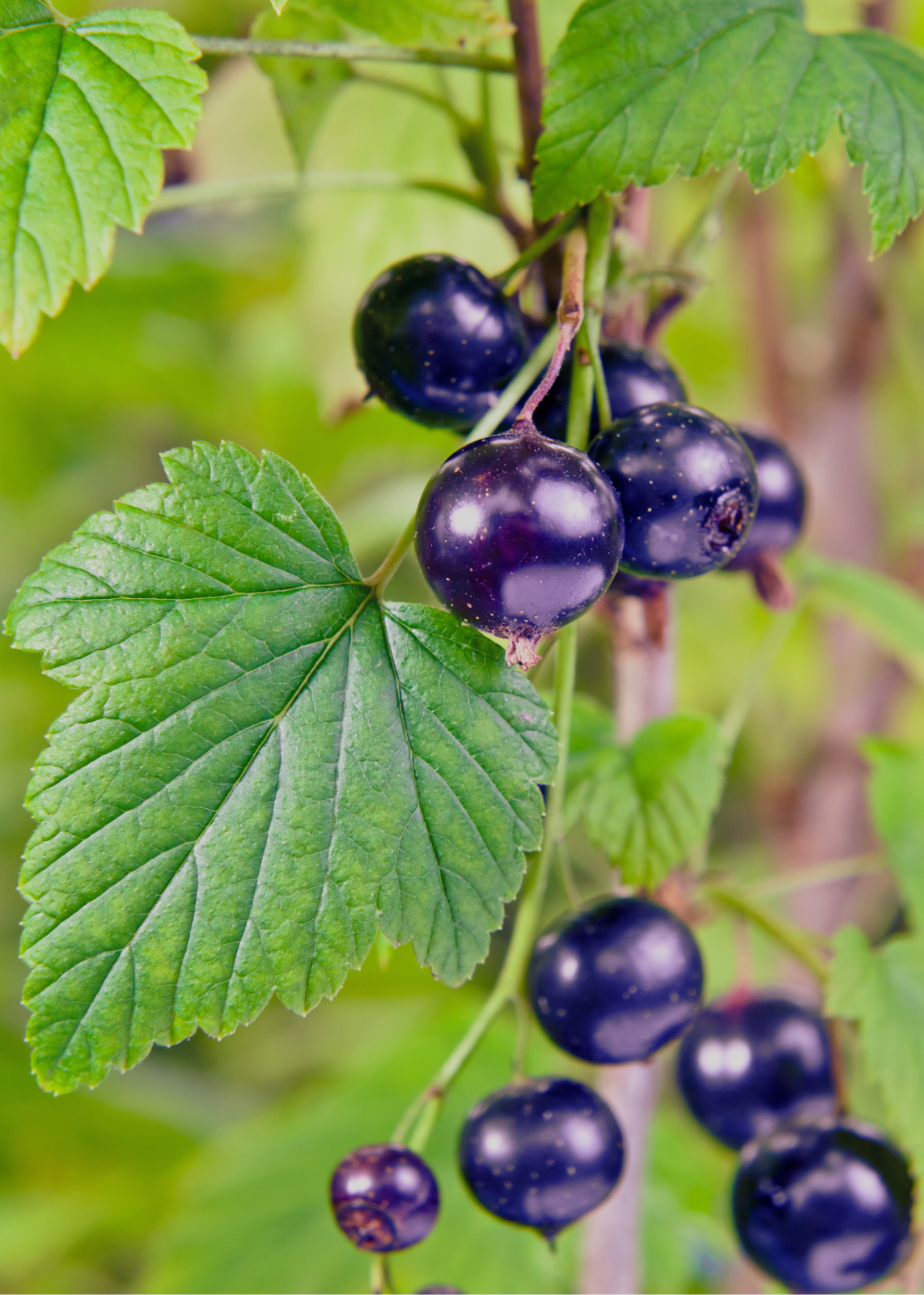
Blackcurrant
Ribes nigrum (Grossulariaceae)
Blackcurrant leaves help relieve mild joint pain and, due to their mild diuretic effect, promote urinary tract cleansing and reduce discomfort in mild urinary issues. The fruits, rich in vitamin C, anthocyanins, and flavonoids, boost immunity, protect cells from oxidative stress, support heart and vascular health, reduce inflammation, and improve overall energy levels. Due to these properties, blackcurrant leaves and fruits are valuable for supporting joint, urinary tract, and immune system health.
Health benefits: joint health, urinary tract health, immunity.
Chemical compounds: the leaves contain flavonoids, proanthocyanidins, essential oil, ascorbic acid, carotenoids, and minerals. The fruits contain ascorbic acid, organic acids, pectins, flavonoids, anthocyanins, sugars, vitamins (B-group, vitamin E), and minerals.
Herbal action: the leaves have anti-inflammatory, diuretic, and joint pain-relieving effects, while the fruits possess immunity-boosting, antioxidant, anti-inflammatory, and cardiovascular health-supporting properties.
- European Medicines Agency. (2016). Final European Union herbal monograph on Ribes nigrum L., folium. Retrieved from https://www.ema.europa.eu/en/documents/herbal-monograph/final-european-union-herbal-monograph-ribes-nigrum-l-folium_en.pdf
- Lyall KA, Hurst SM, Cooney J, Jensen D, Lo K, Hurst RD, Stevenson LM. Short-term blackcurrant extract consumption modulates exercise-induced oxidative stress and lipopolysaccharide-stimulated inflammatory responses. Am J Physiol Regul Integr Comp Physiol. 2009 Jul;297(1):R70-81. doi: 10.1152/ajpregu.90740.2008. Epub 2009 Apr 29. PMID: 19403859.
- Ejaz A, Waliat S, Afzaal M, Saeed F, Ahmad A, Din A, Ateeq H, Asghar A, Shah YA, Rafi A, Khan MR. Biological activities, therapeutic potential, and pharmacological aspects of blackcurrants (Ribes nigrum L): A comprehensive review. Food Sci Nutr. 2023 Aug 15;11(10):5799-5817. doi: 10.1002/fsn3.3592. PMID: 37823094; PMCID: PMC10563683.
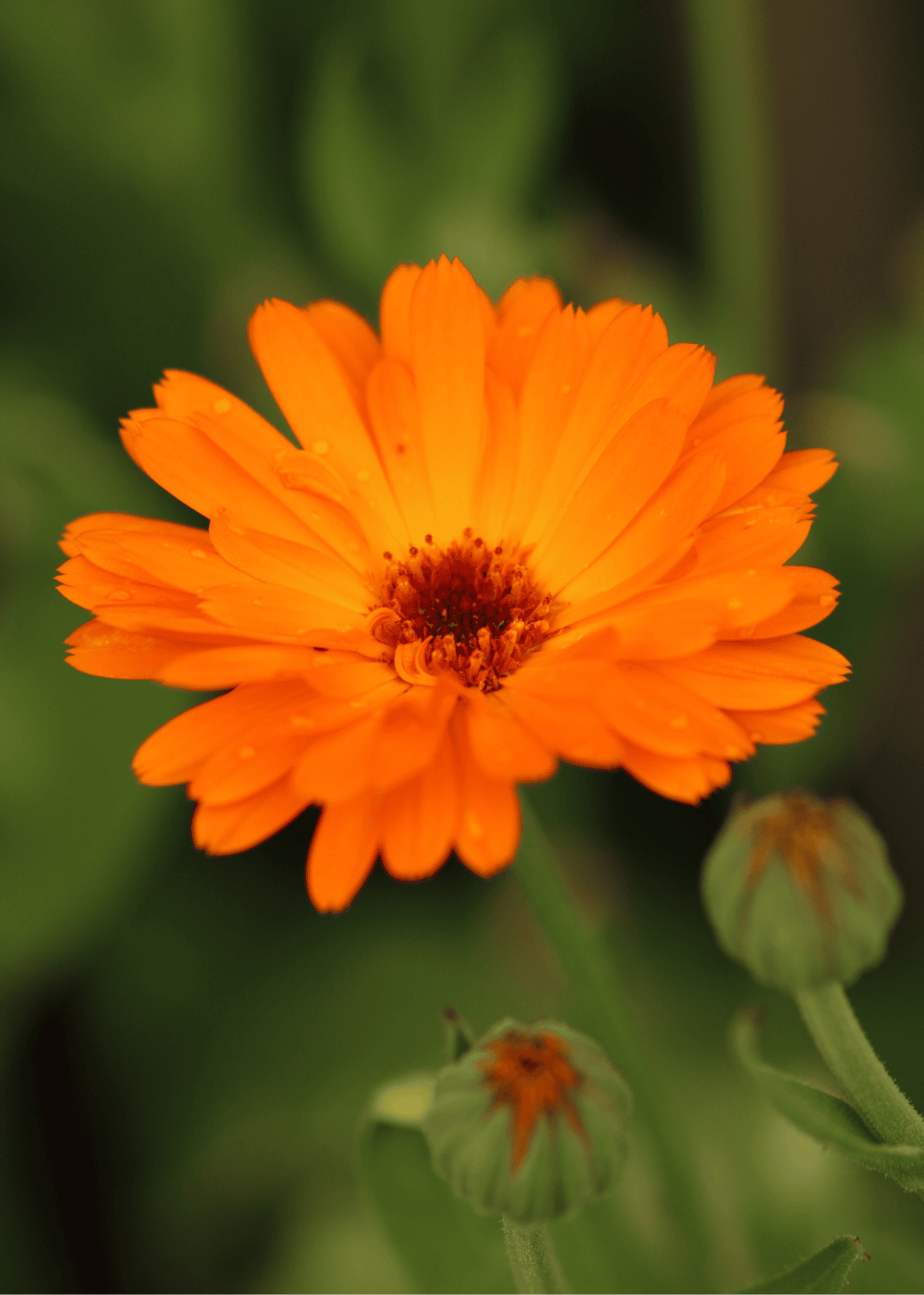
Calendula
Calendula officinalis (Asteraceae)
Calendula is a valuable medicinal plant that helps reduce moderate skin inflammation, such as sunburn. It is used as an additional remedy for the healing of superficial wounds, as well as for reducing inflammation of the oral cavity and throat. Calendula is also particularly useful for women's health - it helps reduce inflammation in the genital area, relieving discomfort caused by fungal infections or irritations, promotes faster recovery after childbirth, and also helps treat cracked nipples during breastfeeding.
Health benefits: gynecological health, postpartum period, skin and mucous membrane health.
Chemical compounds: flowers contain carotenoids (lutein and zeaxanthin), triterpene saponins, flavonoids, essential oil, polysaccharides, coumarins.
Herbal action: anti-inflammatory, wound healing, antiseptic, antispasmodic, hepatoprotective, choleretic, immune system stimulating effects.- European Medicines Agency. (2019). Final European Union herbal monograph on Calendula officinalis L., flos (revision 1). Retrieved from https://www.ema.europa.eu/en/documents/herbal-monograph/final-european-union-herbal-monograph-calendula-officinalis-l-flos-revision-1_en.pdf
- ESCOP. (2003). Calendulae flos – Calendula Flower: ESCOP Monographs. The Scientific Foundation for Herbal Medicinal Products (2nd ed.). Exeter, UK: European Scientific Cooperative on Phytotherapy.
- Romm, A. (2017). Botanical Medicine for Women's Health (2nd ed.). St. Louis, MO: Elsevier.
- Saffari E, Mohammad-Alizadeh-Charandabi S, Adibpour M, Mirghafourvand M, Javadzadeh Y. Comparing the effects of Calendula officinalis and clotrimazole on vaginal Candidiasis: A randomized controlled trial. Women Health. 2017 Nov-Dec;57(10):1145-1160. doi: 10.1080/03630242.2016.1263272. Epub 2016 Nov 23. PMID: 27880086.

Caraway
Carum carvi (Apiaceae)
Based on long-standing use, the consumption of caraway fruit tea has been scientifically proven to alleviate digestive disorders such as bloating and flatulence. Traditionally, caraway fruits have also been used to stimulate milk production in nursing mothers.
Health benefits: postpartum period, breastfeeding, digestion.
Chemical compounds: caraway fruits contain essential oil, primarily composed of carvone and limonene. The fruits also contain fixed oil, with linoleic acid, oleic acid, and palmitic acid as the main components. Other constituents include proteins, polysaccharides, phenolic acids, and small amounts of flavonoids.
Herbal action: spasmolytic, digestion-stimulating effect, relieving gas accumulation and the feeling of fullness.- European Medicines Agency. (2018). Final European Union Herbal Monograph on Carum carvi L., fructus. Retrieved from https://www.ema.europa.eu/en/documents/herbal-monograph/final-european-union-herbal-monograph-carum-carvi-l-fructus_en.pdf
- ESCOP. (2019). Carvi aetheroleum – Caraway Oil: ESCOP Monographs. The Scientific Foundation for Herbal Medicinal Products (2nd ed.). Exeter, UK: European Scientific Cooperative on Phytotherapy.
- Romm, A. (2017). Botanical Medicine for Women's Health (2nd ed.). St. Louis, MO: Elsevier.
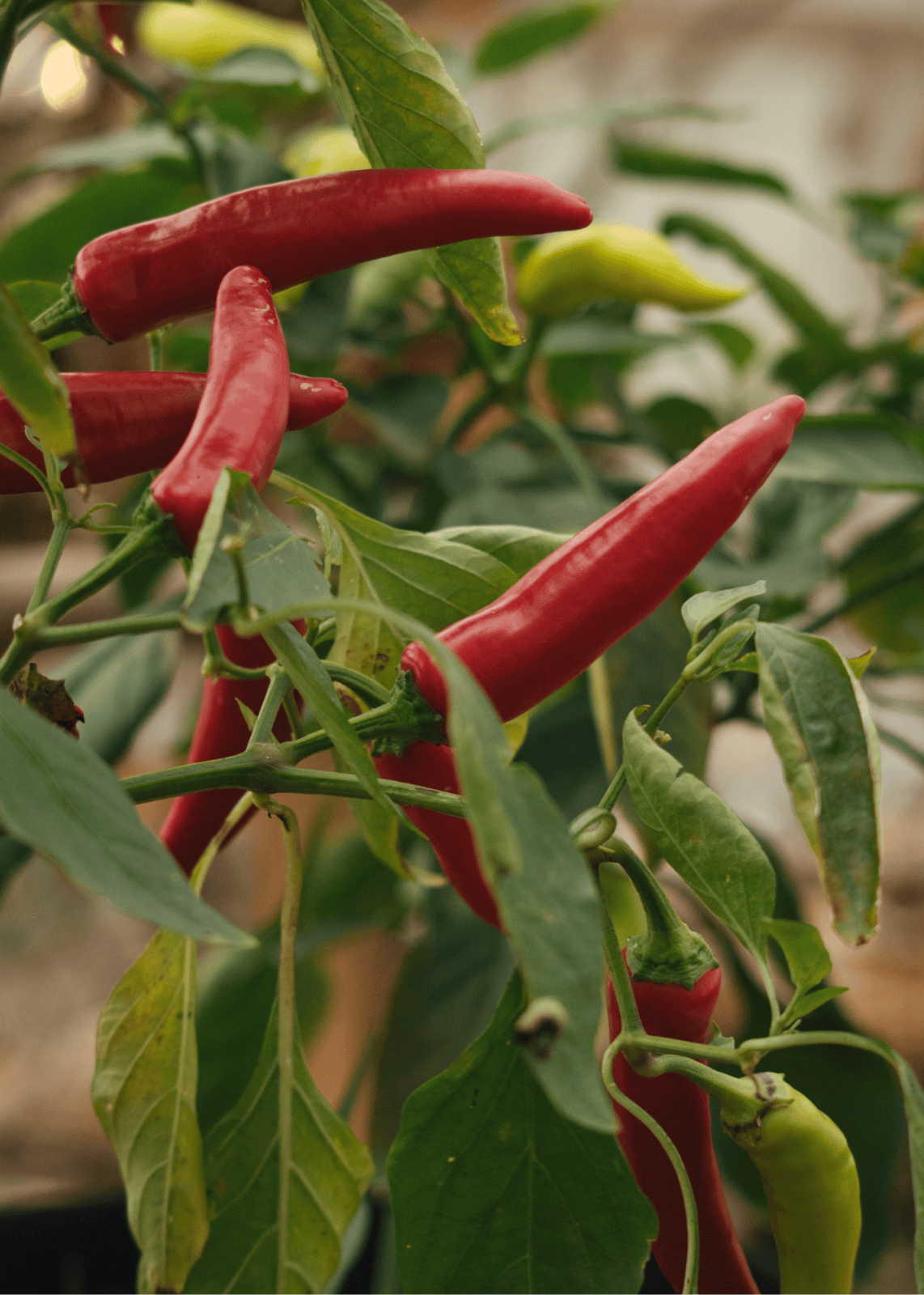
Cayenne pepper
Capsicum annuum (Solanaceae)
Cayenne pepper is widely used primarily due to its active compound, capsaicin. This herb is known for its ability to stimulate metabolism and promote fat burning. It also improves digestion by increasing gastric juice secretion, which helps better digest food and enhance nutrient absorption. Cayenne pepper has anti-inflammatory and pain-relieving properties, which are useful for reducing joint pain and muscle tension. Additionally, it possesses antimicrobial properties that strengthen the immune system and help alleviate nasal congestion. Regular use of cayenne pepper can also promote blood circulation and improve cardiovascular health.
Health benefits: digestion, metabolism, immunity, joint health, cardiovascular health.
Chemical compounds: the fruits contain capsaicin, flavonoids, vitamins, minerals, as well as essential oils and carotenoids.
Herbal action: pain-relieving, anti-inflammatory, metabolism-stimulating, digestion-enhancing, antioxidant, immune-boosting, and blood circulation-improving effects.- Blumenthal, M., Goldberg, A., & Brinckmann, J. (Eds.). (1998). Paprika, Cayenne: Commission E Monographs: Monographs on the Medicinal Uses of Plant Drugs. Austin, TX: American Botanical Council. Retrieved from https://www.herbalgram.org/resources/commission-e-monographs/monograph-approved-herbs/paprika-cayenne
- European Medicines Agency. (2019). Final European Union Herbal Monograph on Capsicum annuum L. var. minimum (Miller) Heiser and small-fruited varieties of Capsicum frutescens L., fructus. Retrieved from https://www.ema.europa.eu/en/documents/herbal-monograph/final-european-union-herbal-monograph-capsicum-annuum-l-var-minimum-miller-heiser-and-small-fruited-varieties-capsicum-frutescens-l-fructus_en.pdf
- McCarty MF, DiNicolantonio JJ, O'Keefe JH. Capsaicin may have important potential for promoting vascular and metabolic health. Open Heart. 2015 Jun 17;2(1):e000262. doi: 10.1136/openhrt-2015-000262. PMID: 26113985; PMCID: PMC4477151.
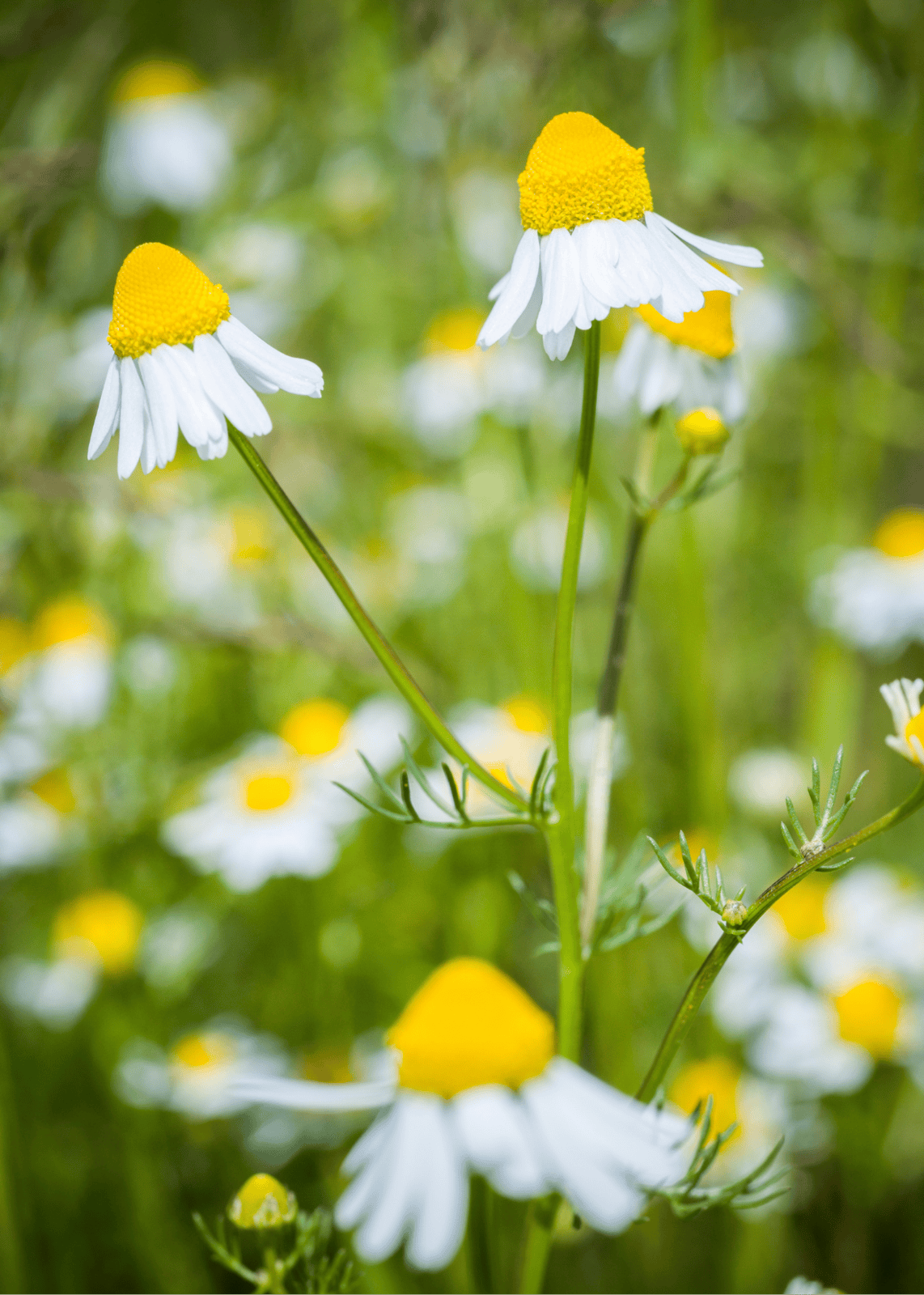
Chamomile
Matricaria recutita (Asteraceae)
Chamomile has a wide range of effects. Studies confirm its effectiveness in reducing gastrointestinal spasms, bloating and cold symptoms, as well as externally for reducing mouth and throat inflammation, various skin inflammations, sunburns, wounds, small boils, as well as reducing skin inflammation around the anus and genitals. The flavonoid apigenin found in chamomile is known for its calming properties, helping to reduce tension, stress and insomnia. Chamomile tea is suitable for the whole family, both children and adults, especially new mothers who are looking for a natural way to relax and reduce anxiety.
Health benefits: woman's cycle, pregnancy, postpartum period, breastfeeding, digestion, nervous system, sleep, respiratory tract, gynecological health, skin and mucous membrane health.
Chemical compounds: chamomile flowers contain essential oil, flavonoids, sesquiterpene lactones, coumarins, phenolic acids and polysaccharides.
Herbal action: anti-inflammatory, analgesic, antispasmodic, digestion-enhancing, sedative, antimicrobial and wound healing.- World Health Organization. (1999). Chamomilla recutita (L.). In WHO monographs on selected medicinal plants (Vol. 1, pp. 86-94). Retrieved from https://iris.who.int/bitstream/handle/10665/42052/9241545178.pdf?sequence=1&isAllowed=y
- Sah A, Naseef PP, Kuruniyan MS, Jain GK, Zakir F, Aggarwal G. A Comprehensive Study of Therapeutic Applications of Chamomile. Pharmaceuticals (Basel). 2022 Oct 19;15(10):1284. doi: 10.3390/ph15101284. PMID: 36297396; PMCID: PMC9611340.
- Romm, A. (2017). Botanical Medicine for Women's Health (2nd ed.). St. Louis, MO: Elsevier.

Damiana
Turnera diffusa (Passifloraceae)
Damiana is a medicinal herb traditionally used to support sexual function and reproductive health. It is known for its ability to stimulate libido and enhance sexual performance in both men and women. Damiana is believed to influence estrogen and testosterone levels, thereby boosting sexual desire and performance. It helps reduce stress, anxiety, and nervousness, which often negatively affect sexual health, while also promoting blood circulation in the pelvic region. In addition to enhancing sexual function, damiana is used as a general tonic for the body and mind, improving energy levels, mood, and vitality. It also serves as a digestion-enhancing agent and a mild diuretic.
Health benefits: sexual function, libido, vitality, digestion.
Chemical compounds: the leaves contain flavonoids, terpenoids, coumarins, alkaloids, triterpenes, glycosides, and essential oil.
Herbal action: sexual function-stimulating, anti-inflammatory, antioxidant, circulation-enhancing, and mildly stimulating effects that promote both physical and emotional well-being.- Parra-Naranjo A, Delgado-Montemayor C, Salazar-Aranda R, Waksman-Minsky N. Bioactivity of the Genus Turnera: A Review of the Last 10 Years. Pharmaceuticals (Basel). 2023 Nov 7;16(11):1573. doi: 10.3390/ph16111573. PMID: 38004438; PMCID: PMC10675026.
- Szewczyk K, Zidorn C. Ethnobotany, phytochemistry, and bioactivity of the genus Turnera (Passifloraceae) with a focus on damiana--Turnera diffusa. J Ethnopharmacol. 2014 Mar 28;152(3):424-43. doi: 10.1016/j.jep.2014.01.019. Epub 2014 Jan 24. PMID: 24468305.
- Kotta S, Ansari SH, Ali J. Exploring scientifically proven herbal aphrodisiacs. Pharmacogn Rev. 2013 Jan;7(13):1-10. doi: 10.4103/0973-7847.112832. PMID: 23922450; PMCID: PMC3731873.
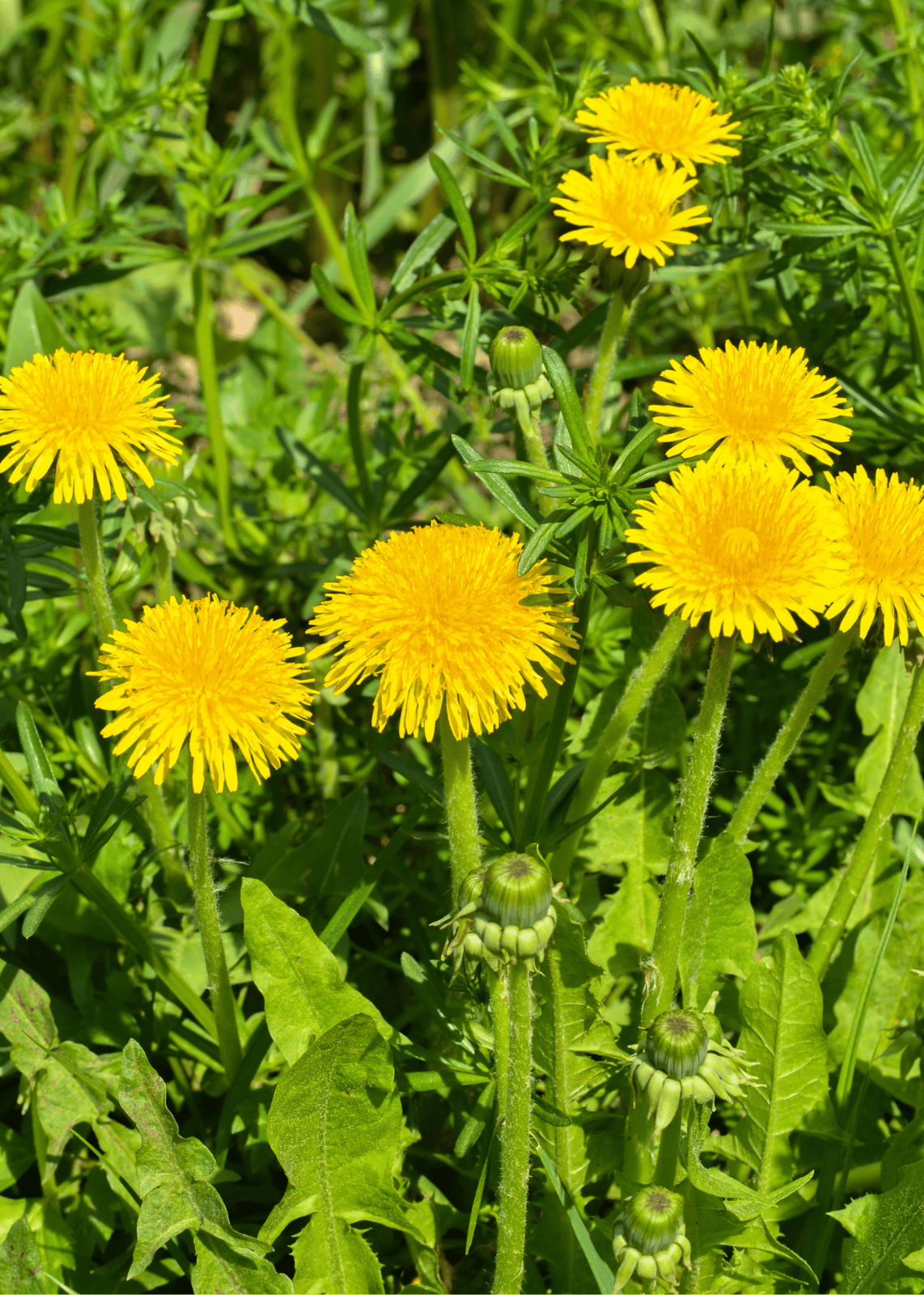
Dandelion
Taraxacum officinale (Asteraceae)
Dandelion is a highly effective herb for supporting digestive and liver health. Every part of the dandelion plant is edible, from the flower to the root. It stimulates appetite, improves digestion, and promotes bile secretion. Additionally, it supports fat metabolism, reduces the feeling of fullness, and relieves gas accumulation. Dandelion enhances liver function, aiding the body's detoxification process, and acts as a diuretic, helping with mild urinary tract issues. Since the liver is involved in hormone metabolism, particularly the breakdown and elimination of female sex hormones like estrogen, optimal liver function supports hormonal balance, which is essential for overall health and well-being.
Health benefits: body detoxification, liver health, digestion.
Chemical compounds: dandelion roots contain triterpene compounds, inulin, phytosterols, flavonoids, phenolic acids, and minerals. The leaves and flowers contain flavonoids, phenolic acids, phytosterols, sesquiterpenes, vitamins, and minerals, with particularly high potassium content.
Herbal action: appetite-stimulating, digestion-enhancing, stool-softening, fat metabolism-promoting, choleretic, and diuretic effects.- ESCOP. (2024). Taraxaci radix: Dandelion root. Retrieved from https://www.escop.com/downloads/taraxaci-radix-dandelion-root-escop-2024/
- European Medicines Agency. (2016). Final European Union herbal monograph on Taraxacum officinale Weber ex Wigg., radix. Retrieved from https://www.ema.europa.eu/en/documents/herbal-monograph/final-european-union-herbal-monograph-taraxacum-officinale-fh-wigg-radix_en.pdf
- Romm, A. (2017). Botanical Medicine for Women's Health (2nd ed.). St. Louis, MO: Elsevier.
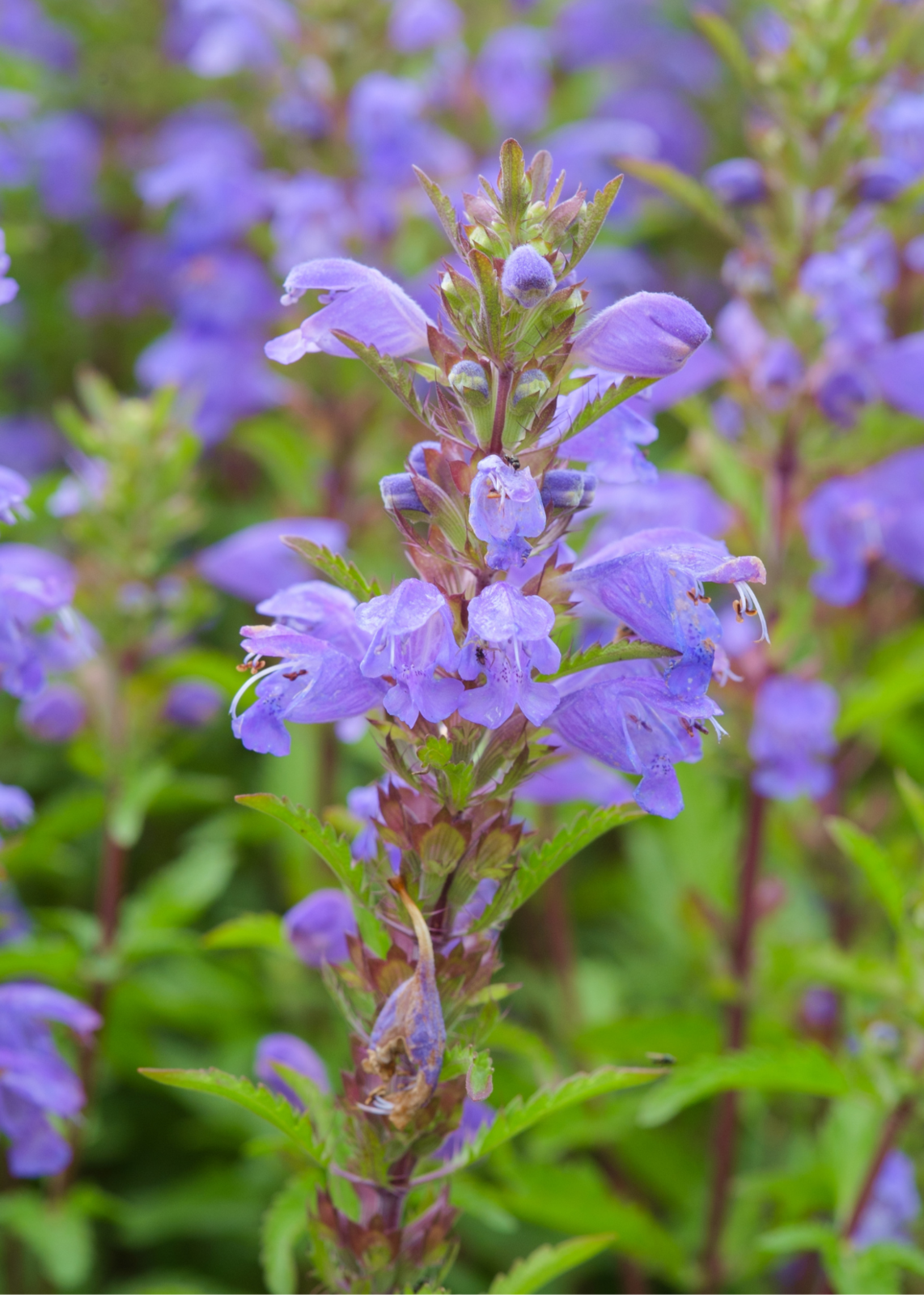
Dragonhead
Dracocephalum moldavica (Lamiaceae)
Dragonhead is a pleasantly aromatic herb used to promote health due to its calming, anti-inflammatory, and antioxidant properties. It helps reduce stress, improve sleep quality, support the digestive system, relieve bloating, and stimulate appetite. Dragonhead strengthens immunity, protects cells from oxidative stress, and helps combat microorganisms. Additionally, it supports heart and vascular health by improving circulation and regulating blood pressure, making it a valuable natural remedy for overall well-being.
Health benefits: nervous system, digestion, heart and cardiovascular health.
Chemical compounds: the aerial parts contain essential oil, flavonoids, phenylpropanoids, lignans, terpenoids, glycosides, and polysaccharides.
Herbal action: calming, anti-inflammatory, antioxidant, digestion-enhancing, immunity-boosting, antimicrobial, and cardiovascular health-supporting effects.- Zhan M, Ma M, Mo X, Zhang Y, Li T, Yang Y, Dong L. Dracocephalum moldavica L.: An updated comprehensive review of its botany, traditional uses, phytochemistry, pharmacology, and application aspects. Fitoterapia. 2024 Jan;172:105732. doi: 10.1016/j.fitote.2023.105732. Epub 2023 Nov 10. PMID: 37952760.
- Simea Ș, Ielciu I, Hanganu D, Niculae M, Pall E, Burtescu RF, Olah NK, Cenariu M, Oniga I, Benedec D, Duda M. Evaluation of the Cytotoxic, Antioxidative and Antimicrobial Effects of Dracocephalum moldavica L. Cultivars. Molecules. 2023 Feb 7;28(4):1604. doi: 10.3390/molecules28041604. PMID: 36838592; PMCID: PMC9965778.

Echinacea
Echinacea purpurea (Asteraceae)
Health benefits: immunity, colds, skin health.
Chemical compounds: the aerial parts and flowers contain polysaccharides, essential oil, flavonoids, phenolic carboxylic acids, tannins, saponins, organic acids, resinous compounds, and phytosterols.
Herbal action: antiviral, immune-stimulating, anti-inflammatory, antibacterial, antifungal, blood pressure-raising, wound-healing, and tissue-regenerating effects.- European Medicines Agency. (2015). Final European Union herbal monograph on Echinacea purpurea (L.) Moench, herba recens. Retrieved from https://www.ema.europa.eu/en/documents/herbal-monograph/final-european-union-herbal-monograph-echinacea-purpurea-l-moench-herba-recens_en.pdf
- ESCOP. Echinaceae purpureae herba: Purple coneflower herb. Retrieved from https://www.escop.com/downloads/echinaceae-purpureae-herba-purple-coneflower-herb/
- Romm, A. (2017). Botanical Medicine for Women's Health (2nd ed.). St. Louis, MO: Elsevier.
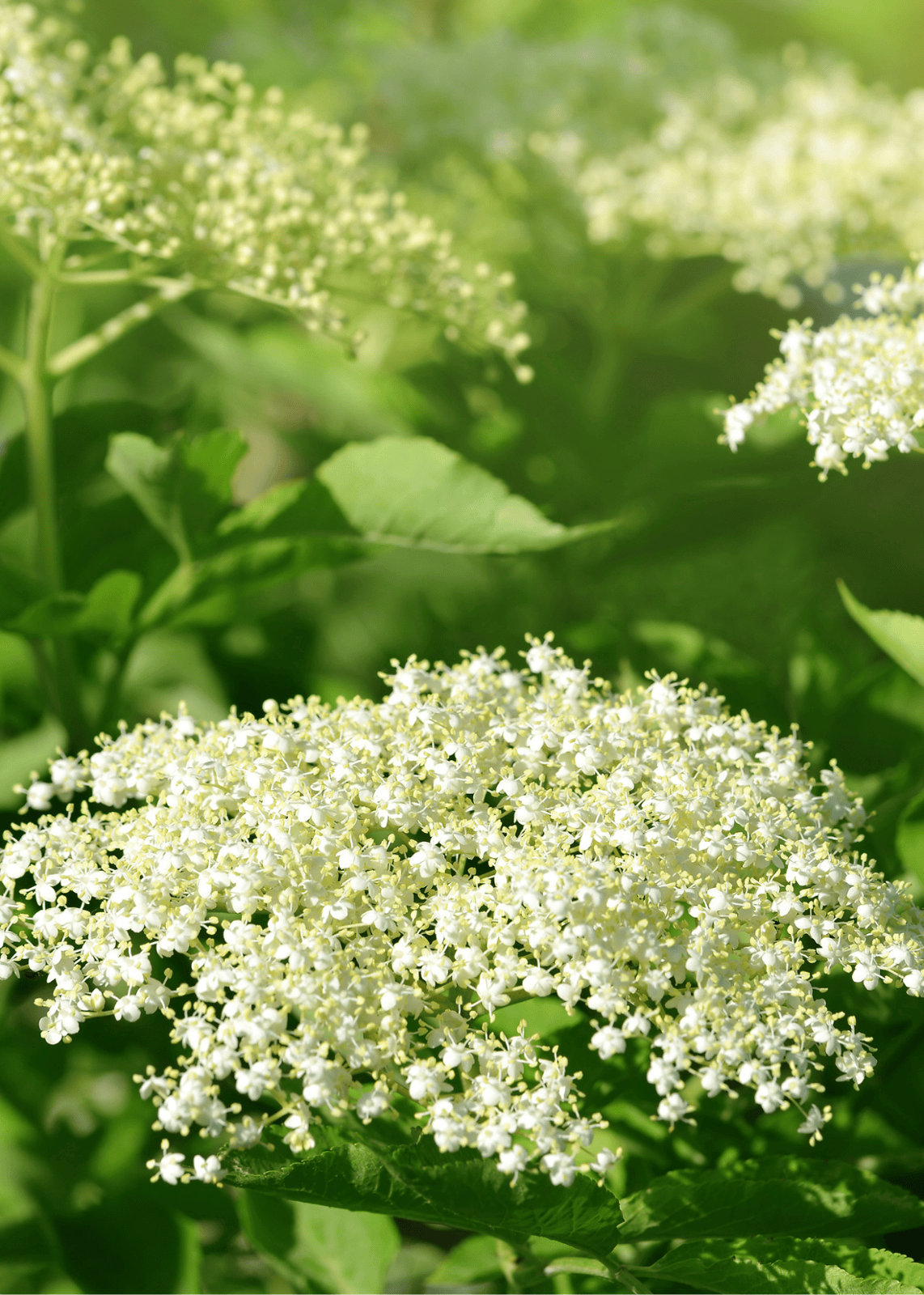
Elder
Sambucus nigra (Viburnaceae)
Based on long-standing use, elderflower has been proven effective in relieving early symptoms of colds. Elderflowers possess mild diaphoretic and anti-inflammatory properties, helping to reduce fever, alleviate respiratory symptoms, and stimulate the immune system. They are commonly used in teas or other remedies to promote recovery from colds and flu. It is important to note that only the flowers and fully ripe, dried, or heat-processed fruits are safe for use, as the leaves, bark, and unripe fruits are toxic.
Health benefits: colds, immunity.
Chemical compounds: elderflowers contain flavonoids (quercetin, isoquercetin, rutin, kaempferol), triterpene saponins, essential oil, caffeic acid derivatives, as well as potassium, tannins, mucilage, and pectins.
Herbal action: anti-inflammatory, antibacterial, immunity-boosting, diuretic, and diaphoretic effects, helpful in cases of colds, fever, and chills, with the additional ability to lower blood glucose levels.- European Medicines Agency. (2018, July 5). Final European Union herbal monograph on Sambucus nigra L., flos (Revision 1). https://www.ema.europa.eu/en/documents/herbal-monograph/final-european-union-herbal-monograph-sambucus-nigra-l-flos-revision-1_en.pdf
- American Botanical Council. Elder flower. In Herbalgram: Commission E Monographs. Retrieved from https://www.herbalgram.org/resources/commission-e-monographs/monograph-approved-herbs/elder-flower/
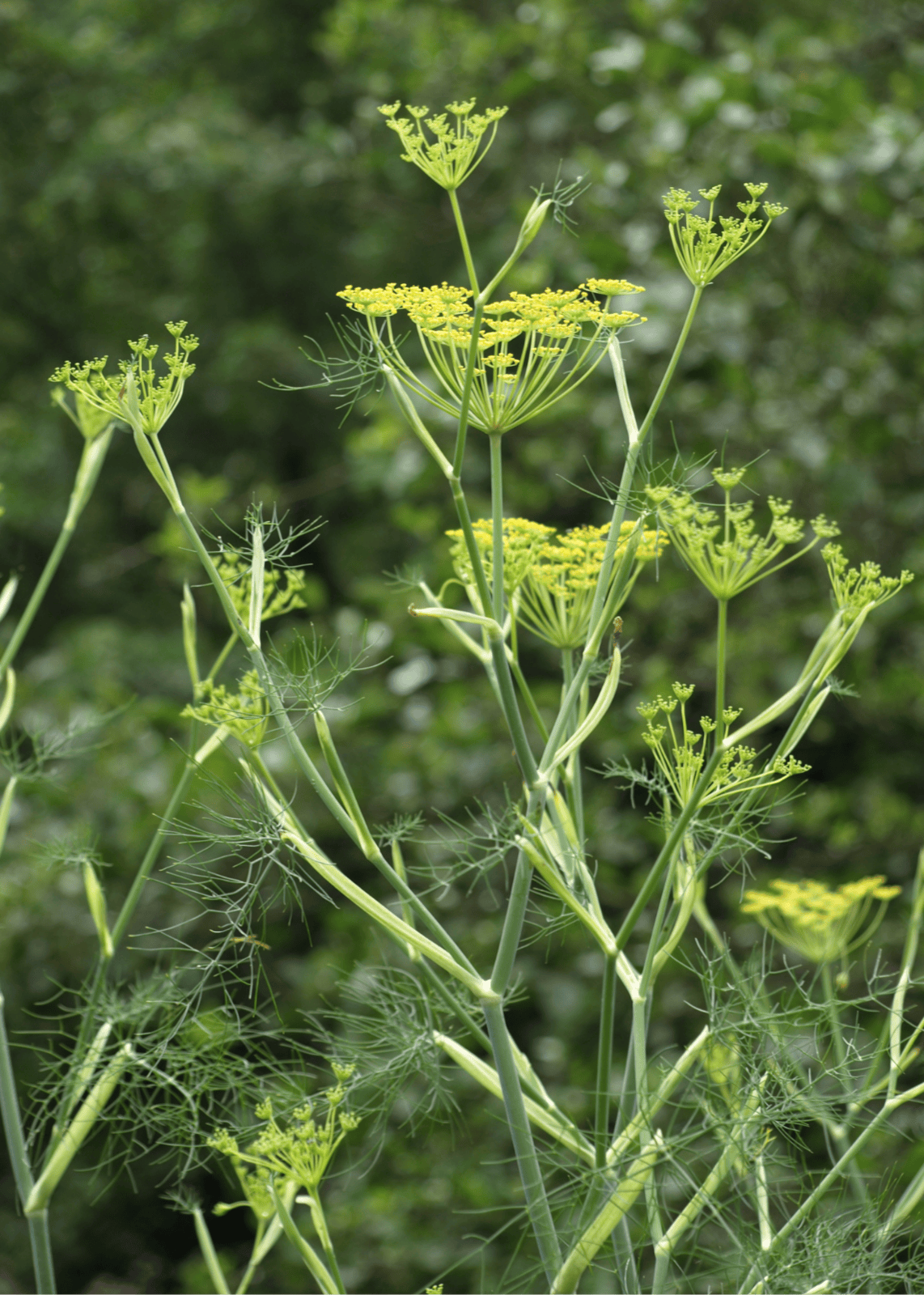
Fennel
Foeniculum vulgare (Apiaceae)
Fennel is a widely used medicinal herb with scientifically proven health benefits. It is commonly used to relieve mild, spasmodic gastrointestinal disorders such as bloating and gas accumulation. Due to its phytoestrogenic properties, fennel helps maintain hormonal balance and can alleviate mild menstrual cramps. It also serves as an expectorant, helping to ease coughs caused by colds and promote respiratory tract clearance. Traditionally, fennel seeds have been used to stimulate milk production during breastfeeding by boosting prolactin levels, the hormone responsible for milk synthesis, thereby supporting both mother and child health. Because of these properties, fennel is a valuable remedy for maintaining digestive and respiratory health while also benefiting women at various life stages.
Health benefits: woman’s cycle, breastfeeding, menopause, digestion, respiratory tract.
Chemical compounds: the fruits contain essential oil (anethole, estragole), as well as flavonoids and phenolic acids.
Herbal action: spasmolytic, bloating- and gas-reducing, expectorant, phytoestrogenic, milk production-stimulating, antimicrobial, and anti-inflammatory effects.- European Medicines Agency. (2008). Final European Union herbal monograph on Foeniculum vulgare Miller subsp. vulgare var. vulgare fructus (revision 1). Retrieved from https://www.ema.europa.eu/en/documents/herbal-monograph/final-european-union-herbal-monograph-foeniculum-vulgare-miller-subsp-vulgare-var-vulgare-fructus-revision-1_en.pdf
- ESCOP. Foeniculi fructus: Fennel fruit. Retrieved, from https://www.escop.com/downloads/foeniculi-fructus-fennel-fruit/
- Romm, A. (2017). Botanical Medicine for Women's Health (2nd ed.). St. Louis, MO: Elsevier.
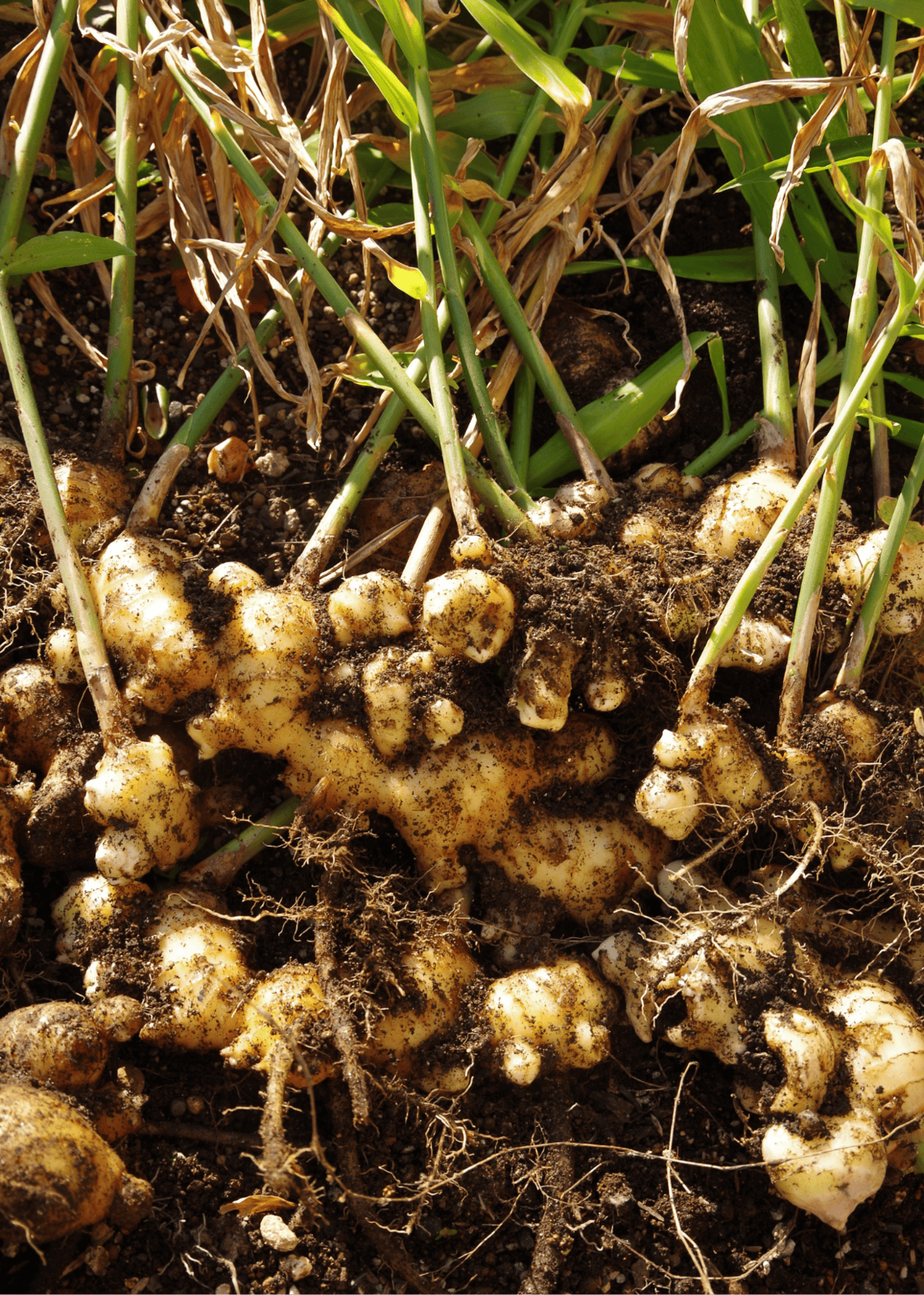
Ginger
Zingiber officinale (Zingiberaceae)
Ginger is a medicinal herb widely used to support the digestive, respiratory, and immune systems. It effectively relieves nausea, including morning sickness during pregnancy and nausea caused by travel or chemotherapy. Ginger enhances digestion, stimulates appetite, and helps reduce bloating and spasms. Its anti-inflammatory and analgesic properties make it beneficial for relieving joint pain and inflammation, especially in cases of arthritis. Ginger also supports respiratory health by easing coughs and cold symptoms due to its antibacterial and expectorant properties. Additionally, it acts as a powerful antioxidant, helping to strengthen the immune system and protect cells from oxidative stress.
Health benefits: pregnancy, digestion, nausea, immunity.
Chemical compounds: the rhizomes contain polysaccharides, essential oil, flavonoids, organic acids, and terpenoids.
Herbal action: anti-inflammatory, antioxidant, digestion-enhancing, nausea-relieving, antibacterial, and immunity-boosting effects.- European Medicines Agency. (2012). Final Community Herbal Monograph on Zingiber officinale Roscoe, rhizoma. Retrieved from https://www.ema.europa.eu/en/documents/herbal-monograph/final-community-herbal-monograph-zingiber-officinale-roscoe-rhizoma_en.pdf
- ESCOP. Ginger: Usually Underdosed? Retrieved from https://www.escop.com/ginger-usually-underdosed/
- Viljoen E, Visser J, Koen N, Musekiwa A. A systematic review and meta-analysis of the effect and safety of ginger in the treatment of pregnancy-associated nausea and vomiting. Nutr J. 2014 Mar 19;13:20. doi: 10.1186/1475-2891-13-20. PMID: 24642205; PMCID: PMC3995184.
- Romm, A. (2017). Botanical Medicine for Women's Health (2nd ed.). St. Louis, MO: Elsevier.
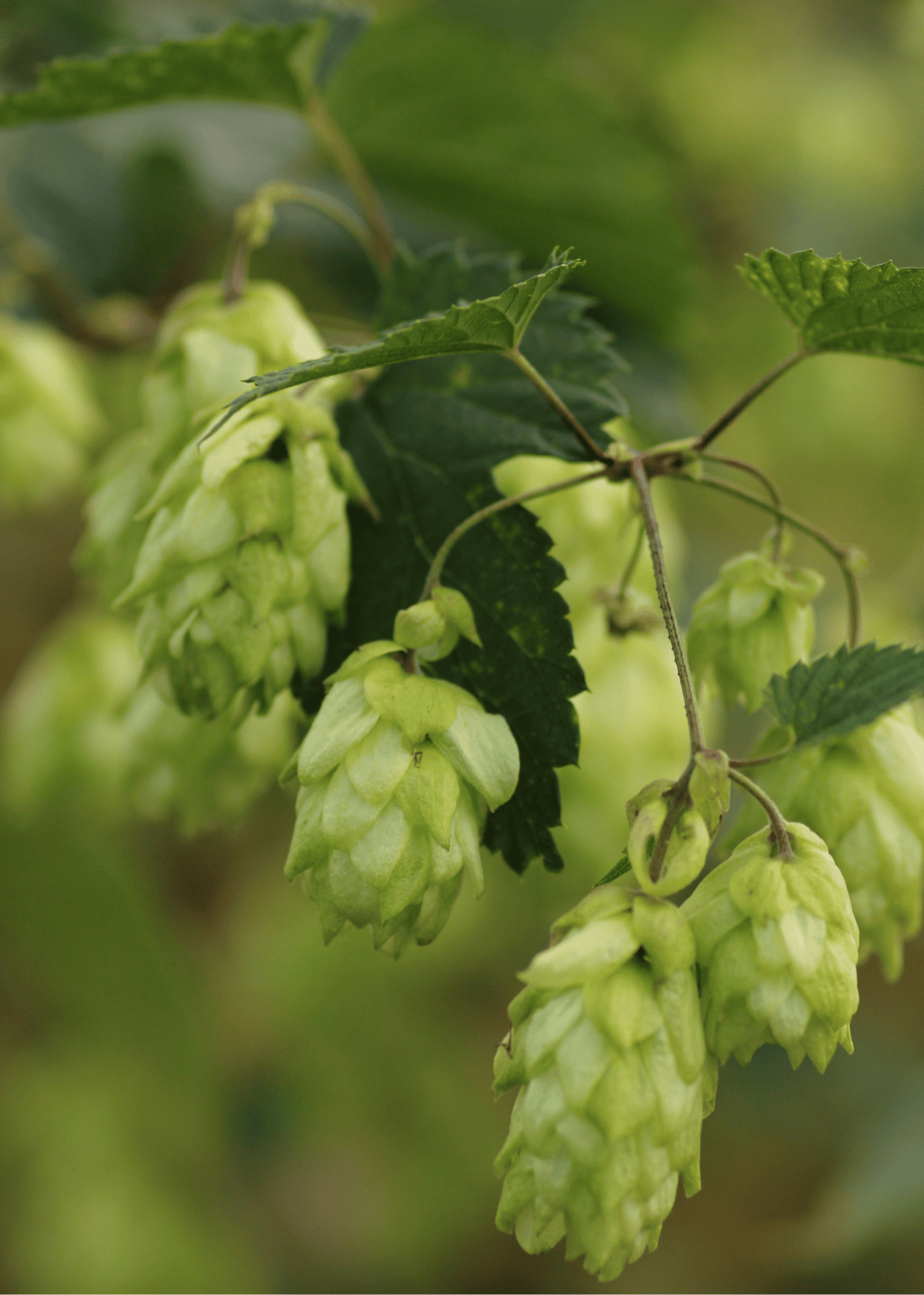
Hop
Humulus lupulus (Cannabaceae)
Scientific studies have found several potential benefits of hops for women’s health, especially in reducing menopausal symptoms, reducing anxiety, and improving sleep. It may help relieve menopausal symptoms such as hot flashes, night sweats, and vaginal dryness. Hops have traditionally been used for their calming properties, and scientific research supports their use for relieving mild symptoms of nervous tension and sleep disorders. Hops are considered safe to consume. However, they should not be used by pregnant women.
Health benefits: menopause, nervous system, sleep, digestion.
Chemical compounds: the flowers contain bitter compounds, essential oil, flavonoids, proanthocyanidins, phenolic acids, polysaccharides, minerals, as well as phytoestrogens, which mimic the hormone estrogen in our body.
Herbal action: soothing, phytoestrogenic, antispasmodic, anti-inflammatory, antimicrobial effects.- European Medicines Agency. (2018). Final Community Herbal Monograph on Humulus lupulus L., flos (revision 1). Retrieved from https://www.ema.europa.eu/en/documents/herbal-monograph/final-community-herbal-monograph-humulus-lupulus-l-flos-revision-1_en.pdf
- Romm, A. (2017). Botanical Medicine for Women's Health (2nd ed.). St. Louis, MO: Elsevier.
- Dietz BM, Hajirahimkhan A, Dunlap TL, Bolton JL. Botanicals and Their Bioactive Phytochemicals for Women's Health. Pharmacol Rev. 2016 Oct;68(4):1026-1073. doi: 10.1124/pr.115.010843. PMID: 27677719; PMCID: PMC5050441.
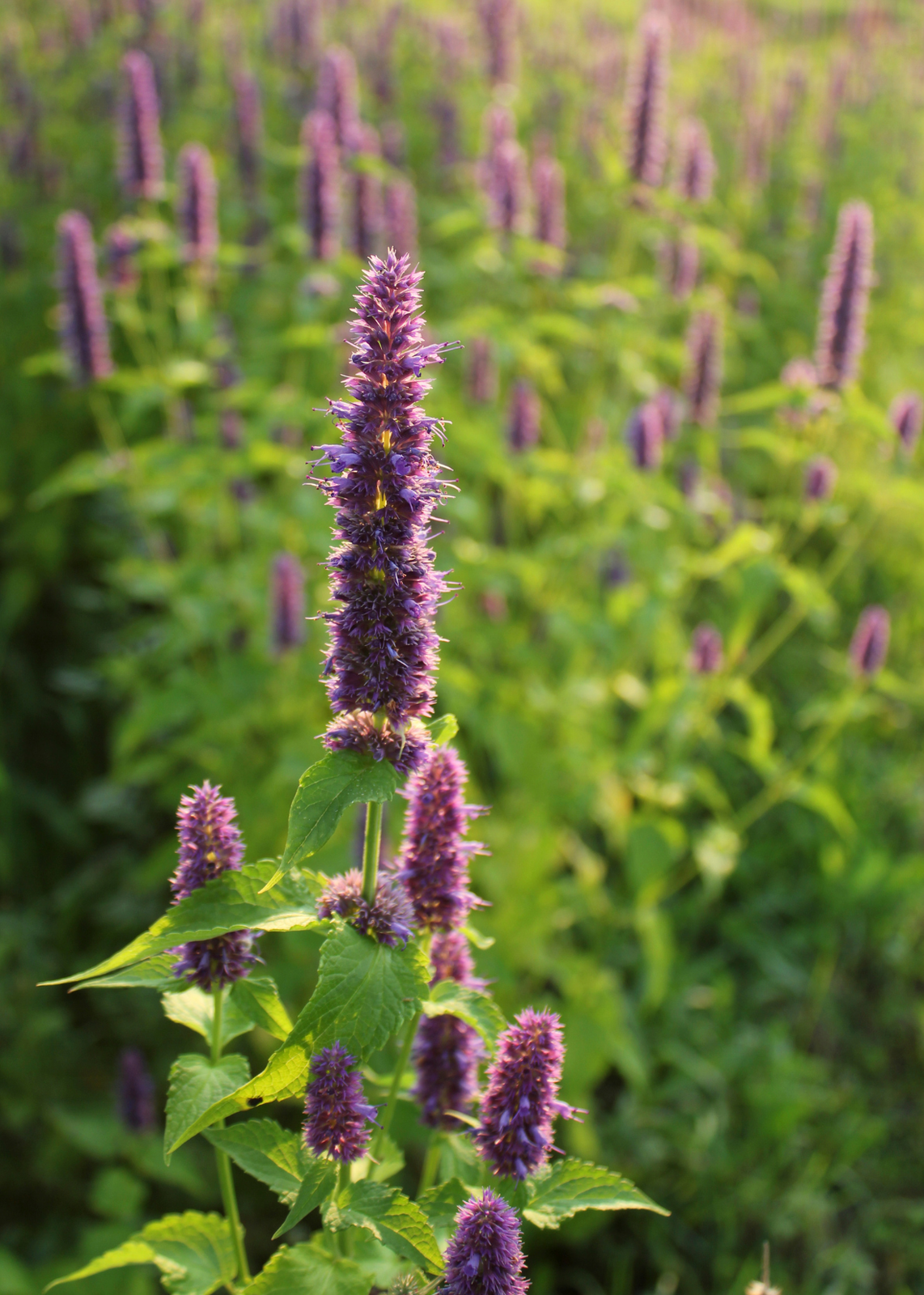
Korean mint
Agastache rugosa (Lamiaceae)
Korean mint is a highly valued medicinal herb in traditional Asian medicine, used to support the digestive, respiratory, and nervous systems. Its calming and spasmolytic properties help reduce stress, anxiety, and nervousness while improving sleep quality. For the digestive system, it is beneficial in cases of bloating, nausea, and digestive disorders, promoting gastrointestinal function and relieving discomfort. Korean mint also supports respiratory health during colds, easing breathing and reducing inflammation.
Health benefits: digestion, nervous system, respiratory tract.
Chemical compounds: the leaves contain essential oil, flavonoids, phenylpropanoids, lignans, and terpenoids.
Herbal action: calming, digestion-enhancing, anti-inflammatory, antioxidant, antimicrobial, respiratory-relieving, and toning effects.- Nechita MA, Toiu A, Benedec D, Hanganu D, Ielciu I, Oniga O, Nechita VI, Oniga I. Agastache Species: A Comprehensive Review on Phytochemical Composition and Therapeutic Properties. Plants (Basel). 2023 Aug 14;12(16):2937. doi: 10.3390/plants12162937. PMID: 37631149; PMCID: PMC10459224.
- Zielińska S, Matkowski A. Phytochemistry and bioactivity of aromatic and medicinal plants from the genus Agastache (Lamiaceae). Phytochem Rev. 2014;13(2):391-416. doi: 10.1007/s11101-014-9349-1. Epub 2014 Apr 3. PMID: 24899872; PMCID: PMC4032471.
- Nam HH, Kim JS, Lee J, Seo YH, Kim HS, Ryu SM, Choi G, Moon BC, Lee AY. Pharmacological Effects of Agastache rugosa against Gastritis Using a Network Pharmacology Approach. Biomolecules. 2020 Sep 9;10(9):1298. doi: 10.3390/biom10091298. PMID: 32916904; PMCID: PMC7565599.
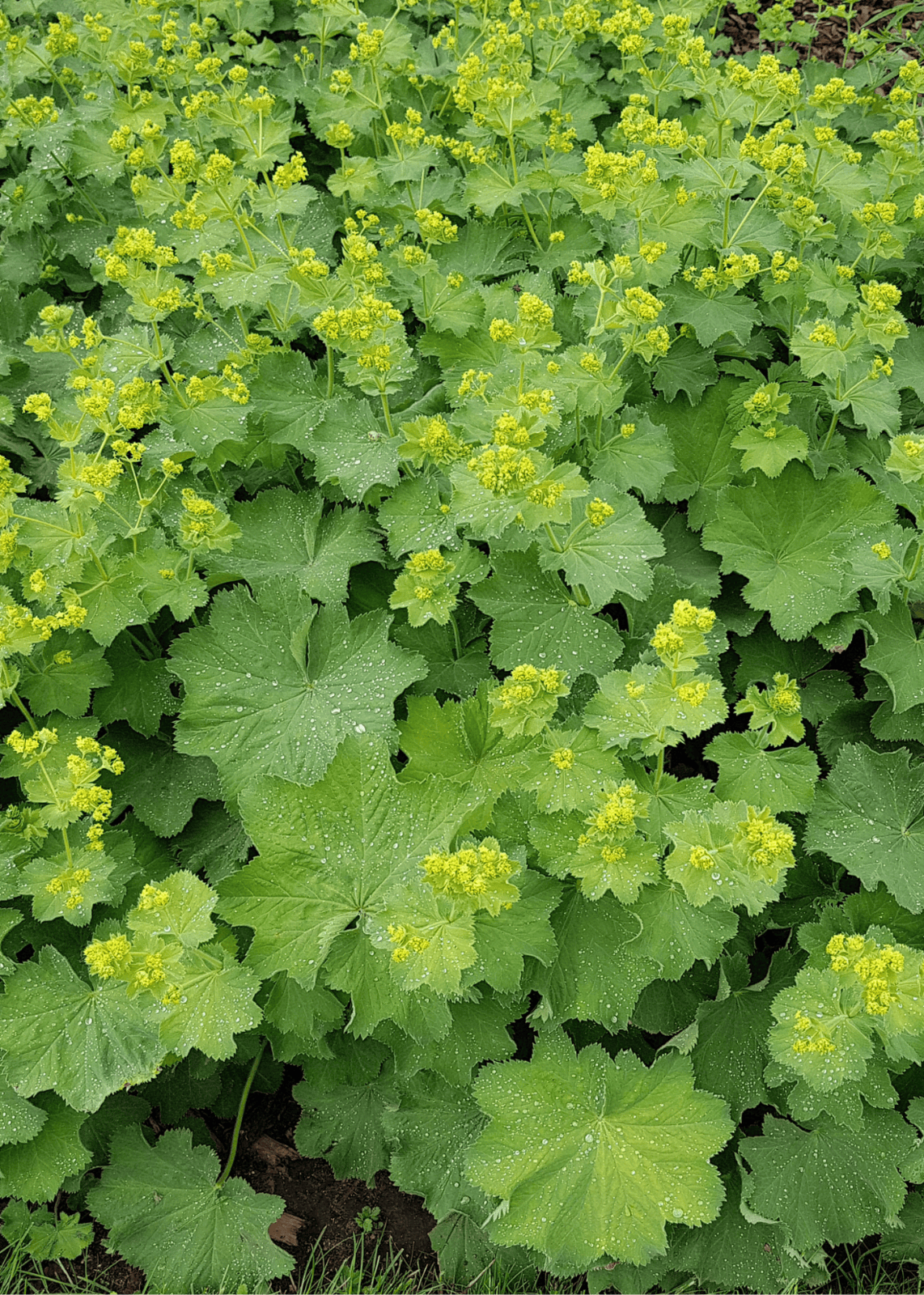
Lady's mantle
Alchemilla vulgaris (Rosaceae)
Lady's mantle is a valuable herb for women's health, helping to alleviate menstrual cycle disorders and providing support during menopause. In folk medicine, it is used to prevent irregular periods, reduce excessive bleeding, and relieve menopausal symptoms, including hot flashes and increased sweating. Lady's mantle helps balance hormones, reducing mood swings and other symptoms of premenstrual syndrome (PMS). In addition, it can tone muscles, especially in the abdomen and pelvic area, which is especially useful after childbirth.
Health benefits: woman's cycle, postpartum period, menopause.
Chemical compounds: leaves and aerial parts contain tannins, flavonoids, glycosides, saponins, salicylic acid, essential oil, phytosterols.
Herbal action: astringent, anti-inflammatory, blood-clotting enhancing, diuretic, expectorant, regulating the menstrual cycle and metabolism.- Romm, A. (2017). Botanical Medicine for Women's Health (2nd ed.). St. Louis, MO: Elsevier.
- Herbal Monograph Alchemillae Herba - Alchemilla/Lady's Mantle. The Scientific Foundation for Herbal Medicinal Products, European Scientific Cooperative on Phytotherapy (ESCOP) (2003).
- Vlaisavljević S, Jelača S, Zengin G, Mimica-Dukić N, Berežni S, Miljić M, Stevanović ZD. Alchemilla vulgaris agg. (Lady's mantle) from central Balkan: antioxidant, anticancer and enzyme inhibition properties. RSC Adv. 2019 Nov 18;9(64):37474-37483. doi: 10.1039/c9ra08231j. PMID: 35542286; PMCID: PMC9075513.
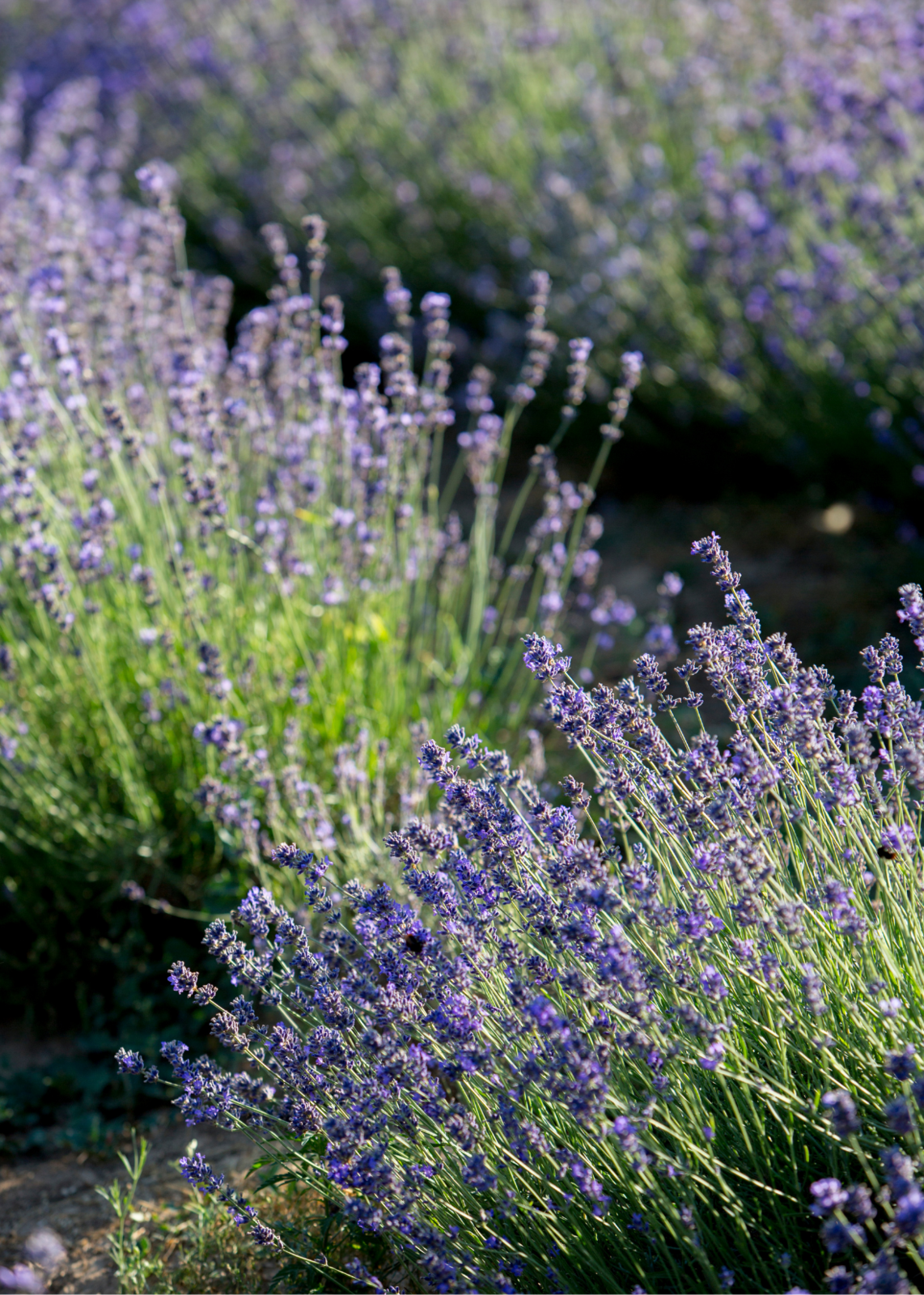
Lavender
Lavandula angustifolia (Lamiaceae)
Lavender is a medicinal herb whose health benefits are supported by both long-standing traditional use and scientific research. Lavender flowers and their essential oil are commonly used to alleviate mild symptoms of mental stress and exhaustion. They help calm the nervous system, reducing anxiety and nervousness while promoting emotional balance. Additionally, lavender is effective in promoting sleep, as its calming properties help the body relax and prepare for a good and deep sleep.
Health benefits: nervous system, sleep.
Chemical compounds: lavender flowers contain essential oil, flavonoids, triterpenoids, coumarins, tannins, anthocyanins, organic acids, and minerals.
Herbal action: calming, relaxing, spasmolytic, analgesic, choleretic, gas-reducing, and antibacterial effects.- European Medicines Agency. (2012). Final Community Herbal Monograph on Lavandula angustifolia P. Mill., flos. Retrieved from https://www.ema.europa.eu/en/documents/herbal-monograph/final-community-herbal-monograph-lavandula-angustifolia-p-mill-flos_en.pdf
- Romm, A. (2017). Botanical Medicine for Women's Health (2nd ed.). St. Louis, MO: Elsevier.
- Blumenthal, M., Goldberg, A., & Brinckmann, J. (Eds.). (1998). Lavender Flower: Commission E Monographs: Monographs on the Medicinal Uses of Plant Drugs. Austin, TX: American Botanical Council. Retrieved from https://www.herbalgram.org/resources/commission-e-monographs/monograph-approved-herbs/lavender-flower/
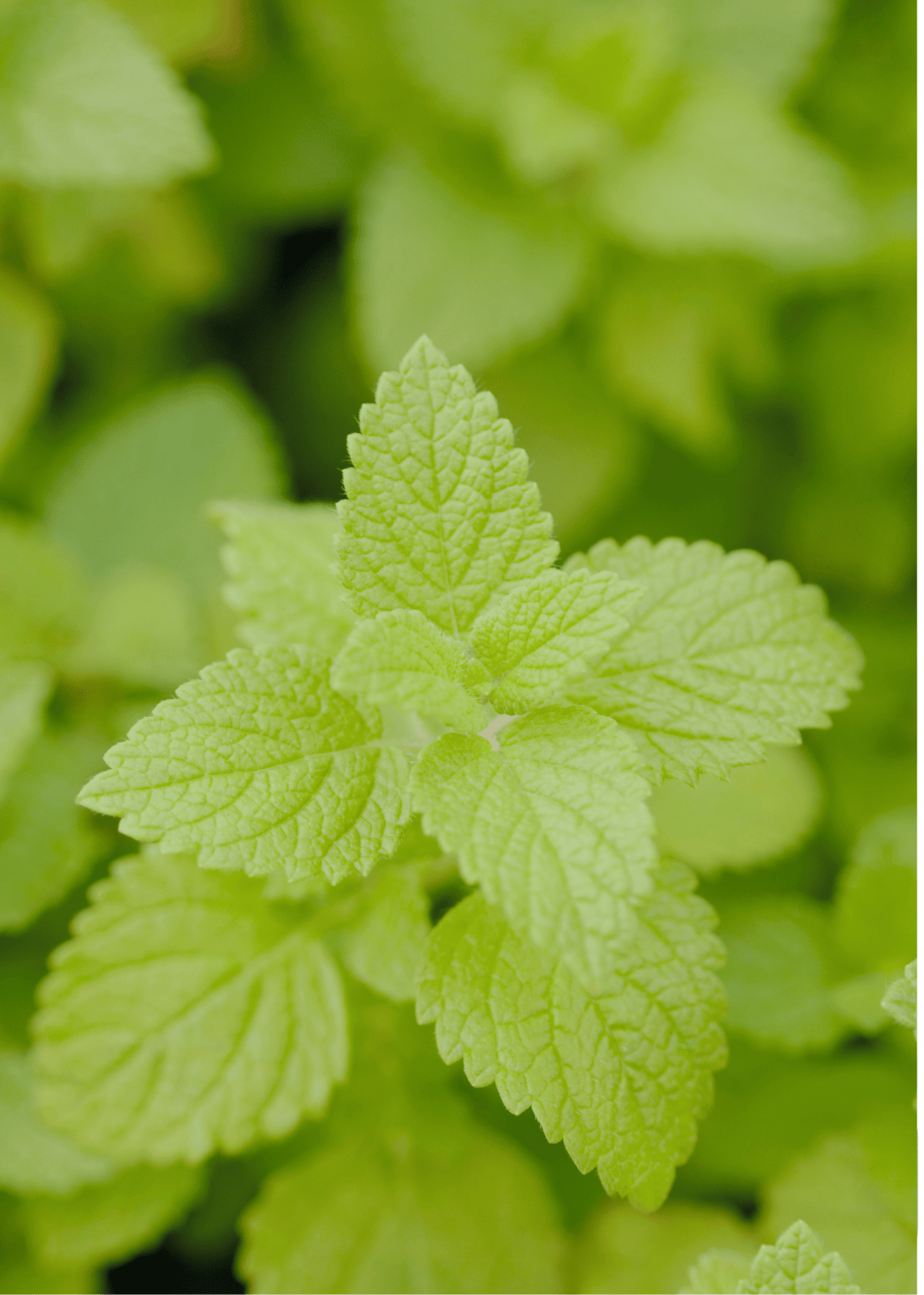
Lemon balm
Melissa officinalis (Lamiaceae)
Lemon balm is a plant with a light citrus aroma that strengthens the nervous system, reducing stress, anxiety and tension. Lemon balm facilitates sleep, and is also effective in reducing gastrointestinal disorders, including flatulence. Due to its antispasmodic action, lemon balm helps to relieve menstrual pain, and its calming properties can help stabilize heart rhythm and reduce palpitations, which often occur during menopause.
Health benefits: woman's cycle, menopause, nervous system, relaxation, sleep, digestion.
Chemical compounds: lemon balm leaves contain essential oil, which contains citral, neral, citronellal, flavonoids, monoterpene glycosides, hydroxycinnamic acid derivatives (caffeic acid, chlorogenic acid, rosmarinic acid), tannins, triterpenes.
Herbal action: antispasmodic, calming, sleep-promoting, lowers blood pressure, digestion-enhancing, reduces gas accumulation.- European Medicines Agency. (2013). Final Community Herbal Monograph on Melissa officinalis L., folium. Retrieved from https://www.ema.europa.eu/en/documents/herbal-monograph/final-community-herbal-monograph-melissa-officinalis-l-folium_en.pdf
- ESCOP. (2003). Melissa Leaf: ESCOP Monographs. The Scientific Foundation for Herbal Medicinal Products (2nd ed.). Exeter, UK: European Scientific Cooperative on Phytotherapy.
- Romm, A. (2017). Botanical Medicine for Women's Health (2nd ed.). St. Louis, MO: Elsevier.
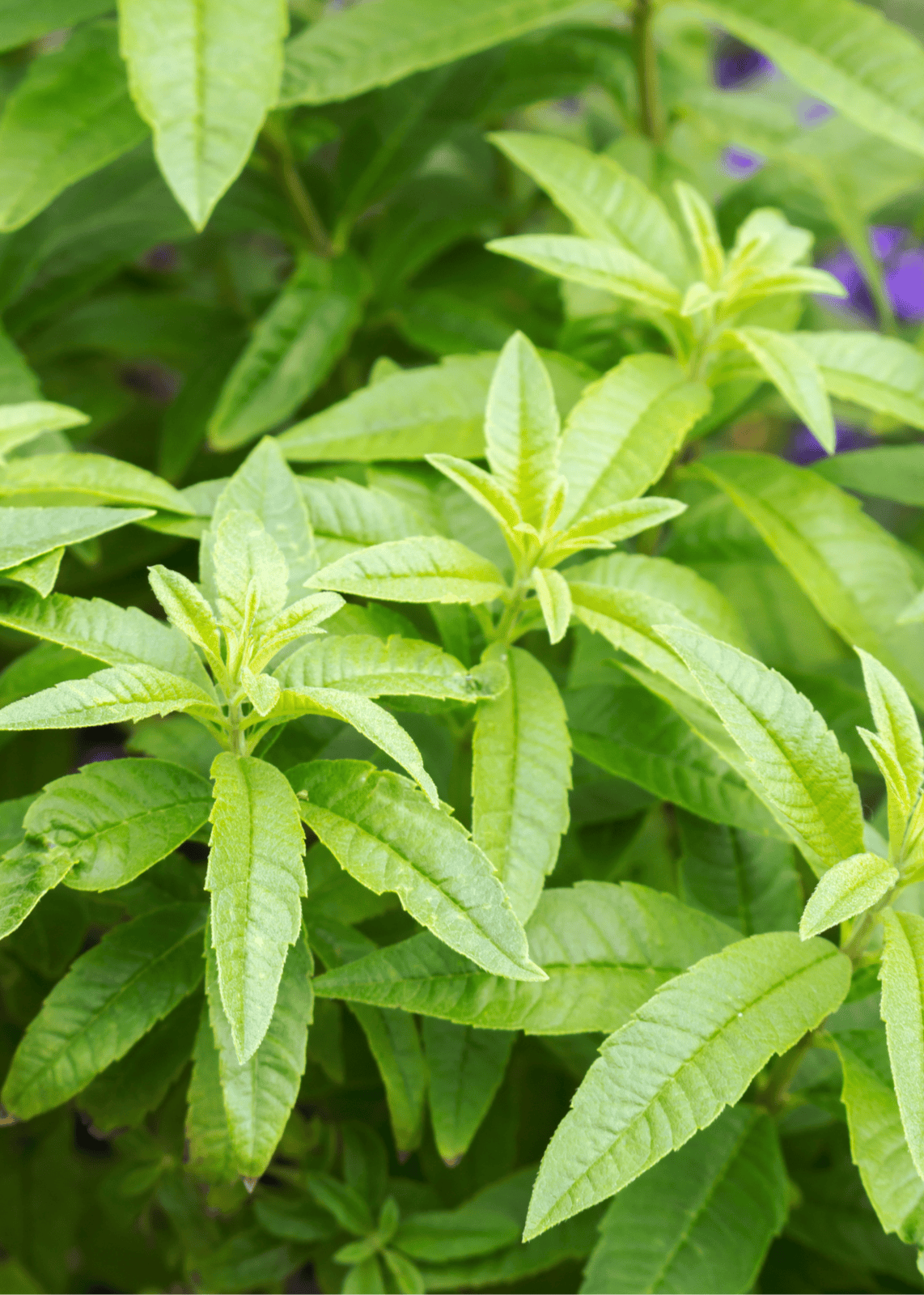
Lemon verbena
Aloysia citrodora (Verbenaceae)
Lemon verbena is an aromatic medicinal herb widely used to promote health due to its calming, anti-inflammatory, and digestion-enhancing properties. It helps reduce stress, anxiety, and improve sleep quality. Lemon verbena also supports the digestive system by relieving bloating and gas accumulation, easing stomach spasms, and stimulating appetite. Due to its antioxidant and anti-inflammatory effects, it strengthens the body’s defenses against oxidative stress and promotes overall well-being.
Health benefits: nervous system, digestion.
Chemical compounds: the leaves contain polyphenols, flavonoids (apigenin, luteolin), essential oil (citral, nerol, limonene), and iridoids.
Herbal action: calming, bloating- and gas-reducing, spasmolytic, appetite-stimulating, anti-inflammatory, antioxidant, antibacterial, antimicrobial, and toning effects.- European Medicines Agency. (2017). Final European Union Herbal Monograph on Aloysia citrodora Palau (syn. Aloysia triphylla (L'Hér.) Kuntze, Verbena triphylla L'Hér., Lippia citriodora Kunth), folium. Retrieved from https://www.ema.europa.eu/en/documents/herbal-monograph/final-european-union-herbal-monograph-aloysia-citrodora-palau-syn-aloysia-triphylla-lher-kuntze-verbena-triphylla-lher-lippia-citriodora-kunth-folium_en.pdf
- American Botanical Council. (2022). Lemon Verbena (Aloysia citrodora): Traditional Uses, Phytochemistry, and Biological Activities. HerbalGram, (136). Retrieved from https://www.herbalgram.org/resources/herbalgram/issues/136/table-of-contents/hg136-resrvw-lemonverbena/
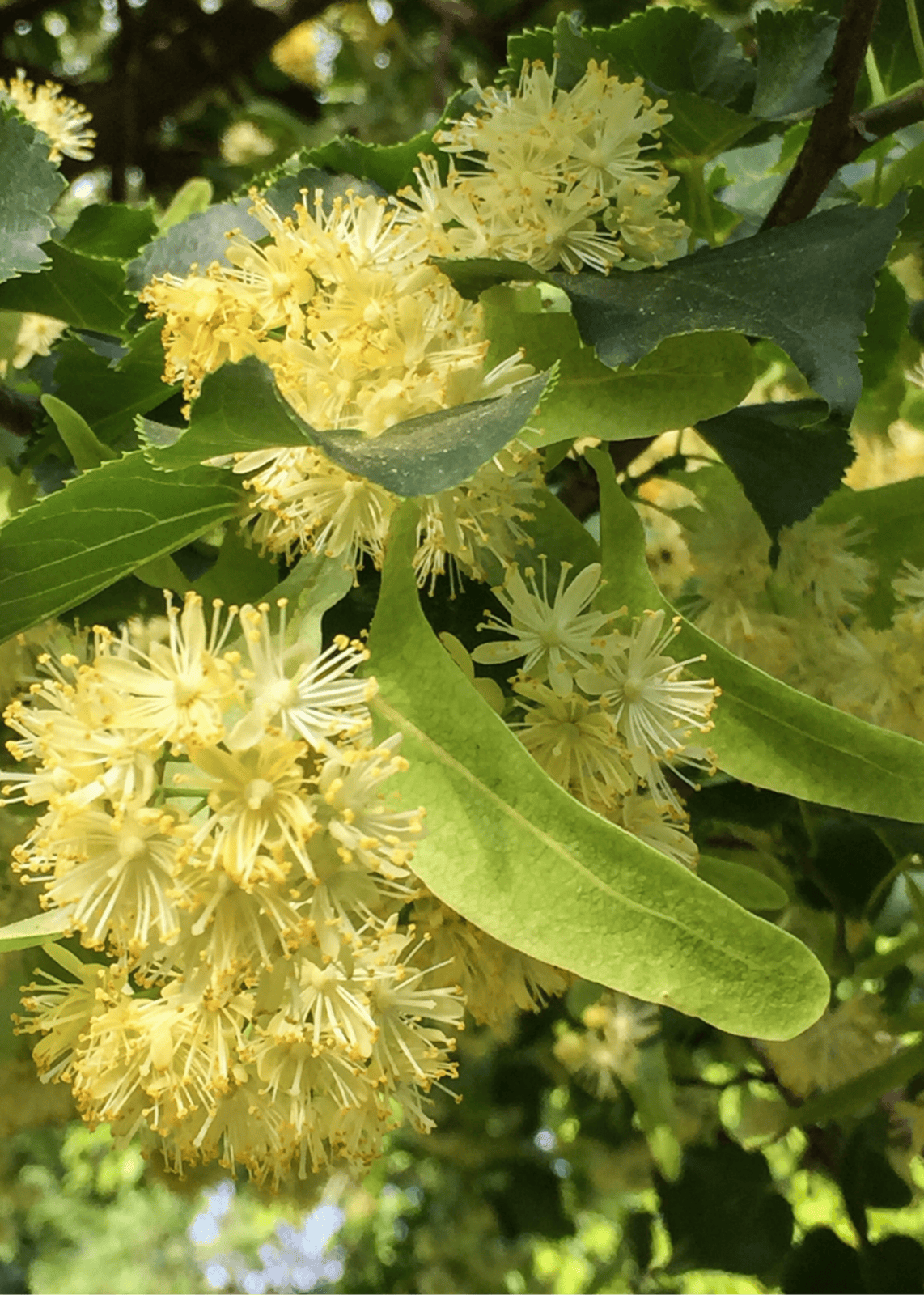
Linden
Tilia cordata (Tiliaceae)
Linden flowers are a valuable medicinal herb with proven properties to reduce moderate symptoms of nervous tension and colds. Linden flowers also have a mild diaphoretic and anti-inflammatory effect, which helps the body recover during illness. Tea made from linden flowers not only soothes and relieves symptoms of respiratory diseases, but is also very tasty, which is why many choose to drink it every day. However, it should be noted that long-term and continuous consumption of linden flower tea may cause heart rhythm disturbances. This is due to its diaphoretic (sweat-inducing) effect, which promotes the increased excretion of potassium from the body through sweat. Potassium is an essential electrolyte necessary for normal heart function, muscle contraction, and nerve impulse transmission.
Health benefits: nervous system, colds, body cleansing.
Chemical compounds: flowers contain polysaccharides (mucilages), flavonoids, essential oil, saponins, tannins.
Herbal action: diaphoretic, antipyretic, sedative, antispasmodic, diuretic, mild astringent effect.- European Medicines Agency. Final community herbal monograph on Tilia cordata Miller, Tilia platyphyllos Scop., Tilia x vulgaris Heyne, or their mixtures, flos (first version). Retrieved from https://www.ema.europa.eu/en/documents/herbal-monograph/final-community-herbal-monograph-tilia-cordata-miller-tilia-platyphyllos-scop-tilia-x-vulgaris-heyne-or-their-mixtures-flos-first-version_en.pdf
- Romm, A. (2017). Botanical Medicine for Women's Health (2nd ed.). St. Louis, MO: Elsevier.
- Kruk A, Granica S, Popowski D, Malinowska N, Piwowarski JP. Tiliae flos metabolites and their beneficial influence on human gut microbiota biodiversity ex vivo. J Ethnopharmacol. 2022 Aug 10;294:115355. doi: 10.1016/j.jep.2022.115355. Epub 2022 May 10. PMID: 35537603.
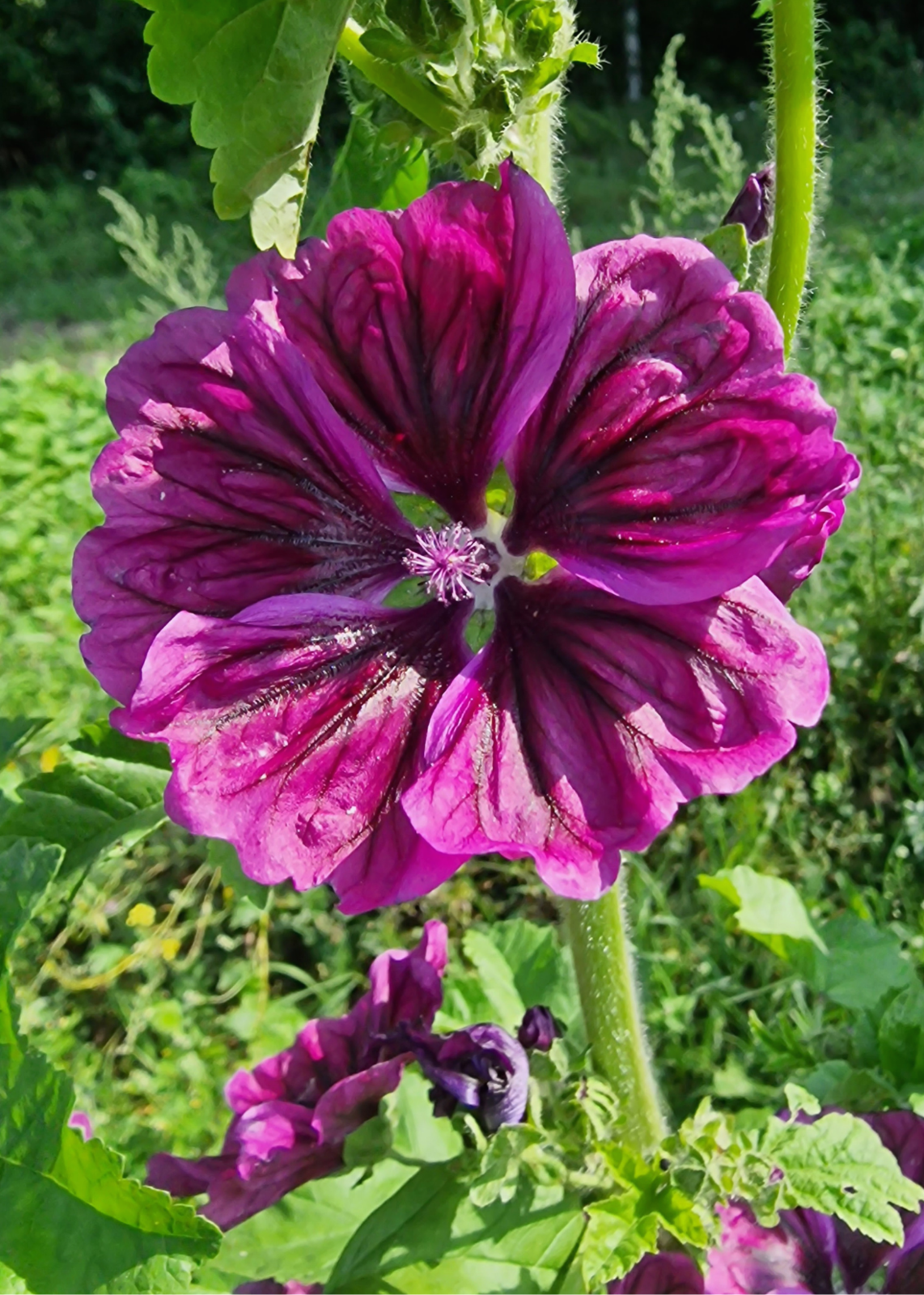
Mallow
Malva sylvestris (Malvaceae)
Long-standing use supports the effectiveness of mallow in relieving irritated and inflamed mouth and throat mucous membranes, as well as easing dry cough. It also acts as a soothing agent, helping to alleviate mild gastrointestinal mucosal irritation.
Health benefits: respiratory tract, digestion.
Chemical compounds: mallow flowers contain mucilage, flavonoids, organic acids, essential oil, and carotenoids. The leaves are rich in mucilage, flavonoids, phenolic acids, terpenoids, coumarins, carotenoids, ascorbic acid, and minerals.
Herbal action: anti-inflammatory, astringent, analgesic, antitussive, irritation-soothing, antimicrobial, and stool-softening effects.- European Medicines Agency. (2013). Final European Union Herbal Monograph on Malva sylvestris L., flos (first version). Retrieved from https://www.ema.europa.eu/en/documents/herbal-monograph/final-european-union-herbal-monograph-malva-sylvestris-l-flos-first-version_en.pdf
- European Medicines Agency. (2017). Final European Union Herbal Monograph on Malva sylvestris L. and/or Malva neglecta Wallr., folium (first version). Retrieved from https://www.ema.europa.eu/en/documents/herbal-monograph/final-european-union-herbal-monograph-malva-sylvestris-l-andor-malva-neglecta-wallr-folium-first-version_en.pdf
- ESCOP. (2003). Malva folium – Mallow Leaf: ESCOP Monographs. The Scientific Foundation for Herbal Medicinal Products (2nd ed.). Exeter, UK: European Scientific Cooperative on Phytotherapy.
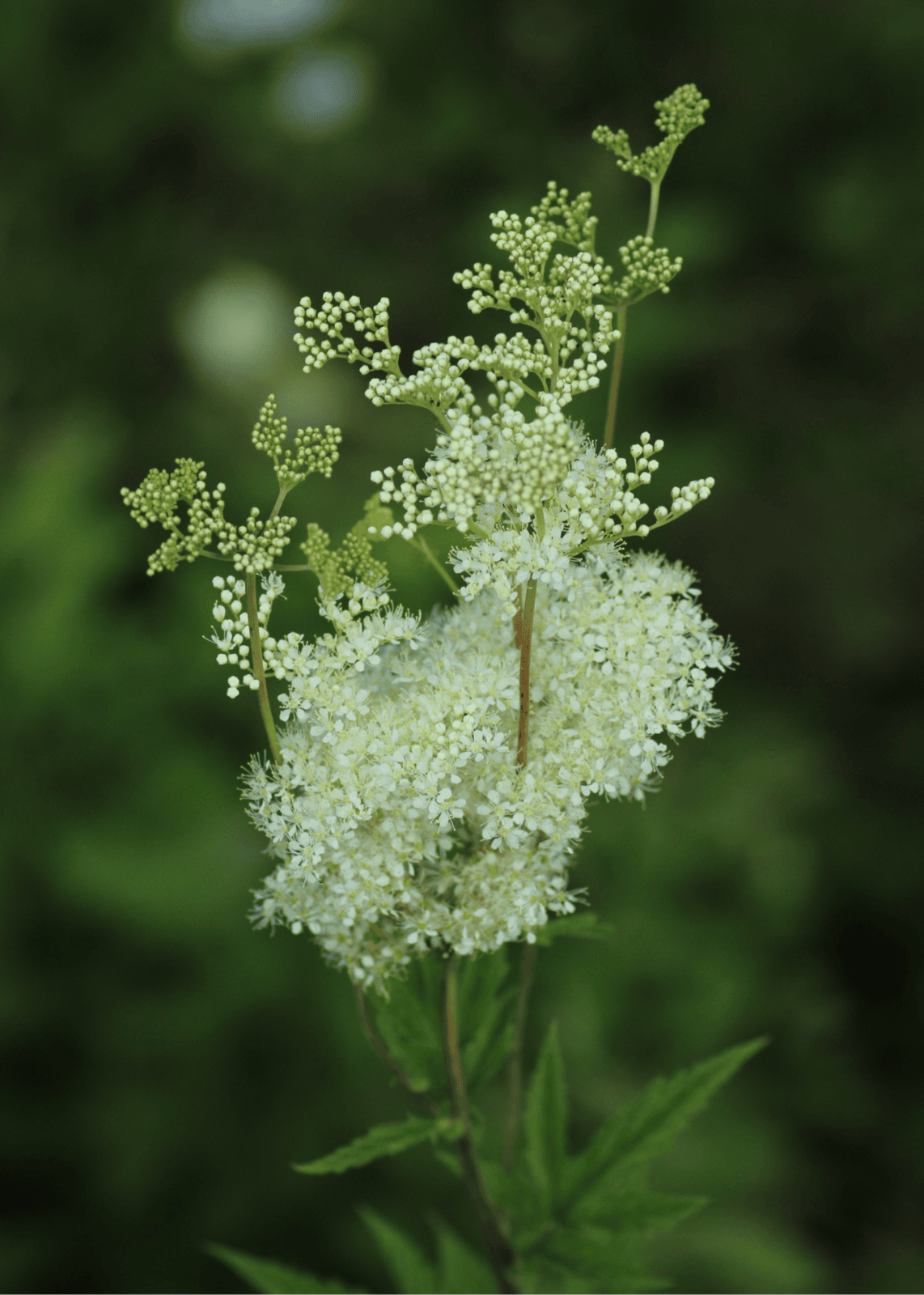
Meadowsweet
Filipendula ulmaria (Rosaceae)
Based on long-term experience, the use of meadowsweet has been proven to relieve colds and relieve minor joint pain. It is an excellent choice for stress-induced headaches and nervous tension, as well as for improving sleep. Do not use if you are hypersensitive to salicylates or concomitantly with other non-steroidal anti-inflammatory drugs.
Health benefits: nervous system, sleep, colds, joint health.
Chemical compounds: flowers and aerial parts contain flavonoids, essential oil, salicylates, as well as tannins, mucilage, sugars and ascorbic acid.
Herbal action: anti-inflammatory, diaphoretic, diuretic, astringent, analgesic, antiseptic and immune-boosting effect.- European Medicines Agency. (2011). Final Community herbal monograph on Filipendula ulmaria (L.) Maxim., flos (first version). Retrieved from https://www.ema.europa.eu/en/documents/herbal-monograph/final-community-herbal-monograph-filipendula-ulmaria-l-maxim-flos-first-version_en.pdf
- European Scientific Cooperative on Phytotherapy. Meadowsweet (Filipendula ulmaria). Retrieved from https://www.escop.com/downloads/meadowsweet/
- Bijttebier S, Van der Auwera A, Voorspoels S, Noten B, Hermans N, Pieters L, Apers S. A First Step in the Quest for the Active Constituents in Filipendula ulmaria (Meadowsweet): Comprehensive Phytochemical Identification by Liquid Chromatography Coupled to Quadrupole-Orbitrap Mass Spectrometry. Planta Med. 2016 Apr;82(6):559-72. doi: 10.1055/s-0042-101943. Epub 2016 Feb 4. PMID: 26845709.
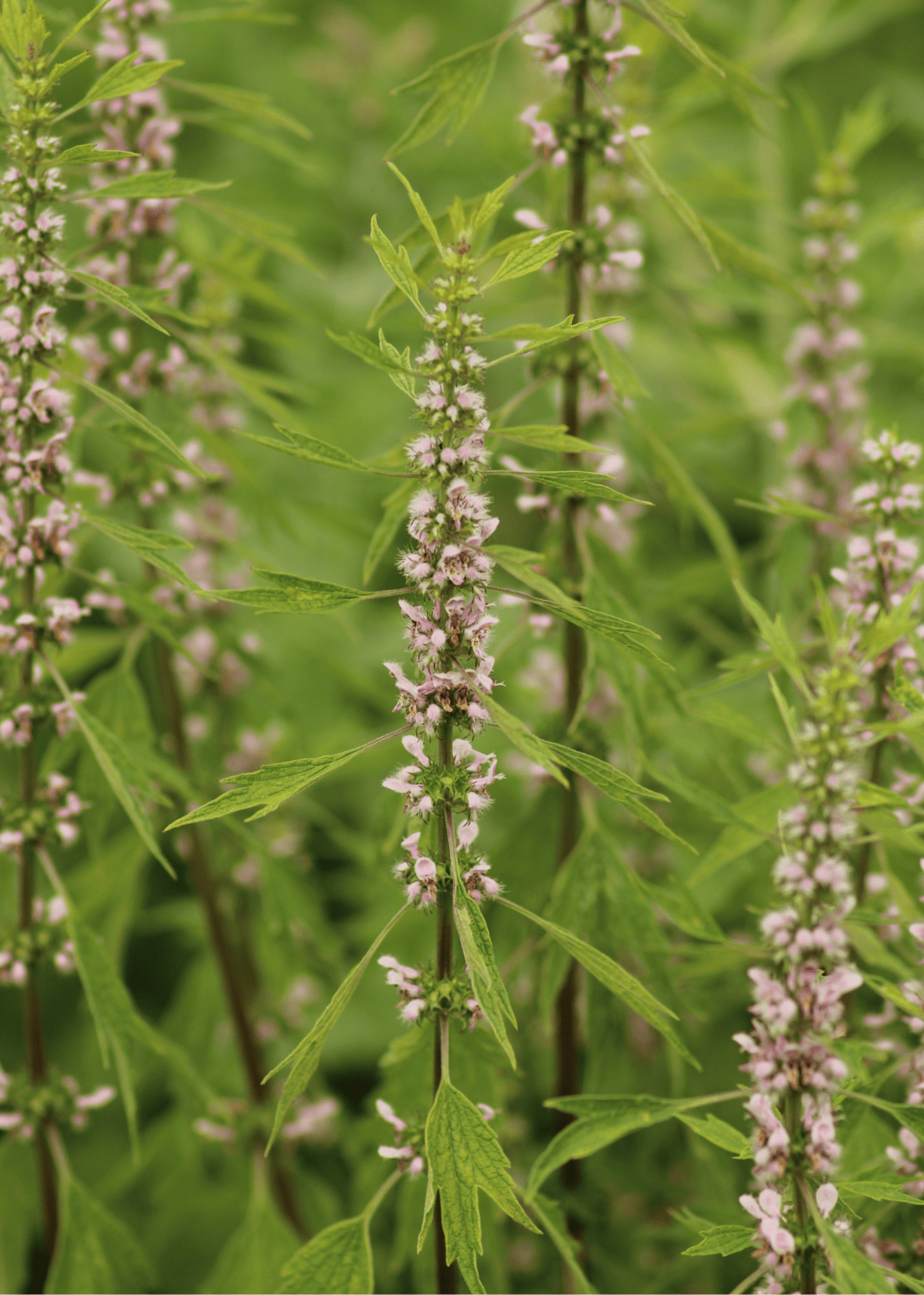
Motherwort
Leonurus cardiaca (Lamiaceae)
Based on long-term experience, motherwort has been proven to be effective in reducing symptoms of nervous tension and functional heart disorders, such as palpitations. Motherwort helps calm the heart and improve mood, especially in women suffering from anxiety or hormonal fluctuations.
Health benefits: nervous system, heart health.
Chemical compounds: the leaves contain the bitter iridoid leonurin, flavonoids, tannins and essential oil.
Herbal action: anti-inflammatory, blood pressure-lowering, heart rhythm-regulating, sedative, analgesic and antimicrobial effects, as well as reducing spasms, sleep disorders.- European Medicines Agency. (2013). Final community herbal monograph on Leonurus cardiaca L., herba. Retrieved from https://www.ema.europa.eu/en/documents/herbal-monograph/final-community-herbal-monograph-leonurus-cardiaca-l-herba_en.pdf
- European Scientific Cooperative on Phytotherapy. (2019, March 22). Leonuri cardiacae herba (Motherwort). ESCOP. Retrieved from https://www.escop.com/downloads/leonuri-cardiacae-herba-motherwort/
- Romm, A. (2017). Botanical Medicine for Women's Health (2nd ed.). St. Louis, MO: Elsevier.
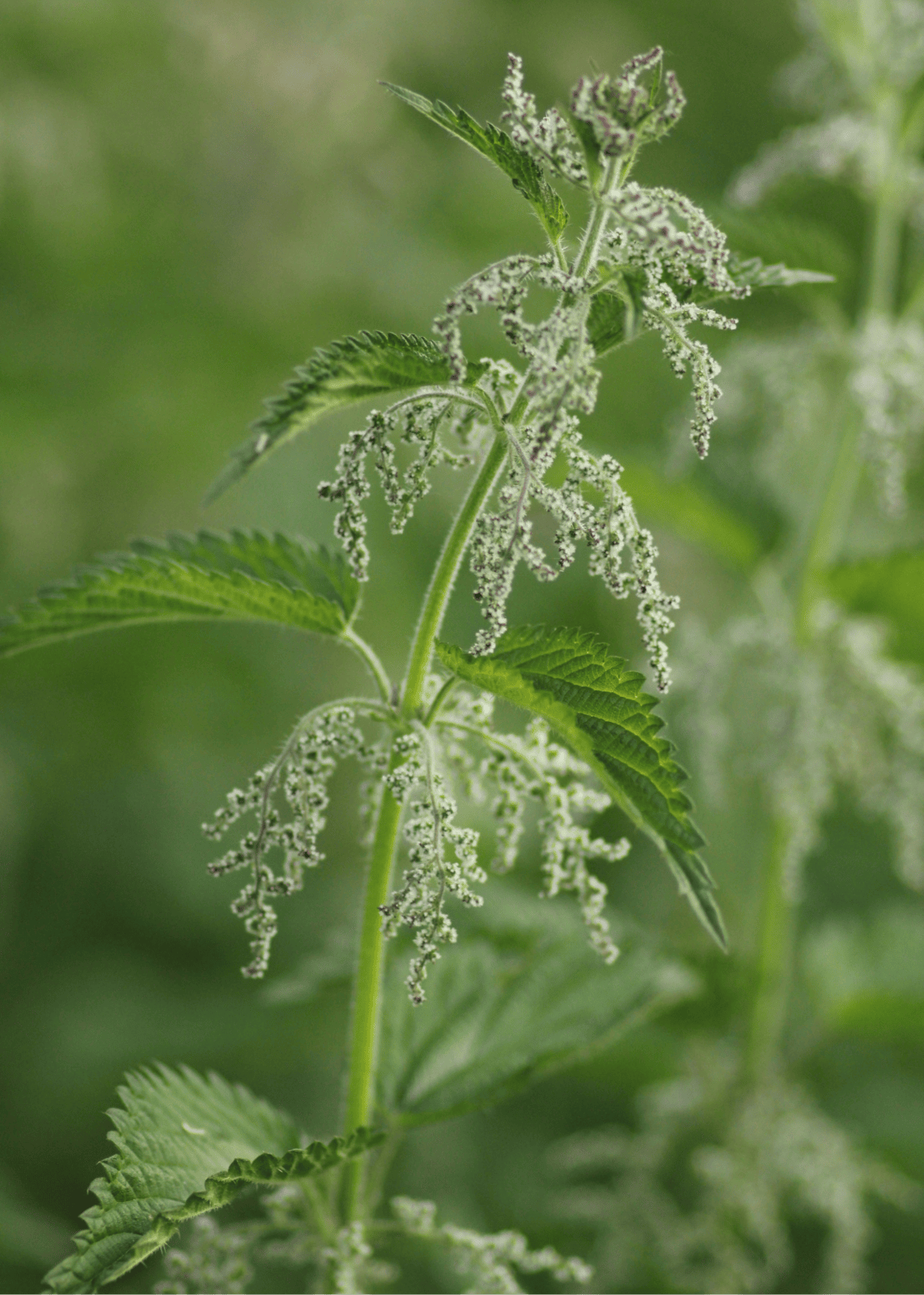
Nettle
Urtica dioica (Urticaceae)
Nettle is rich in vitamins and minerals. Known for its rejuvenating properties, nettle is especially useful for women at different stages of life, from the beginning of menstruation to menopause. It tones the smooth muscles of the uterus, relieves menstrual cycle problems such as PMS, excessive bleeding, anemia, fatigue, night sweats and edema. Nettle, due to its high iron content, helps to replenish iron reserves, and its astringent properties help to reduce excessive menstrual bleeding. The diuretic effect of nettle in mild cases of urinary tract diseases, its use for the relief of minor joint pain, and the symptomatic treatment of seborrhea (functional sebaceous gland disease) has been scientifically proven. The vitamin K in nettle leaves enhances blood clotting, so their use may weaken the effectiveness of anticoagulants, e.g., warfarin.
Health benefits: woman's cycle, joint health, water retention.
Chemical compounds: nettle leaves and aerial parts contain flavonoids, silicon compounds (SiO2), chlorophyll, carotenoids, coumarins, sterols, organic acids, vitamins (B group vitamins, ascorbic acid, vitamin K), minerals (magnesium, calcium, iron).
Herbal action: leaves and aerial parts have blood-clotting, hemostatic, anti-inflammatory, analgesic, antiallergic, and immune-boosting effects.- European Medicines Agency. Final community herbal monograph on Urtica dioica L., Urtica urens L., folium. Retrieved from https://www.ema.europa.eu/en/documents/herbal-monograph/final-community-herbal-monograph-urtica-dioica-l-urtica-urens-l-folium_en.pdf
- European Scientific Cooperative on Phytotherapy. Urticae folium/herba: Nettle leaf/herb. Retrieved from https://www.escop.com/downloads/urticae-folium-herba-nettle-leaf-herb/
- Romm, A. (2017). Botanical Medicine for Women's Health (2nd ed.). St. Louis, MO: Elsevier.
- Bhusal KK, Magar SK, Thapa R, Lamsal A, Bhandari S, Maharjan R, Shrestha S, Shrestha J. Nutritional and pharmacological importance of stinging nettle (Urtica dioica L.): A review. Heliyon. 2022 Jun 22;8(6):e09717. doi: 10.1016/j.heliyon.2022.e09717. PMID: 35800714; PMCID: PMC9253158.
- Devkota HP, Paudel KR, Khanal S, Baral A, Panth N, Adhikari-Devkota A, Jha NK, Das N, Singh SK, Chellappan DK, et al. Stinging Nettle (Urtica dioica L.): Nutritional Composition, Bioactive Compounds, and Food Functional Properties. Molecules. 2022; 27(16):5219. https://doi.org/10.3390/molecules27165219
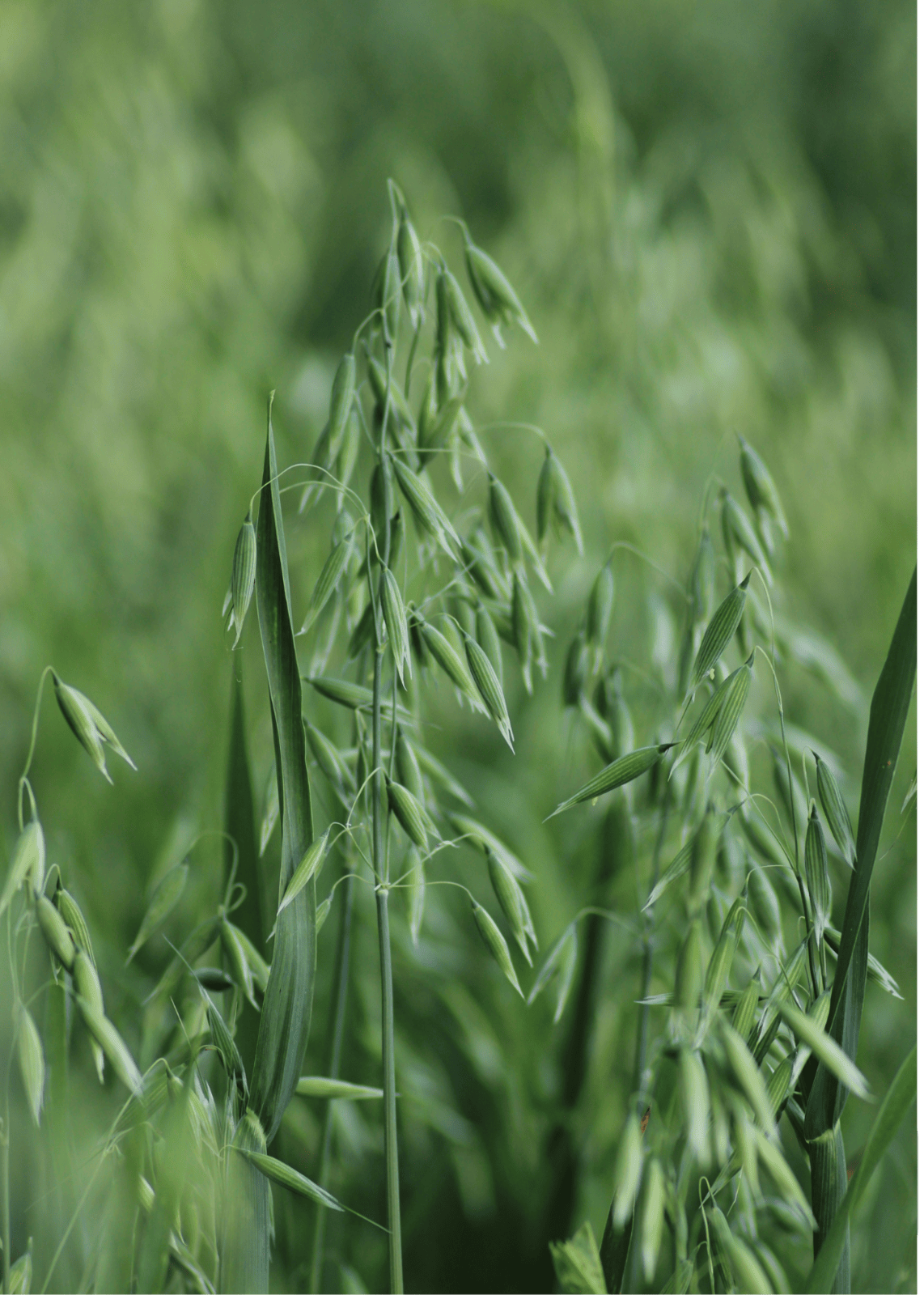
Oat
Avena sativa (Poaceae)
Oat is rich in nutrients and minerals and has a calming effect. Oat tops are beneficial for reducing nervous tension and improving sleep. They have a mild, hay-like, slightly sweet taste and pair well with adaptogens and other calming herbs such as lemon balm, chamomile, and motherwort.
Health benefits: nervous system, sleep, valuable source of minerals and vitamins.
Chemical compounds: the aerial parts contain carbohydrates (beta-glucans, sucrose), nitrogen-containing carboxylic acids, saponins, flavonoids, and minerals such as calcium, magnesium, iron, potassium, and zinc.
Herbal action: anti-inflammatory, calming, blood sugar-lowering, protective, soothing, anti-itch, and wound-healing effects.- European Medicines Agency. (2011). Final Community Herbal Monograph on Avena sativa L., herba. Retrieved from https://www.ema.europa.eu/en/documents/herbal-monograph/final-community-herbal-monograph-avena-sativa-l-herba_en.pdf
- Romm, A. (2017). Botanical Medicine for Women's Health (2nd ed.). St. Louis, MO: Elsevier
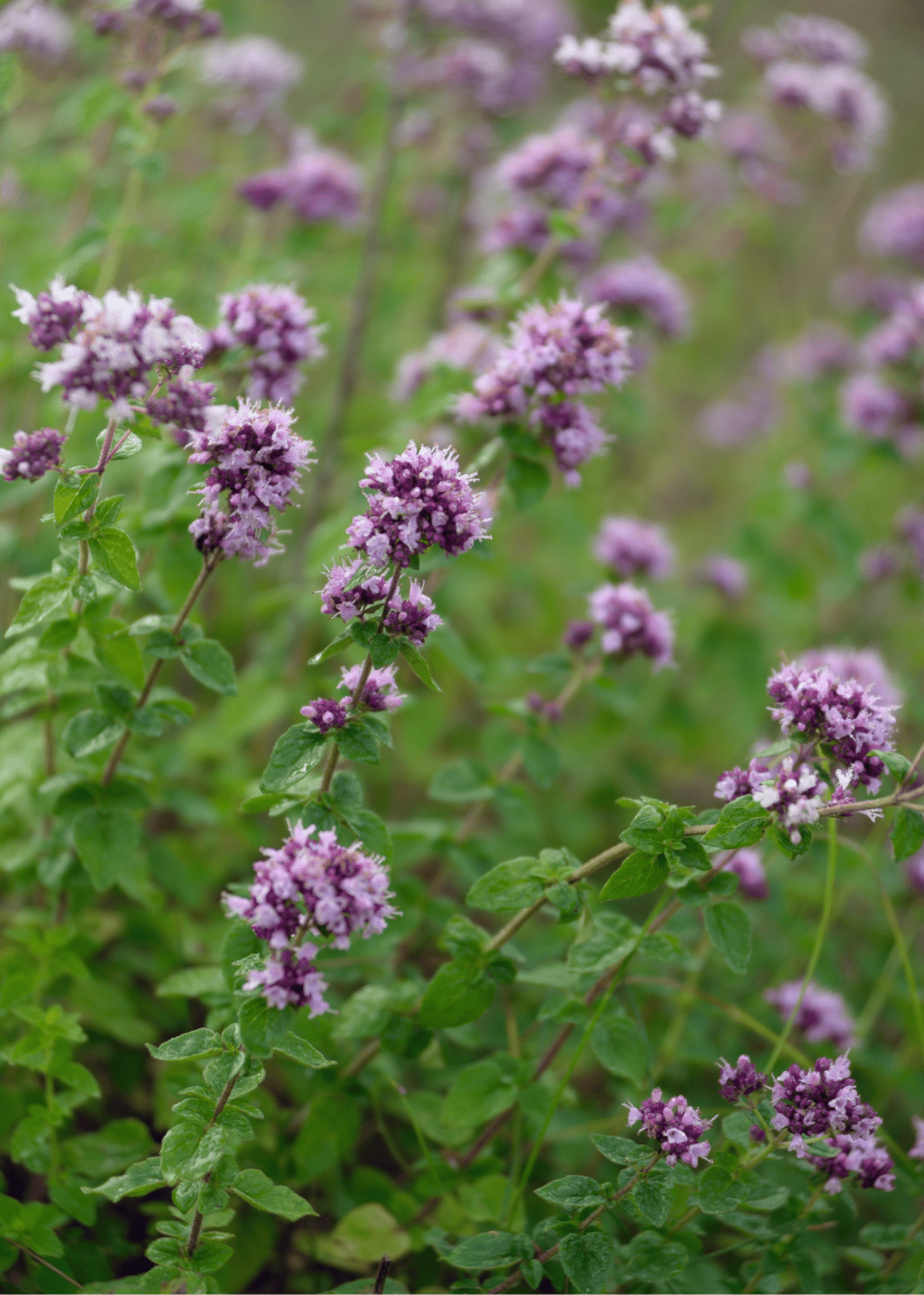
Oregano
Origanum vulgare (Lamiaceae)
Oregano supports digestion by reducing bloating, gas accumulation, and intestinal spasms. It is beneficial for respiratory conditions, easing coughs, promoting mucus discharge, and reducing inflammation during colds. Its antimicrobial and anti-inflammatory properties help combat bacteria, viruses, and fungi, while its antioxidants boost immunity and reduce oxidative stress. Oregano is also used to improve mood and as an antiseptic mouth rinse.
Health benefits: digestion, respiratory tract.
Chemical compounds: the aerial parts contain essential oil, flavonoids, bitter compounds, tannins, triterpene compounds, minerals, and ascorbic acid.
Herbal action: digestion-enhancing, bile-secretion-promoting, expectorant, calming, anti-inflammatory, spasmolytic, diuretic, diaphoretic, and antibacterial effects.- Veenstra JP, Johnson JJ. Oregano (Origanum vulgare) extract for food preservation and improvement in gastrointestinal health. Int J Nutr. 2019;3(4):43-52. doi: 10.14302/issn.2379-7835.ijn-19-2703. Epub 2019 Apr 9. PMID: 31080888; PMCID: PMC6508890.
- Romm, A. (2017). Botanical Medicine for Women's Health (2nd ed.). St. Louis, MO: Elsevier.
- Association for the Advancement of Restorative Medicine. Oregano (Origanum vulgare) Monograph. Retrieved from https://restorativemedicine.org/library/monographs/oregano/
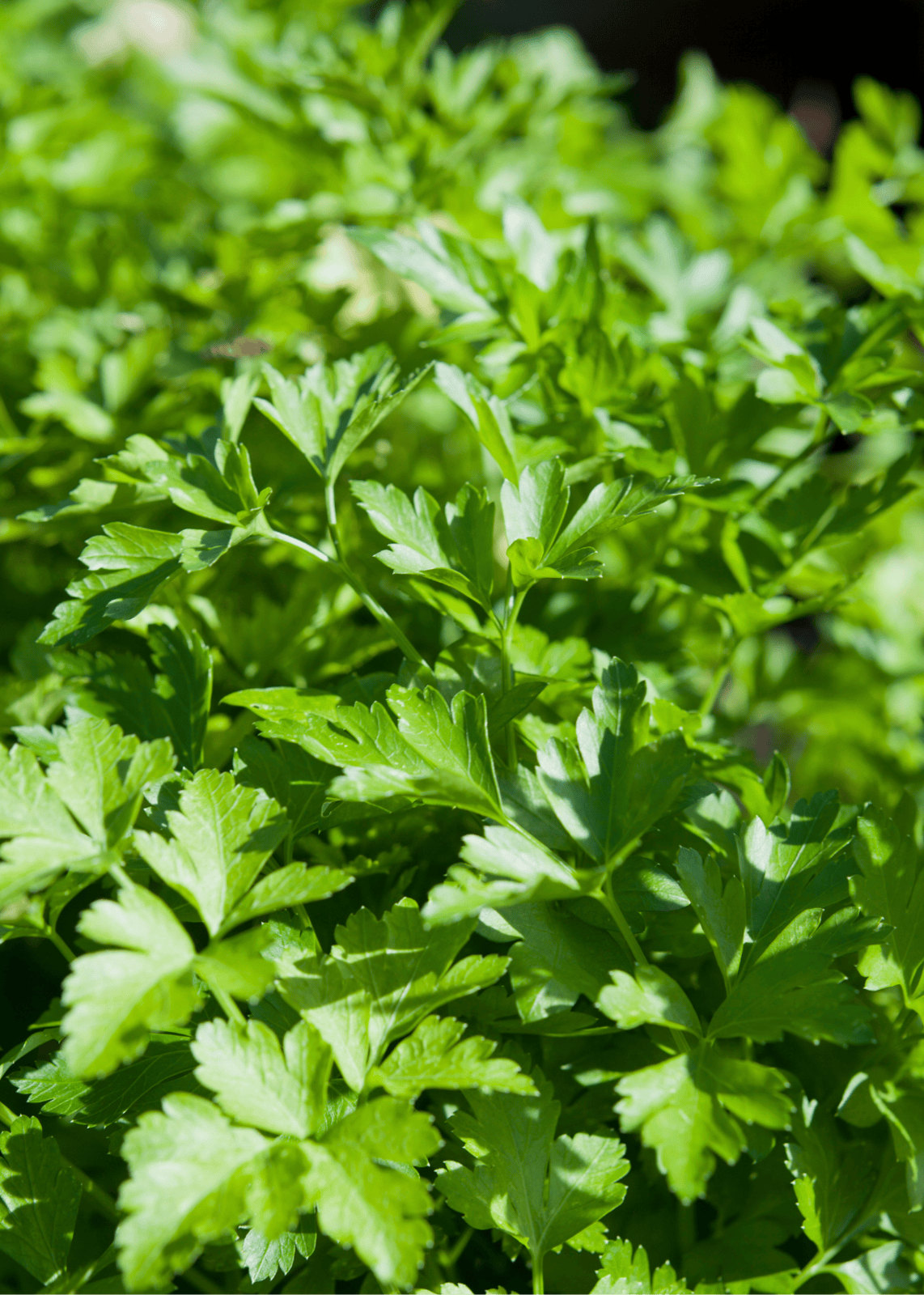
Parsley
Petroselinum crispums (Apiaceae)
Parsley leaves stimulate digestion, help reduce bloating and gas accumulation, and support kidney function due to their diuretic properties. Parsley is rich in antioxidants such as flavonoids and ascorbic acid, which boost immunity and protect cells from oxidative stress. Additionally, parsley is used to reduce milk production, making it beneficial for women transitioning their babies away from breastfeeding. However, parsley should be avoided during pregnancy, as it can stimulate uterine contractions and pose potential risks.
Health benefits: during weaning from breastfeeding, digestion, urinary tract health.
Chemical compounds: the leaves contain essential oil, furanocoumarins, flavonoids, carotenoids, B-group vitamins, vitamin PP, ascorbic acid, and minerals.
Herbal action: the leaves have diuretic, analgesic, anti-inflammatory, spasmolytic, digestion-enhancing, gas-reducing, and menstruation-stimulating effects.- Blumenthal, M., Goldberg, A., & Brinckmann, J. (Eds.). (1998). Parsley Herb and Root: Commission E Monographs: Monographs on the Medicinal Uses of Plant Drugs. Austin, TX: American Botanical Council. Retrieved from https://www.herbalgram.org/resources/commission-e-monographs/monograph-approved-herbs/parsley-herb-and-root
- Romm, A. (2017). Botanical Medicine for Women's Health (2nd ed.). St. Louis, MO: Elsevier.
- Eglash A. Treatment of maternal hypergalactia. Breastfeed Med. 2014 Nov;9(9):423-5. doi: 10.1089/bfm.2014.0133. PMID: 25361472; PMCID: PMC4216483.
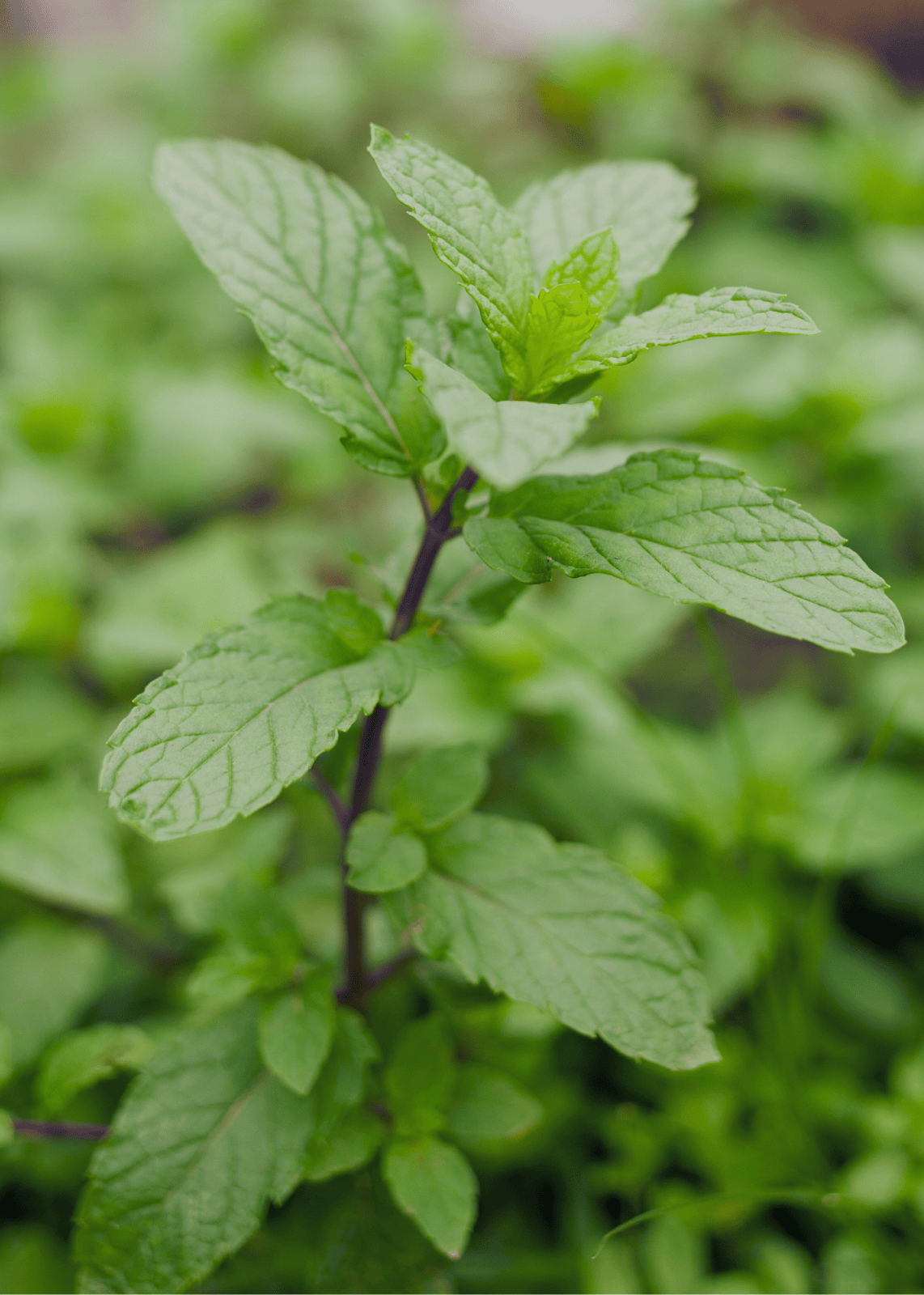
Peppermint
Mentha x piperita (Lamiaceae)
Based on long-term experience, the use of peppermint has been proven to relieve digestive disorders (dyspepsia, flatulence). The essential oil is used orally to relieve spasms and pain in the gastrointestinal tract, on the skin to relieve headaches, muscle pain and skin itching, as well as inhaled to relieve cough and cold symptoms. Due to menthol, peppermint has a strong cooling effect. Menthol acts on thermoreceptors, creating a cooling sensation. Nursing mothers should be cautious with the use of peppermint, as it can reduce milk secretion. Although the effect of menthol on lactation in humans has not been fully proven, it is used to reduce milk secretion when weaning a baby from the breast. During pregnancy, peppermint can help relieve nausea. If necessary, it is recommended to use it in the first trimester. However, caution should be exercised, as excessive use of peppermint can cause heartburn. Do not use if you are hypersensitive to menthol, have acid reflux, gallstones or other biliary tract disorders.
Health benefits: 1st trimester of pregnancy, nervous system, digestion.
Chemical compounds: the leaves are rich in essential oil, the main components of which are menthol and its esters, also contain flavonoids, phenolic acids.
Herbal action: antispasmodic, choleretic, analgesic, anti-inflammatory, gas-reducing, expectorant, antibacterial, antiallergic effect.- European Medicines Agency). European Union herbal monograph on Mentha x piperita L., folium (revision 1). Retrieved from https://www.ema.europa.eu/en/documents/herbal-monograph/european-union-herbal-monograph-mentha-x-piperita-l-folium-revision-1_en.pdf
- Romm, A. (2017). Botanical Medicine for Women's Health (2nd ed.). St. Louis, MO: Elsevier.
- McKay DL, Blumberg JB. A review of the bioactivity and potential health benefits of peppermint tea (Mentha piperita L.). Phytother Res. 2006 Aug;20(8):619-33. doi: 10.1002/ptr.1936. PMID: 16767798.
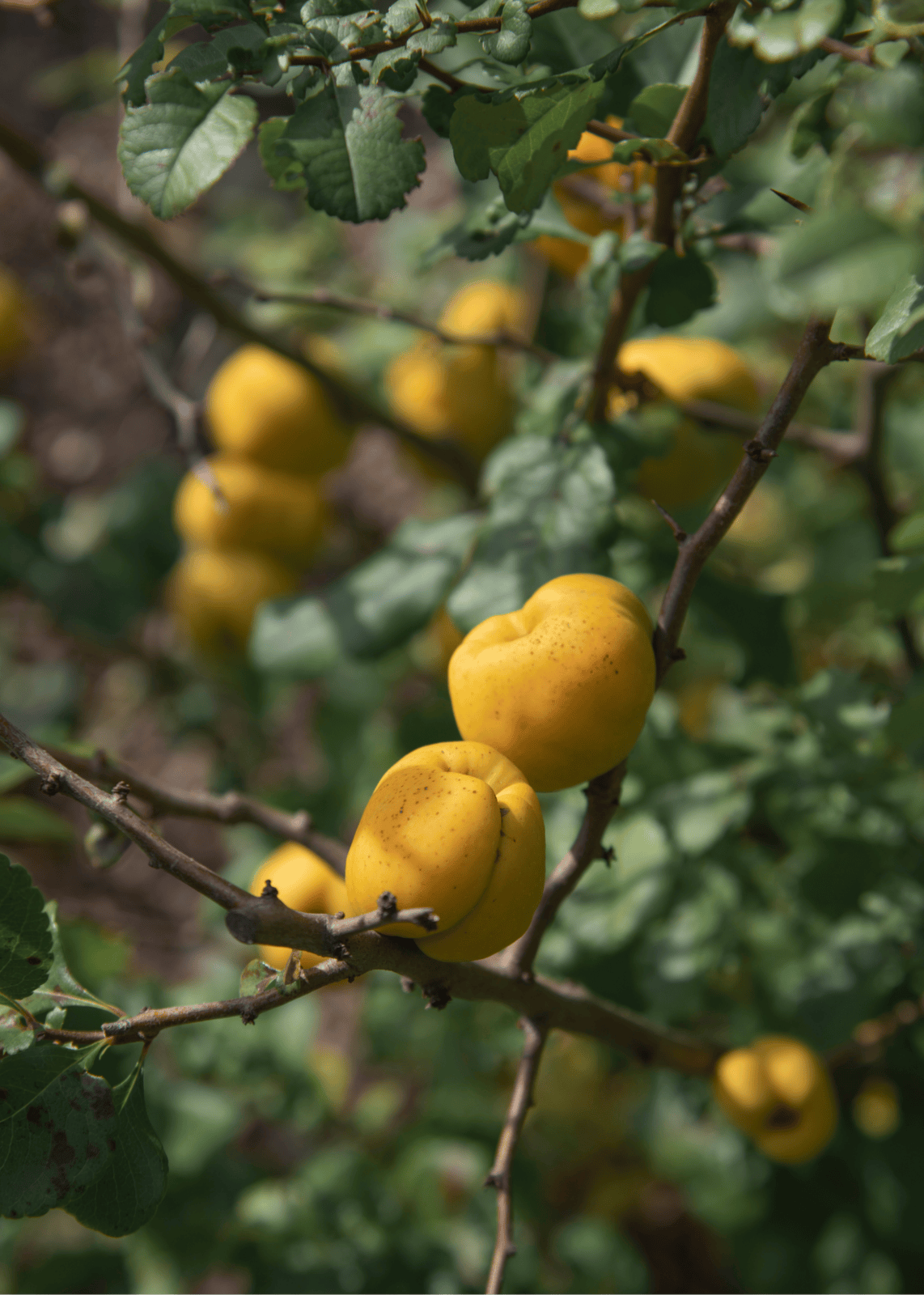
Quince
Cydonia oblonga (Rosaceae)
The fruits of the quince are rich in vitamins, especially vitamin C, as well as minerals such as potassium and magnesium, which support the immune system and help maintain cardiovascular health. Quinces are also used to improve digestion, thanks to their fiber and tannin content, which help reduce bloating and enhance intestinal function. In traditional medicine, quince fruits are used to relieve respiratory conditions and reduce cough.
Health benefits: valuable source of minerals and vitamins, immunity, digestion.
Chemical compounds: the fruits contain fiber, tannins, flavonoids, phenolic acids, vitamins (especially vitamin C), minerals (potassium, magnesium), and antioxidants.
Herbal action: anti-inflammatory, antioxidant, digestion-enhancing, respiratory-supporting, and immune-boosting effects.- American Botanical Council. (2023). Quince (Cydonia oblonga): Traditional Uses, Phytochemistry, and Modern Research. HerbalEGram, 21(1). Retrieved from https://www.herbalgram.org/resources/herbalegram/volumes/volume-21/issue-1-january/news-and-features-2/fam-quince/
- Kostecka-Gugała A. Quinces (Cydonia oblonga, Chaenomeles sp., and Pseudocydonia sinensis) as Medicinal Fruits of the Rosaceae Family: Current State of Knowledge on Properties and Use. Antioxidants (Basel). 2024 Jan 3;13(1):71. doi: 10.3390/antiox13010071. PMID: 38247495; PMCID: PMC10812678.
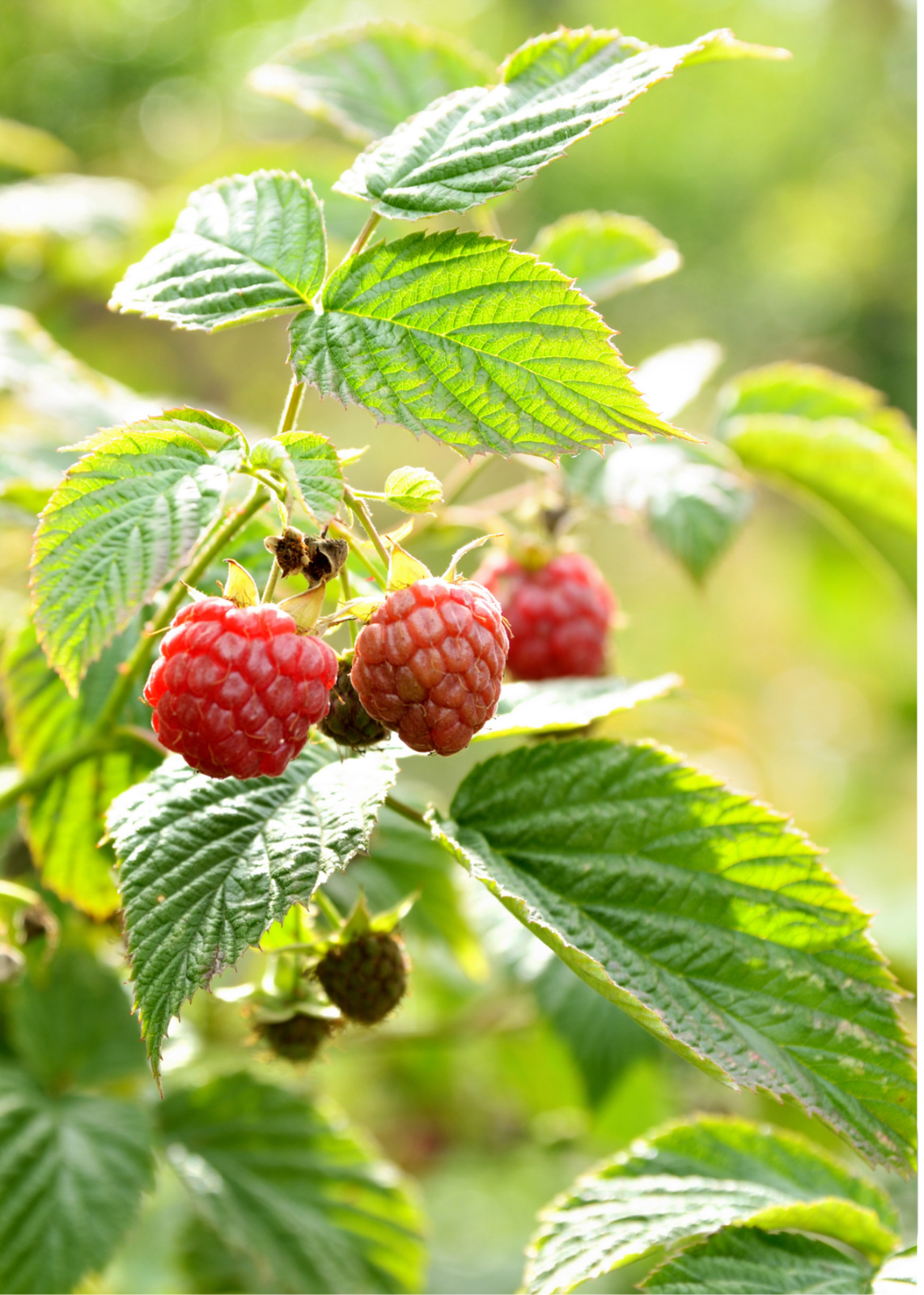
Raspberry
Rubus idaeus (Rosaceae)
Based on long-term experience, the use of wild raspberries for menstrual pain relief has been proven. Raspberry leaves are used to prepare the uterine muscles for childbirth. Wild raspberry leaf tea is recommended from the 37th week of pregnancy. Raspberry fruits are a valuable source of bioactive compounds, including vitamins, minerals, antioxidants, and dietary fiber. Their rich composition supports immune system function, promotes digestive health, and helps maintain overall body well-being.
Health benefits: woman's cycle, 3rd trimester of pregnancy, childbirth, first weeks of postpartum.
Chemical compounds: wild raspberry leaves contain tannins, flavonoids, essential oil, terpenoids, ascorbic acid, vitamin E, minerals and phenolic acids, which together provide a strong healing effect. Berries contain sugars, pectins, flavonoids, pigments from the anthocyanin group, vitamins P, E, and B group, organic acids (malic acid, citric acid, tartaric acid), sterols, and minerals.
Herbal action: astringent, uterine muscle tonic, labor-relieving, analgesic and painful menstruation-reducing (spasmolytic) effect. Raspberry fruits possess antioxidant, anti-inflammatory, and immune-boosting properties.- European Medicines Agency. (2012). Final Community Herbal Monograph on Rubus idaeus L., folium. Retrieved from https://www.ema.europa.eu/en/documents/herbal-monograph/final-community-herbal-monograph-rubus-idaeus-l-folium_en.pdf
- Romm, A. (2017). Botanical Medicine for Women's Health (2nd ed.). St. Louis, MO: Elsevier.
- American Botanical Council. (2023). Raspberry (Rubus idaeus): A Fruit and Leaf with Traditional and Modern Uses. HerbalEGram, 20(9). Retrieved from https://www.herbalgram.org/resources/herbalegram/volumes/volume-20/issue-9-september/news-and-features-3/fam-raspberry/
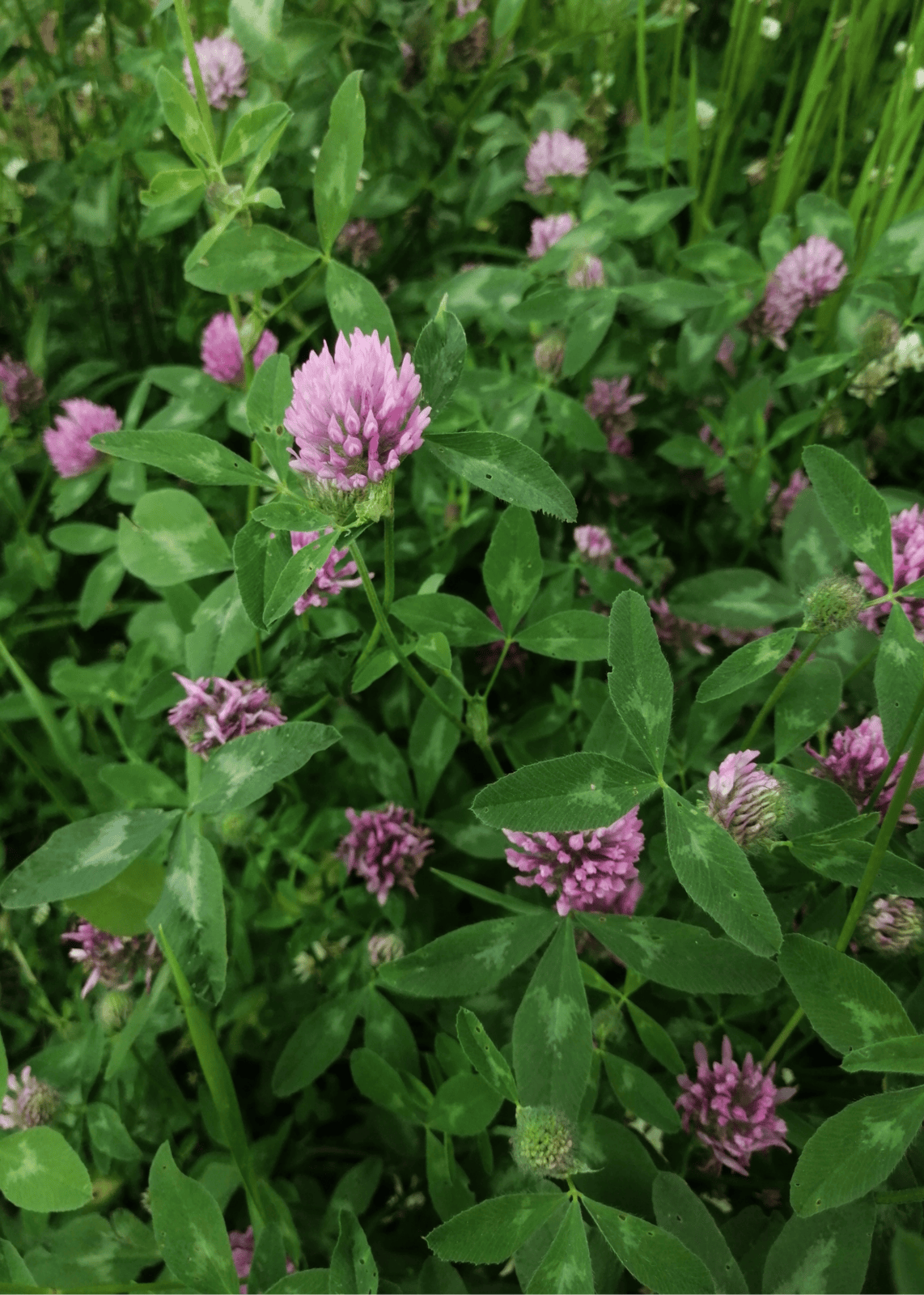
Red clover
Trifolium pratense (Fabaceae)
Red clover is a valuable herb rich in phytoestrogens – natural compounds that mimic the effects of estrogen in the body. These properties make red clover particularly beneficial for women, as it can help balance the hormonal system and regulate the menstrual cycle. During menopause, red clover can reduce symptoms such as hot flashes, increased sweating, insomnia and mood swings, promoting overall well-being and emotional balance. Red clover also has anti-inflammatory and cleansing properties, which help improve skin health and support the immune system.
Health benefits: woman's cycle, menopause, body cleansing, skin health.
Chemical compounds: red clover flowers contain flavonoids, coumarins, carotenoids, tannins and vitamins.
Herbal action: expectorant, diaphoretic, anti-inflammatory, skin cleansing, diuretic, analgesic, metabolism-improving, estrogenic effects.- Romm, A. (2017). Botanical Medicine for Women's Health (2nd ed.). St. Louis, MO: Elsevier.
- Mohsen A, Fatemeh K, Leila N, Mona P, Mohammad Z, Mozafar K. Pharmacological and therapeutic properties of the Red Clover (Trifolium pratense L.): an overview of the new finding. J Tradit Chin Med. 2021 Aug;41(4):642-649. doi: 10.19852/j.cnki.jtcm.20210324.001. PMID: 34392659.
- Budryn G, Gałązka-Czarnecka I, Brzozowska E, Grzelczyk J, Mostowski R, Żyżelewicz D, Cerón-Carrasco JP, Pérez-Sánchez H. Evaluation of estrogenic activity of red clover (Trifolium pratense L.) sprouts cultivated under different conditions by content of isoflavones, calorimetric study and molecular modelling. Food Chem. 2018 Apr 15;245:324-336. doi: 10.1016/j.foodchem.2017.10.100. Epub 2017 Oct 20. Erratum in: Food Chem. 2018 Jul 1;253:323. doi: 10.1016/j.foodchem.2018.02.042. PMID: 29287378.
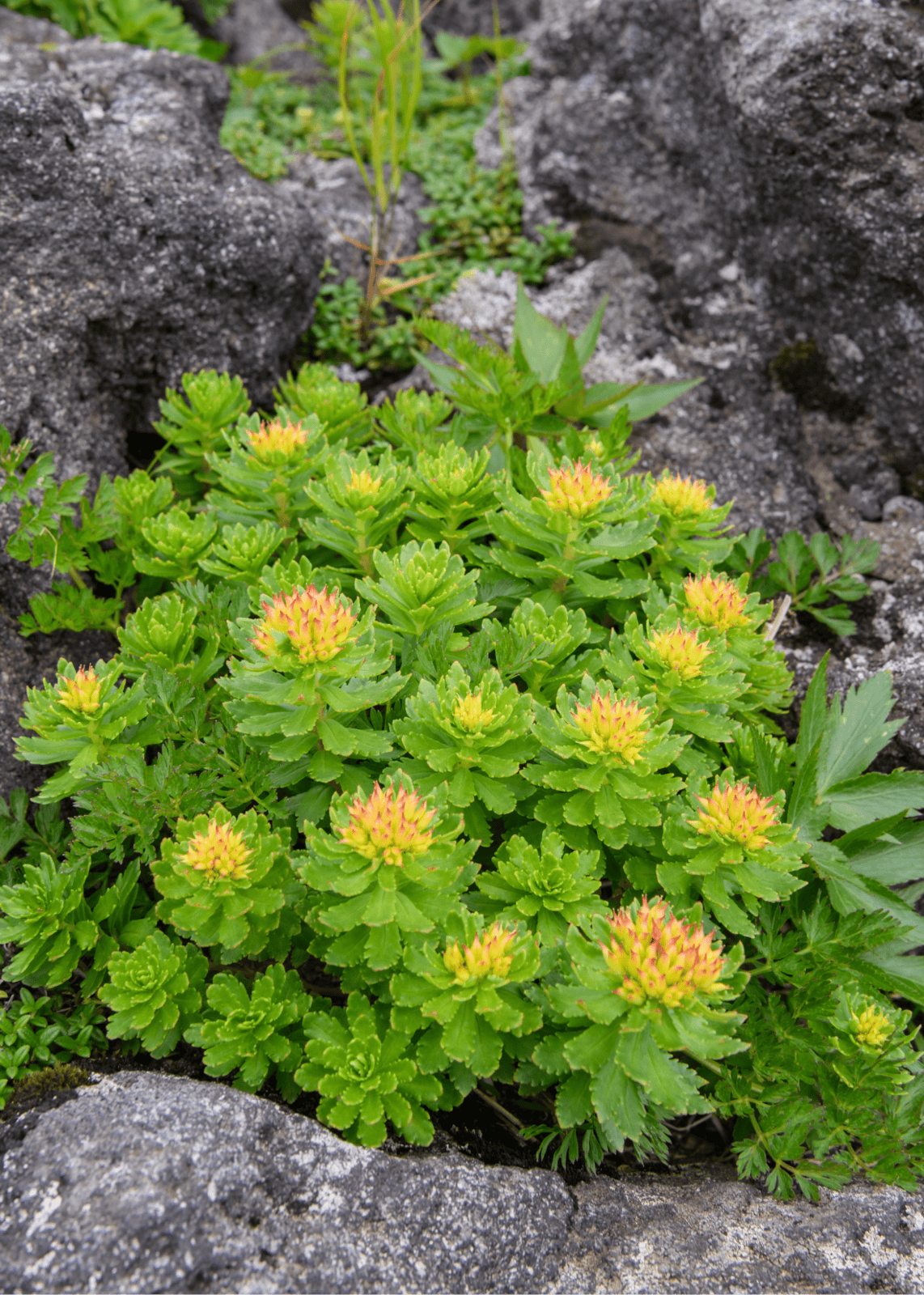
Rhodiola
Rhodiola rosea (Crassulaceae)
Rhodiola is known as an adaptogen widely used to help the body adapt to physical and emotional stress. It effectively reduces stress-related symptoms such as fatigue, exhaustion, and concentration difficulties often caused by prolonged stress. Rhodiola supports energy metabolism and restores the body's balance, promoting overall resilience and vitality. Additionally, it strengthens the body's defenses by enhancing immune function and reducing oxidative stress, helping to protect against adverse environmental conditions and viral infections. Its use is particularly beneficial for relieving PMS symptoms and supporting women during menopause by helping maintain emotional and physical balance.
Health benefits: woman's cycle, menopause, nervous system, immune defenses, digestion.
Chemical compounds: the rhizomes contain essential oil, phenylpropanoids (rosavin, rosarin, rosine), flavolignans, flavonoids, sterols, organic acids, and minerals.
Herbal action: adaptogenic, psychostimulant, performance-enhancing, metabolism-regulating, and hemostatic effects.- European Medicines Agency. (2021). Final European Union Herbal Monograph on Rhodiola rosea L., rhizoma et radix (revision 1). Retrieved from https://www.ema.europa.eu/en/documents/herbal-monograph/final-european-union-herbal-monograph-rhodiola-rosea-l-rhizoma-et-radix-revision-1_en.pdf
- Ivanova Stojcheva E, Quintela JC. The Effectiveness of Rhodiola rosea L. Preparations in Alleviating Various Aspects of Life-Stress Symptoms and Stress-Induced Conditions-Encouraging Clinical Evidence. Molecules. 2022 Jun 17;27(12):3902. doi: 10.3390/molecules27123902. PMID: 35745023; PMCID: PMC9228580.
- Romm, A. (2017). Botanical Medicine for Women's Health (2nd ed.). St. Louis, MO: Elsevier.
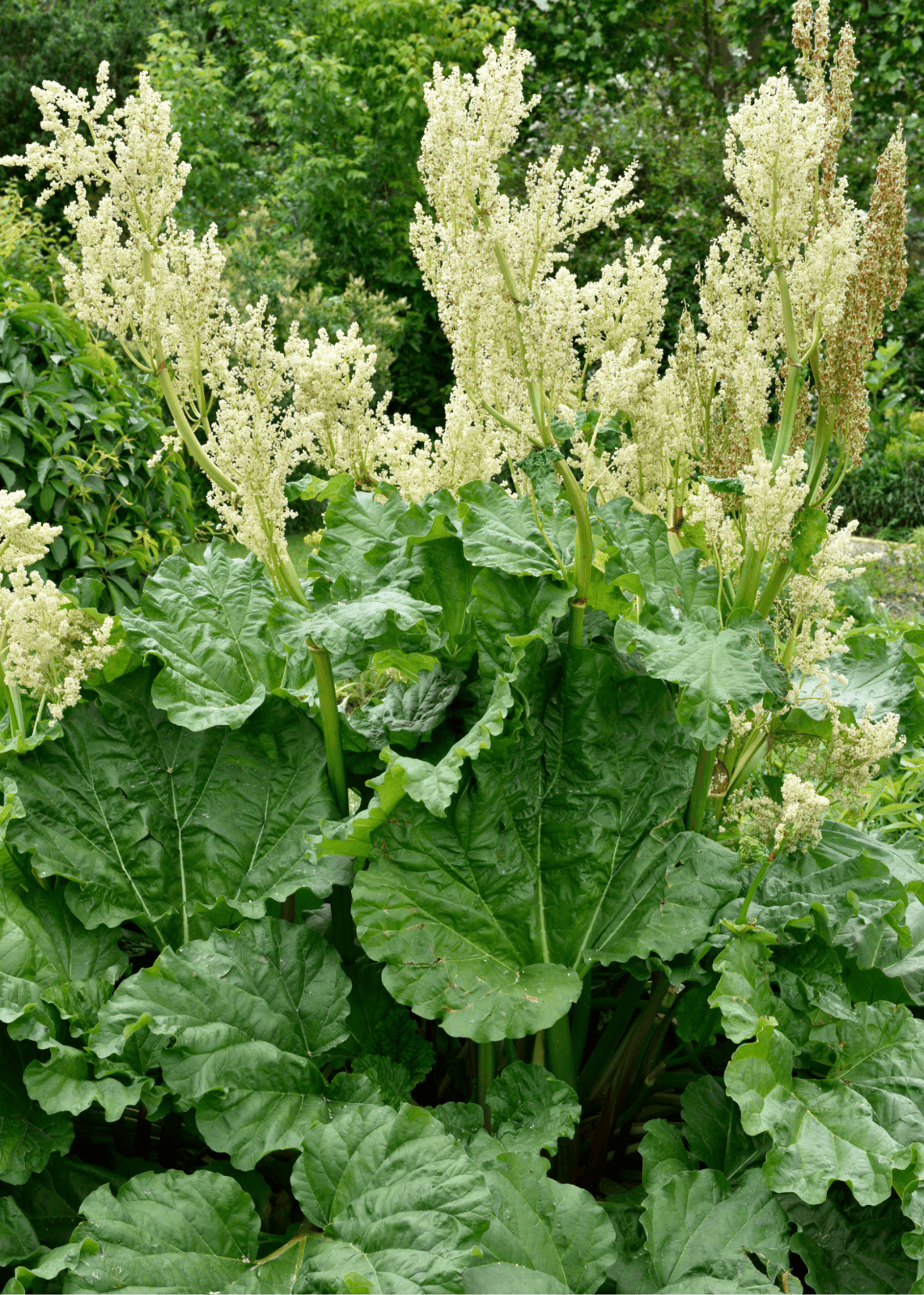
Rhubarb
Rheum rhaponticum (Polygonaceae)
Rhubarb stalks are traditionally used to support the digestive system by promoting appetite, reducing bloating, and improving digestion, as well as having anti-inflammatory and antimicrobial properties. Rhubarb stalks contain valuable nutrients such as vitamins (C vitamin, K vitamin), minerals (potassium, magnesium), and fiber, which help improve bowel function. Rhubarb has a sour taste with a refreshing note.
Health benefits: digestion, valuable source of minerals and vitamins.
Chemical compounds: the stalks contain fiber, phenolic acids, flavonoids, vitamins (especially vitamin C), minerals (potassium, magnesium), organic acids, and antioxidants.
Herbal action: digestion-enhancing, anti-inflammatory, antimicrobial, antioxidant, and appetite-stimulating effects.- Cao, YJ., Pu, ZJ., Tang, YP. et al. Advances in bio-active constituents, pharmacology and clinical applications of rhubarb. Chin Med 12, 36 (2017). https://doi.org/10.1186/s13020-017-0158-5
- Kolodziejczyk-Czepas, J., Liudvytska, O. Rheum rhaponticum and Rheum rhabarbarum: a review of phytochemistry, biological activities and therapeutic potential. Phytochem Rev 20, 589–607 (2021). https://doi.org/10.1007/s11101-020-09715-3
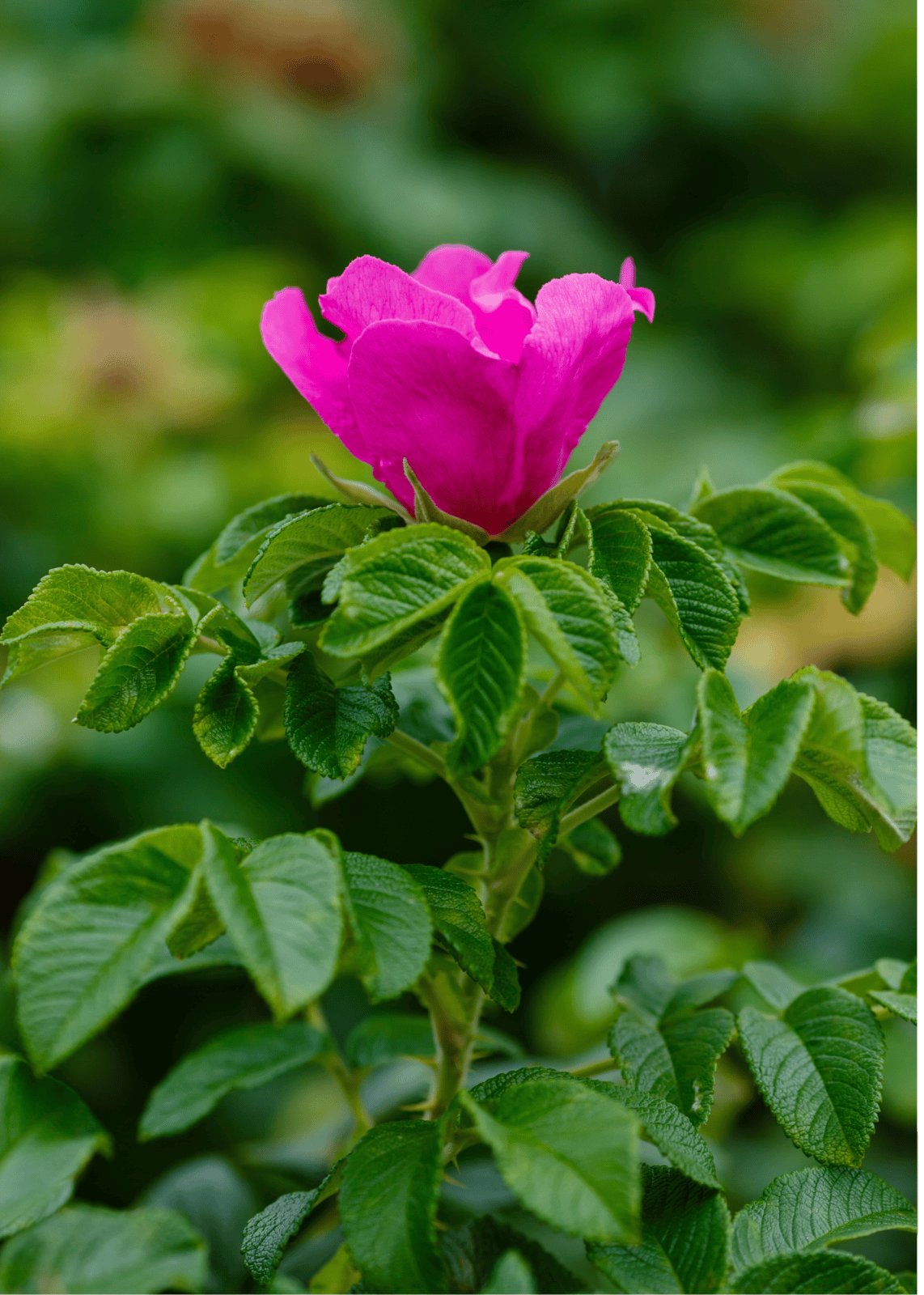
Roses
Rosa spp. (Rosaceae)
Health benefits: fertility, nervous system, digestion, colds, skin health.
Chemical compounds: the flowers contain essential oil, flavonoids, and anthocyanins. The fruits contain ascorbic acid (vitamin C), vitamin P, B2, E, K, carotenoids, flavonoids, anthocyanins, sugars, pectins, organic acids, tannins, and minerals.
Herbal action: the flowers have anti-inflammatory, calming, relaxing, analgesic, and antiseptic effects. The fruits enhance immune defenses and support the health of the respiratory, digestive, and urinary systems.- European Medicines Agency. (2011). Final Community herbal monograph on Rosa gallica L., Rosa centifolia L., Rosa damascena Mill., flos. Retrieved from https://www.ema.europa.eu/en/documents/herbal-monograph/final-community-herbal-monograph-rosa-gallica-l-rosa-centifolia-l-rosa-damascena-mill-flos_en.pdf
- Wang H. Beneficial medicinal effects and material applications of rose. Heliyon. 2023 Dec 10;10(1):e23530. doi: 10.1016/j.heliyon.2023.e23530. PMID: 38169957; PMCID: PMC10758878.
- Boskabady MH, Shafei MN, Saberi Z, Amini S. Pharmacological effects of rosa damascena. Iran J Basic Med Sci. 2011 Jul;14(4):295-307. PMID: 23493250; PMCID: PMC3586833.
- Mahboubi M. Rosa damascena as holy ancient herb with novel applications. J Tradit Complement Med. 2015 Oct 30;6(1):10-6. doi: 10.1016/j.jtcme.2015.09.005. PMID: 26870673; PMCID: PMC4737971.
- Peña F, Valencia S, Tereucán G, Nahuelcura J, Jiménez-Aspee F, Cornejo P, Ruiz A. Bioactive Compounds and Antioxidant Activity in the Fruit of Rosehip (Rosa canina L. and Rosa rubiginosa L.). Molecules. 2023 Apr 18;28(8):3544. doi: 10.3390/molecules28083544. PMID: 37110778; PMCID: PMC10144129.
- Mármol I, Sánchez-de-Diego C, Jiménez-Moreno N, Ancín-Azpilicueta C, Rodríguez-Yoldi MJ. Therapeutic Applications of Rose Hips from Different Rosa Species. Int J Mol Sci. 2017 May 25;18(6):1137. doi: 10.3390/ijms18061137. PMID: 28587101; PMCID: PMC5485961.
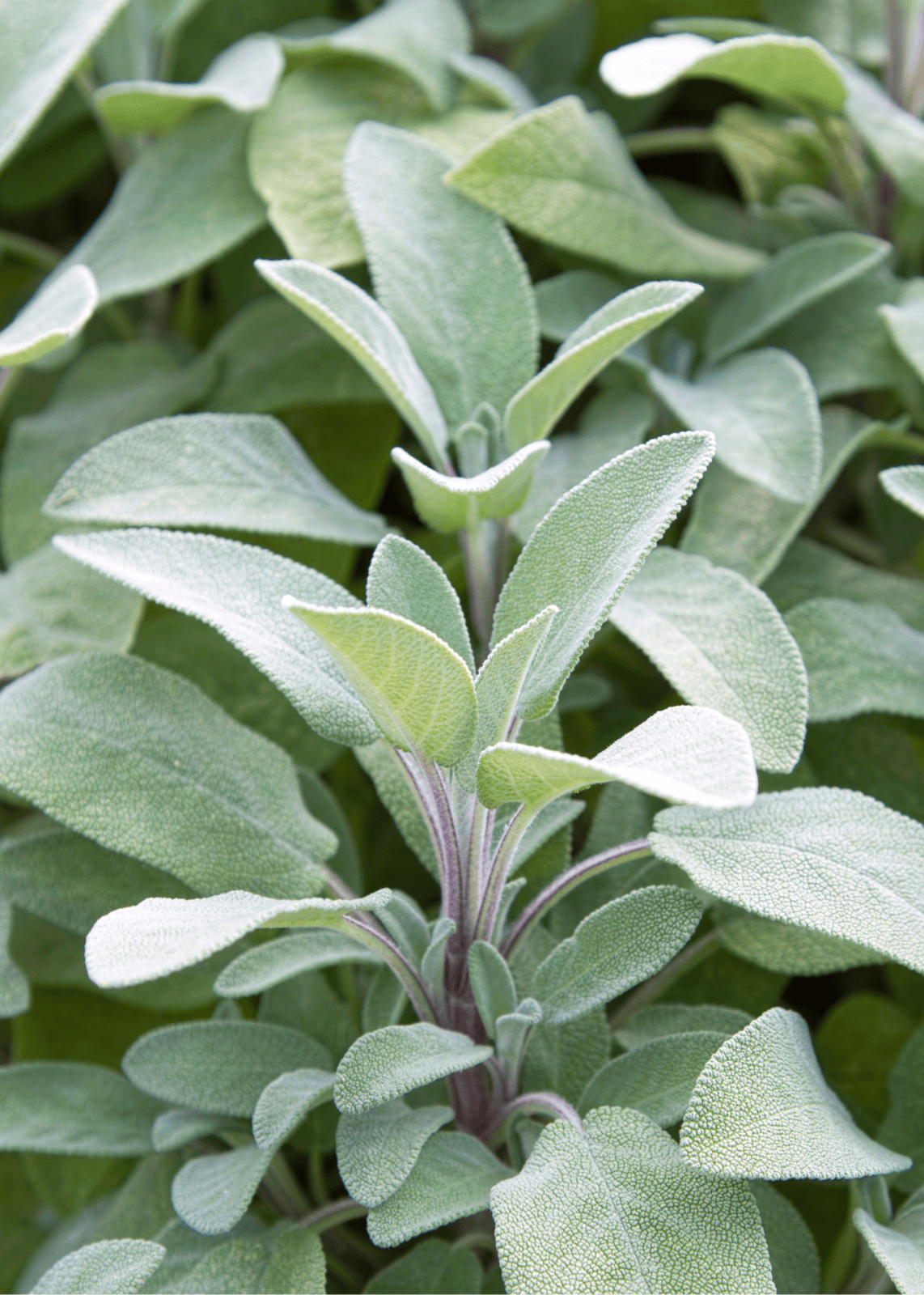
Sage
Salvia officinalis (Lamiaceae)
Sage is a powerful medicinal herb with a wide range of effects, useful for both relieving digestive disorders such as heartburn and bloating, and relieving excessive sweating. It helps relieve inflammation of the mouth and throat, as well as relieves mild skin irritations and inflammations. Sage leaves support women during the menstrual cycle by helping to reduce menstrual cramps, regulate the cycle, and balance hormonal fluctuations due to their spasmolytic and phytoestrogenic properties. Sage is especially valuable for women during menopause, as its phytoestrogenic properties help balance hormones and reduce symptoms such as hot flashes and increased sweating. Sage is useful for women who want to wean their child from breastfeeding, as it helps reduce milk production.
Health benefits: woman's cycle, during weaning, menopause, digestion, skin and mucous membrane health.
Chemical compounds: sage leaves contain essential oil, which contains thujone, cineole, camphor, pinene and other terpenoids, flavonoids, bitter compounds, triterpenic acids, polysaccharides.
Herbal action: antiseptic, antispasmodic, anti-inflammatory, astringent, choleretic, digestion-enhancing, analgesic, estrogenic, strengthening the nervous system, and reducing the secretion of sweat, mammary and salivary glands.- European Medicines Agency. (2016). Final European Union Herbal Monograph on Salvia officinalis L., folium (revision 1). Retrieved from https://www.ema.europa.eu/en/documents/herbal-monograph/final-european-union-herbal-monograph-salvia-officinalis-l-folium-revision-1_en.pdf
- ESCOP. (2003). Salviae folium – Sage Leaf: ESCOP Monographs. The Scientific Foundation for Herbal Medicinal Products (2nd ed.). Exeter, UK: European Scientific Cooperative on Phytotherapy.
- Romm, A. (2017). Botanical Medicine for Women's Health (2nd ed.). St. Louis, MO: Elsevier.
- Drugs and Lactation Database (LactMed®) [Internet]. Bethesda (MD): National Institute of Child Health and Human Development; 2006-. Sage. [Updated 2024 Nov 15]. Available from: https://www.ncbi.nlm.nih.gov/sites/books/NBK501816/
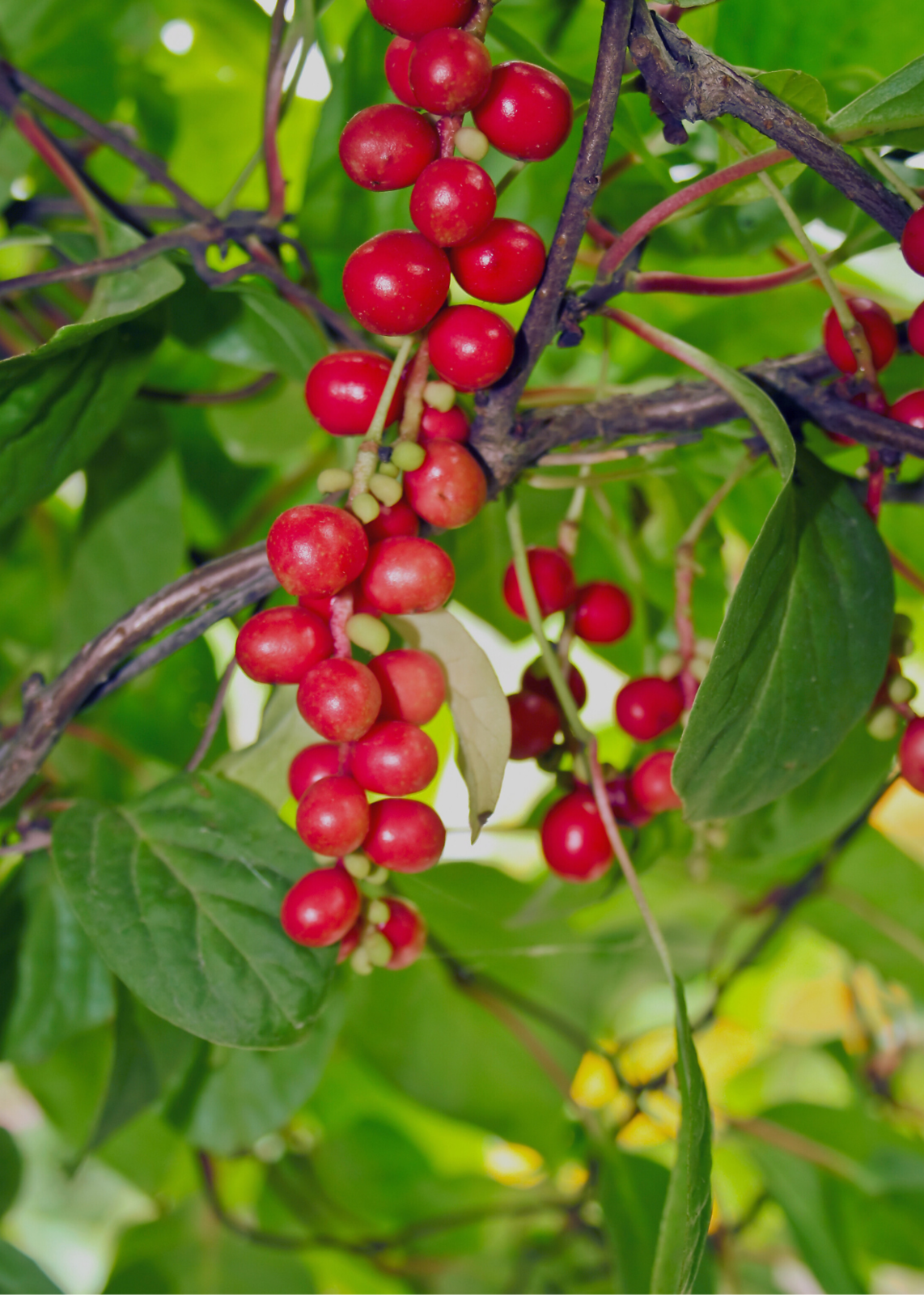
Schisandra
Schisandra chinensis (Schisandraceae)
Health benefits: woman’s cycle, menopause, nervous system, immune defenses, liver health.
Chemical compounds: the fruits contain lignans (schisandrin, schisandrol, and others), essential oil, phytosterols, flavonoids, mucilage, ascorbic acid, organic acids, tannins, and minerals.
Herbal action: tonic, enhancing physical and mental endurance, stimulating heart function, blood circulation, respiration, the central nervous system, and libido.- Romm, A. (2017). Botanical Medicine for Women's Health (2nd ed.). St. Louis, MO: Elsevier.
- Kopustinskiene DM, Bernatoniene J. Antioxidant Effects of Schisandra chinensis Fruits and Their Active Constituents. Antioxidants. 2021; 10(4):620. https://doi.org/10.3390/antiox10040620
- Panossian A, Wikman G. Evidence-based efficacy of adaptogens in fatigue, and molecular mechanisms related to their stress-protective activity. Curr Clin Pharmacol. 2009 Sep;4(3):198-219. doi: 10.2174/157488409789375311. Epub 2009 Sep 1. PMID: 19500070.
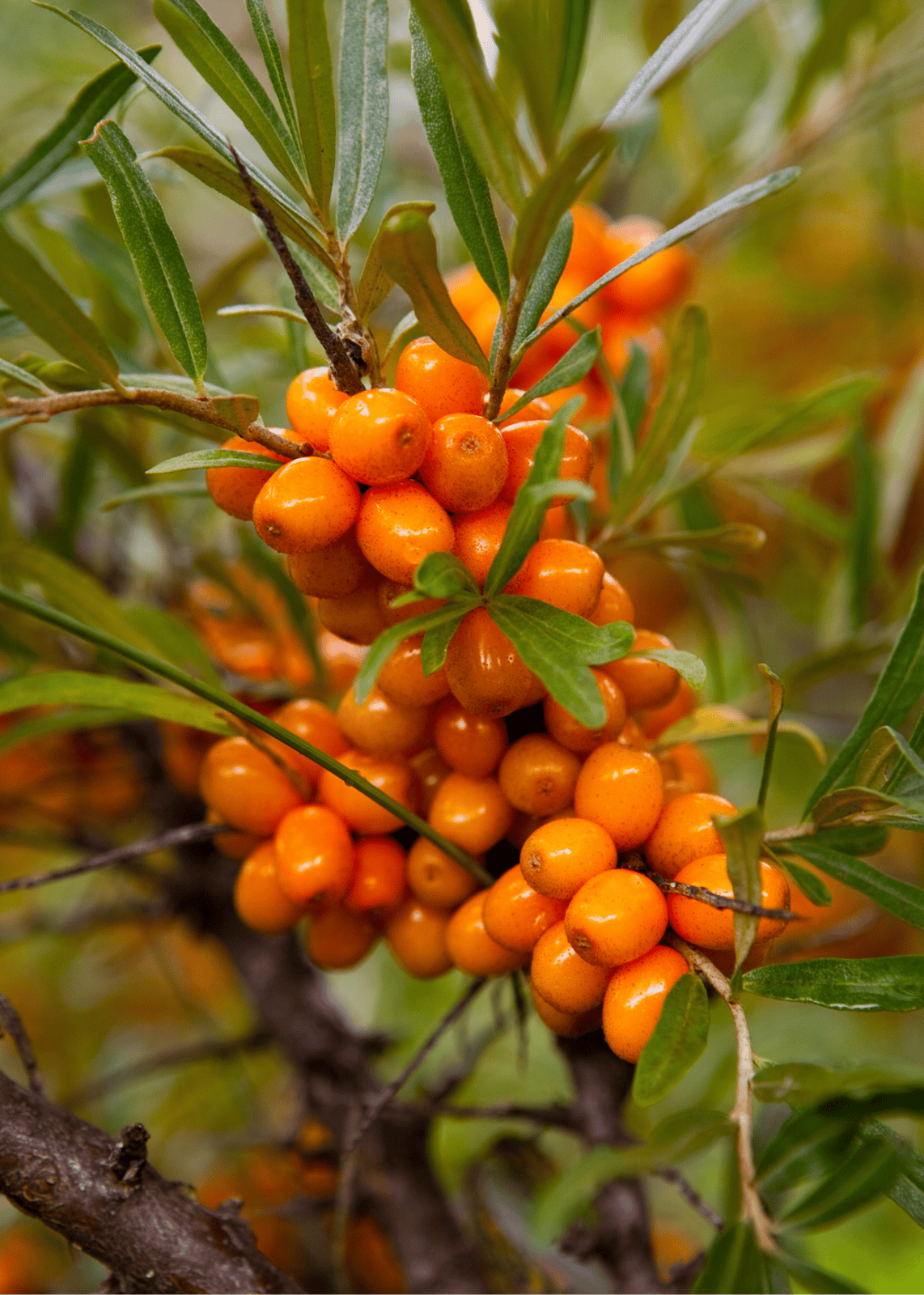
Sea buckthorn
Hippophaë rhamnoides (Elaeagnaceae)
Sea buckthorn leaves help protect cells from oxidative stress and reduce inflammation. The fruits, rich in vitamin C and carotenoids, strengthen the immune system, improve skin health, and promote tissue regeneration. Additionally, sea buckthorn fruits may help regulate cholesterol levels and support cardiovascular health. Combining the benefits of both leaves and fruits, sea buckthorn provides versatile health support by promoting body renewal and defense against adverse environmental factors.
Health benefits: immunity, skin health.
Chemical compounds: the leaves contain flavonoids, tannins, and minerals. The fruits contain B vitamins (B1, B2, B12), vitamins E and K, ascorbic acid, oil, sugars, pectins, flavonoids, organic acids, and tannins.
Herbal action: the leaves have anti-inflammatory and astringent effects. The fruits exhibit anti-inflammatory, antibacterial, astringent, analgesic, and anti-sclerotic properties. They promote wound, ulcer, and inflammation healing, enhance tissue regeneration, and strengthen the body’s immune defenses.- Jaśniewska A, Diowksz A. Wide Spectrum of Active Compounds in Sea Buckthorn (Hippophae rhamnoides) for Disease Prevention and Food Production. Antioxidants (Basel). 2021 Aug 12;10(8):1279. doi: 10.3390/antiox10081279. PMID: 34439527; PMCID: PMC8389226.
- Mishra KP, Chanda S, Karan D, Ganju L, Sawhney RC. Effect of Seabuckthorn (Hippophae rhamnoides) flavone on immune system: an in-vitro approach. Phytother Res. 2008 Nov;22(11):1490-5. doi: 10.1002/ptr.2518. PMID: 18570236.
- American Botanical Council. Sea Buckthorr. In Commission E Monographs. Retrieved from https://www.herbalgram.org/resources/herbalgram/issues/78/table-of-contents/article3247/
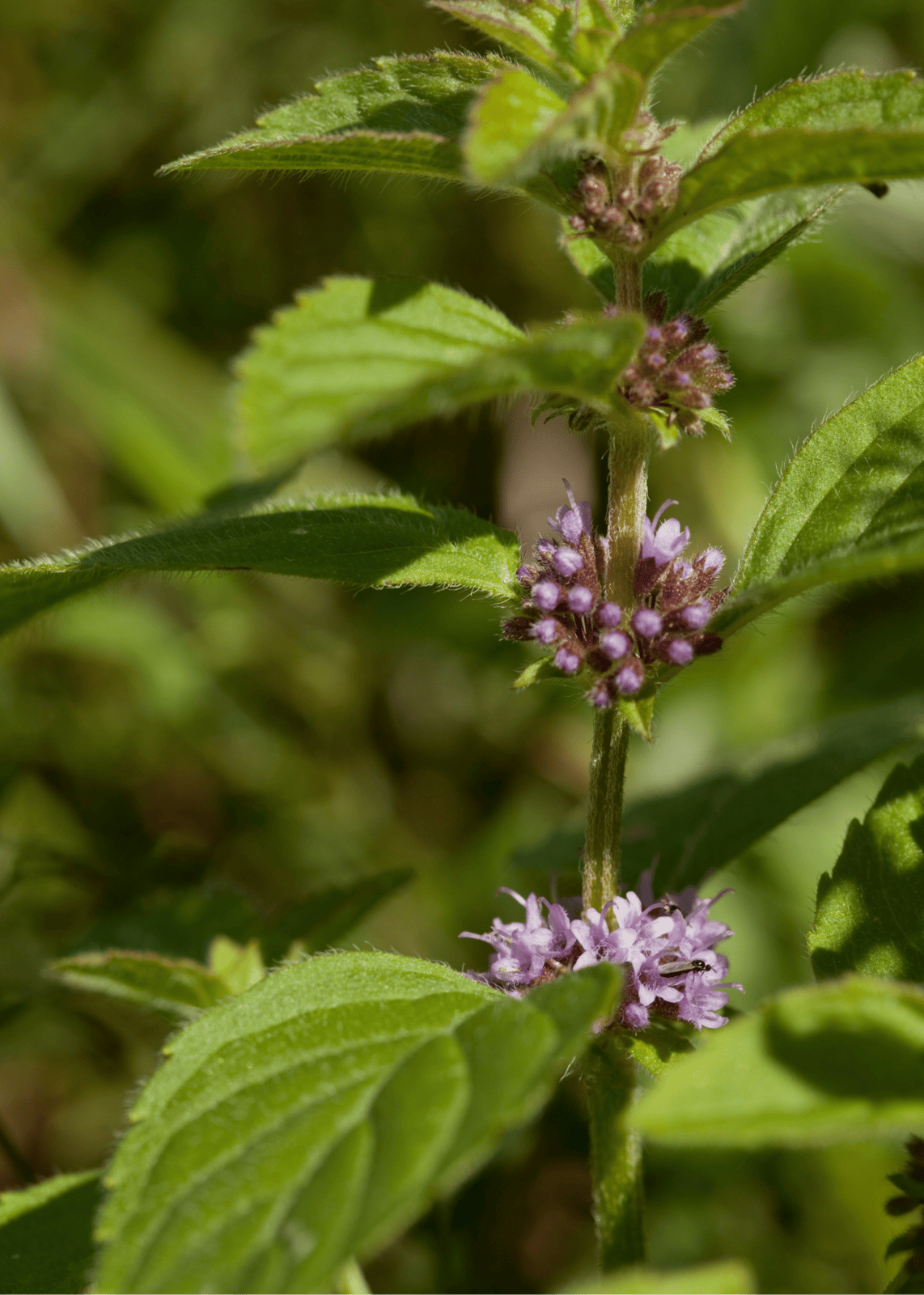
Spearmint
Mentha spicata (Lamiaceae)
Health benefits: woman’s cycle, nervous system, digestion, respiratory tract.
Chemical compounds: the leaves contain essential oil, flavonoids, phenolic acids, and triterpenes.
Herbal action: calming, digestion-enhancing, spasmolytic, anti-inflammatory, antibacterial, antioxidant, and hormone-balancing effects.- Romm, A. (2017). Botanical Medicine for Women's Health (2nd ed.). St. Louis, MO: Elsevier.
- Mahendran G, Verma SK, Rahman LU. The traditional uses, phytochemistry and pharmacology of spearmint (Mentha spicata L.): A review. J Ethnopharmacol. 2021 Oct 5;278:114266. doi: 10.1016/j.jep.2021.114266. Epub 2021 Jun 1. PMID: 34087400.
- Grant P. Spearmint herbal tea has significant anti-androgen effects in polycystic ovarian syndrome. A randomized controlled trial. Phytother Res. 2010 Feb;24(2):186-8. doi: 10.1002/ptr.2900. PMID: 19585478.
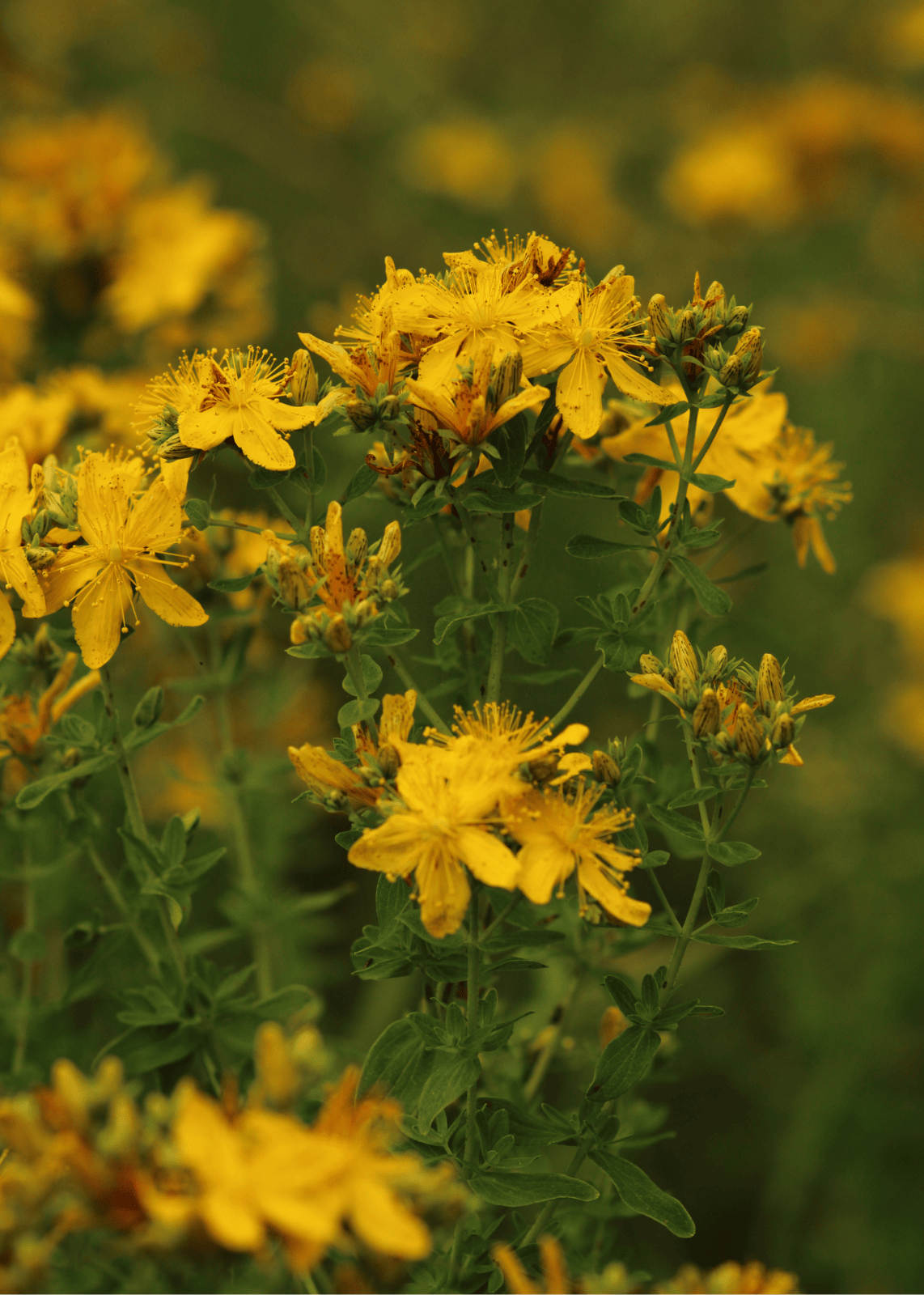
St. John's wort
Hypericum perforatum (Hypericaceae))
Health benefits: nervous system, digestion, skin health.
Chemical compounds: St. John's wort leaves contain hypericin, pseudohypericin, hyperforin, tannins and flavonoids.
Herbal action: antidepressant, anti-inflammatory, astringent, antibacterial, antispasmodic.- European Medicines Agency. (2018). Final European Union herbal monograph on Hypericum perforatum L., herba (revision 1). Retrieved from https://www.ema.europa.eu/en/documents/herbal-monograph/final-european-union-herbal-monograph-hypericum-perforatum-l-herba-revision-1_en.pdf
- European Scientific Cooperative on Phytotherapy. (2018). Hypericum perforatum: St. John's wort. Retrieved from https://www.escop.com/downloads/hypericum-2018/
- American Botanical Council. (n.d.). St. John's Wort. In Commission E Monographs. Retrieved from https://www.herbalgram.org/resources/commission-e-monographs/monograph-approved-herbs/st-johns-wort/
- Romm, A. (2017). Botanical Medicine for Women's Health (2nd ed.). St. Louis, MO: Elsevier.
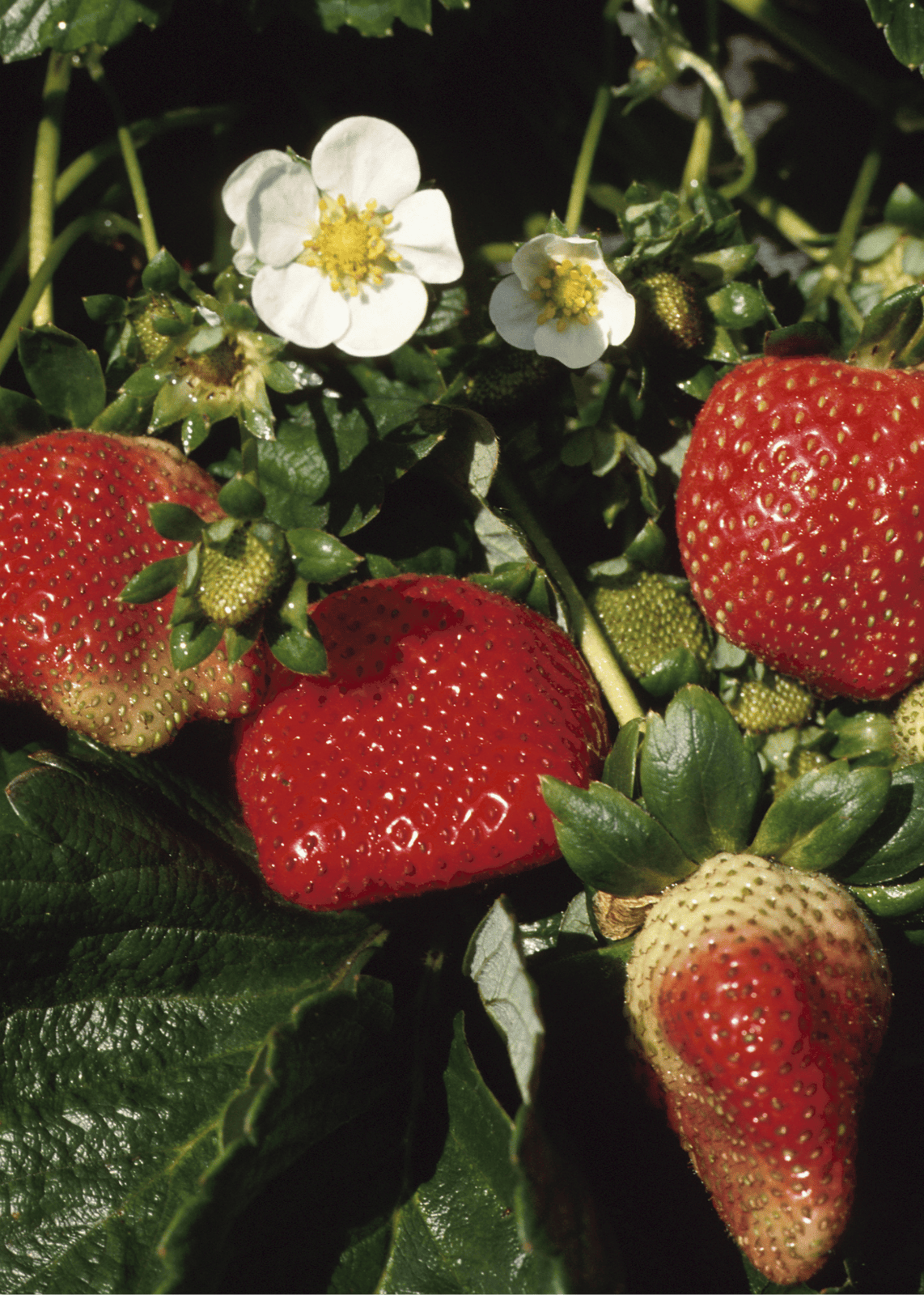
Strawberry
Fragaria × ananassa (Rosaceae)
Health benefits: valuable source of minerals and vitamins, digestion, detoxification.
Chemical compounds: flavonoids, phenolic acids, fiber, vitamins (C, B vitamins), minerals (K, Mg, Fe).
Herbal action: anti-inflammatory, diuretic, digestion-enhancing, immune-boosting, and antioxidant effects.- Basu A, Izuora K, Betts NM, Kinney JW, Salazar AM, Ebersole JL, Scofield RH. Dietary Strawberries Improve Cardiometabolic Risks in Adults with Obesity and Elevated Serum LDL Cholesterol in a Randomized Controlled Crossover Trial. Nutrients. 2021 Apr 23;13(5):1421. doi: 10.3390/nu13051421. PMID: 33922576; PMCID: PMC8145532.
- American Botanical Council. (2015). Food as Medicine: Strawberry (Fragaria ananassa, Rosaceae). HerbalEGram, 12(5). Retrieved from https://www.herbalgram.org/resources/herbalegram/volumes/volume-12/number-5-may/food-as-medicine-strawberry-fragaria-ananassa-rosaceae/food-as-medicine-strawberry/
- Miller K, Feucht W, Schmid M. Bioactive Compounds of Strawberry and Blueberry and Their Potential Health Effects Based on Human Intervention Studies: A Brief Overview. Nutrients. 2019 Jul 2;11(7):1510. doi: 10.3390/nu11071510. PMID: 31269727; PMCID: PMC6683271.
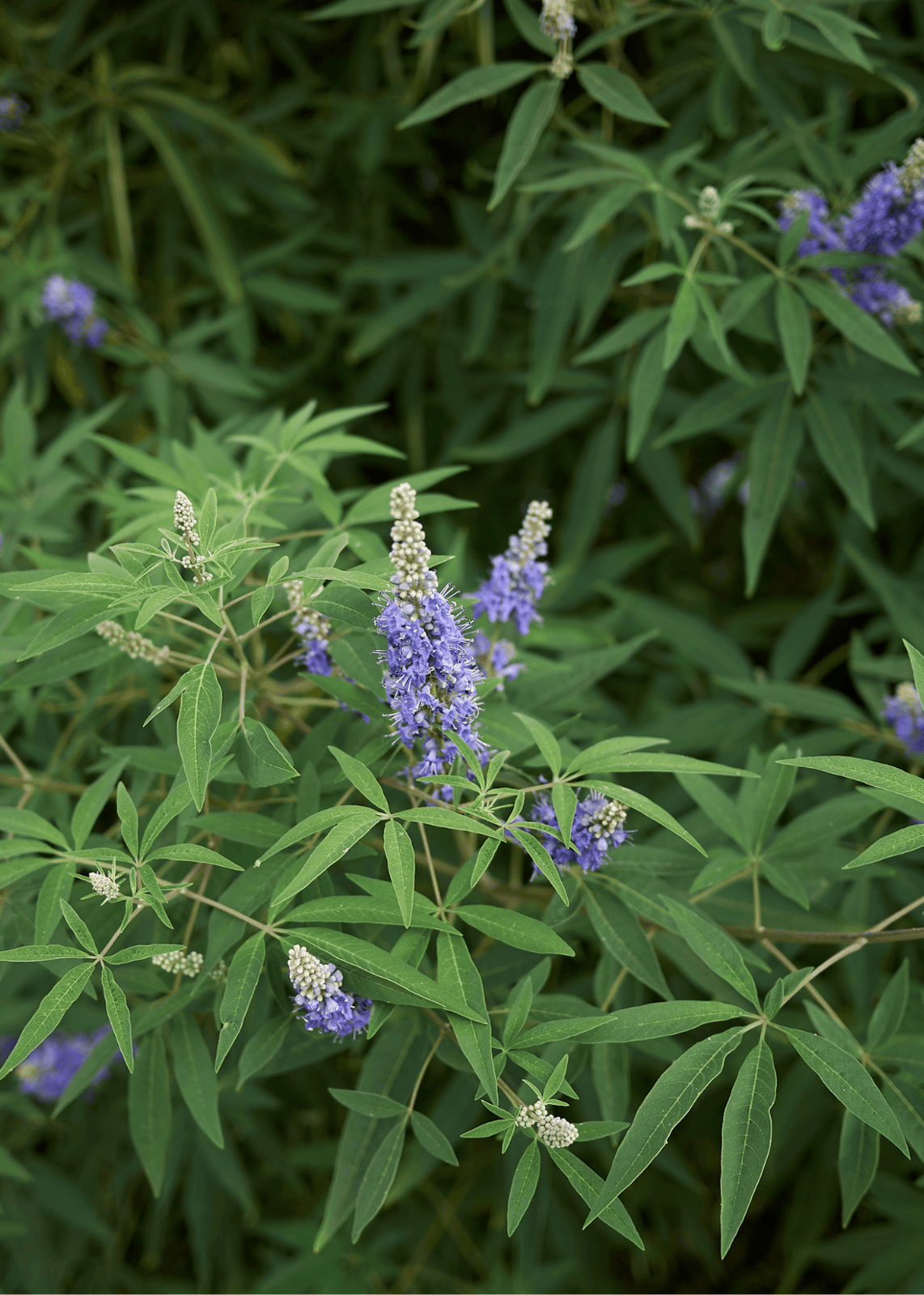
Vitex
Vitex agnus castus (Lamiaceae)
Health benefits: woman’s cycle, menopause.
Chemical compounds: the fruits contain flavonoids, diterpenes, iridoid glycosides, essential oil, and alkaloids.
Herbal action: hormone-balancing, anti-inflammatory, analgesic, nerve-soothing, antibacterial, and antioxidant effects.- World Health Organization. (1999). Vitex agnus-castus L.. In WHO monographs on selected medicinal plants (Vol. 1, pp. 9-29). World Health Organization. Retrieved from https://iris.who.int/bitstream/handle/10665/42052/9789241547055_eng.pdf?sequence=4&isAllowed=y
- European Medicines Agency. (2018). Final European Union herbal monograph on Vitex agnus-castus L., fructus (revision 1). Retrieved from https://www.ema.europa.eu/en/documents/herbal-monograph/final-european-union-herbal-monograph-vitex-agnus-castus-l-fructus-revision-1_en.pdf
- Romm, A. (2017). Botanical Medicine for Women's Health (2nd ed.). St. Louis, MO: Elsevier.
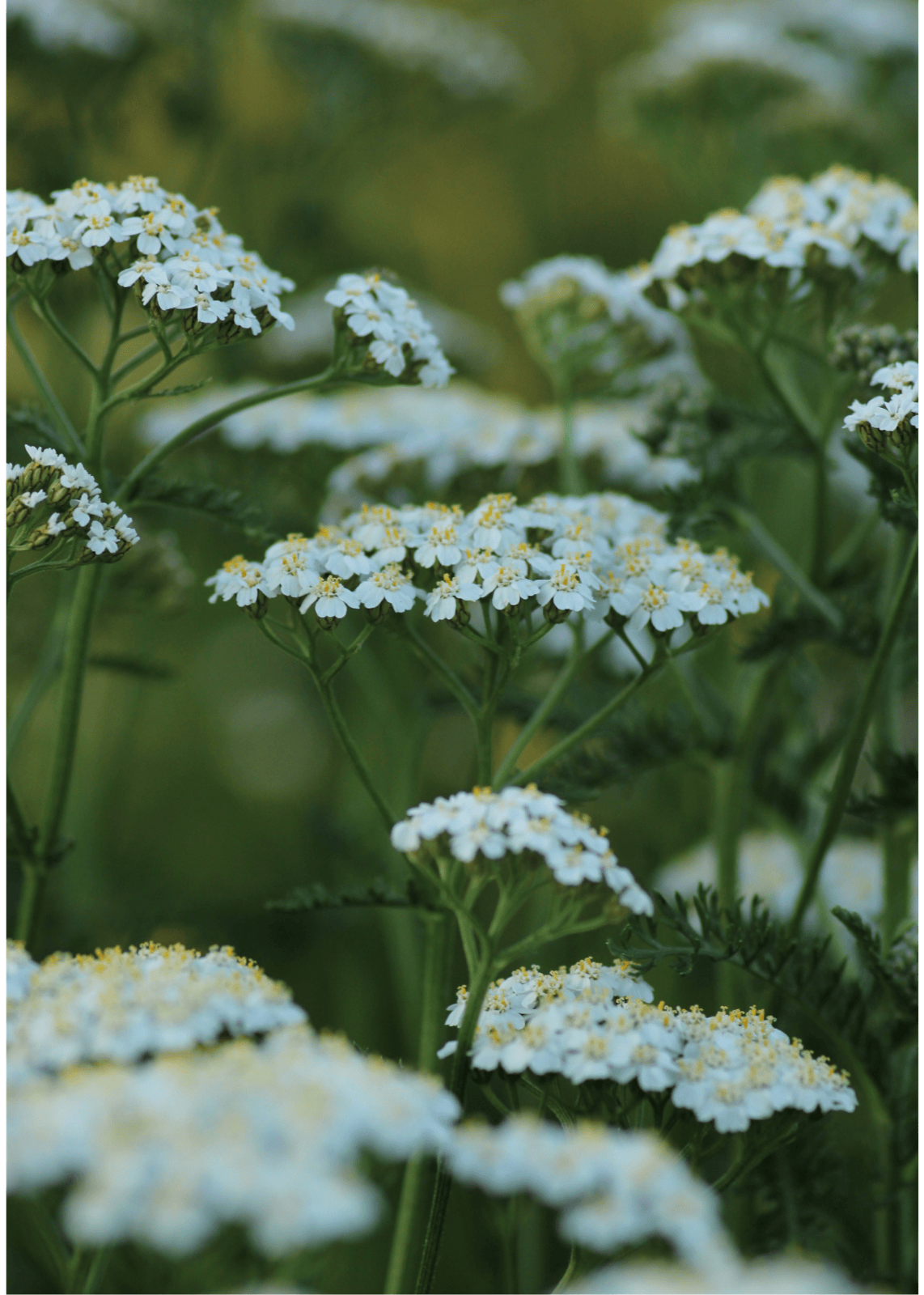
Yarrow
Achillea millefolium (Asteraceae)
Health benefits: woman's cycle, digestion, gynecological health, skin health.
Chemical compounds: yarrow flowers and leaves contain essential oil, flavonoids, coumarins, tannins, and the pyrrolizidine alkaloid achillein.
Herbal action: Anti-inflammatory, hemostatic, antibacterial, antispasmodic, and digestive stimulant.- European Medicines Agency. (2018). Final European Union herbal monograph on Achillea millefolium L., herba (revision 1). Retrieved from https://www.ema.europa.eu/en/documents/herbal-opinion/final-european-union-herbal-monograph-achillea-millefolium-l-herba-revision-1_en.pdf
- Jenabi E, Fereidoony B. Effect of Achillea Millefolium on Relief of Primary Dysmenorrhea: A Double-Blind Randomized Clinical Trial. J Pediatr Adolesc Gynecol. 2015 Oct;28(5):402-4. doi: 10.1016/j.jpag.2014.12.008. Epub 2014 Dec 23. PMID: 26238568.
- European Scientific Cooperative on Phytotherapy. (2003). Millefolii herba: Yarrow. Retrieved from https://www.escop.com/downloads/millefolii-herba-yarrow/
- Romm, A. (2017). Botanical Medicine for Women's Health (2nd ed.). St. Louis, MO: Elsevier.

